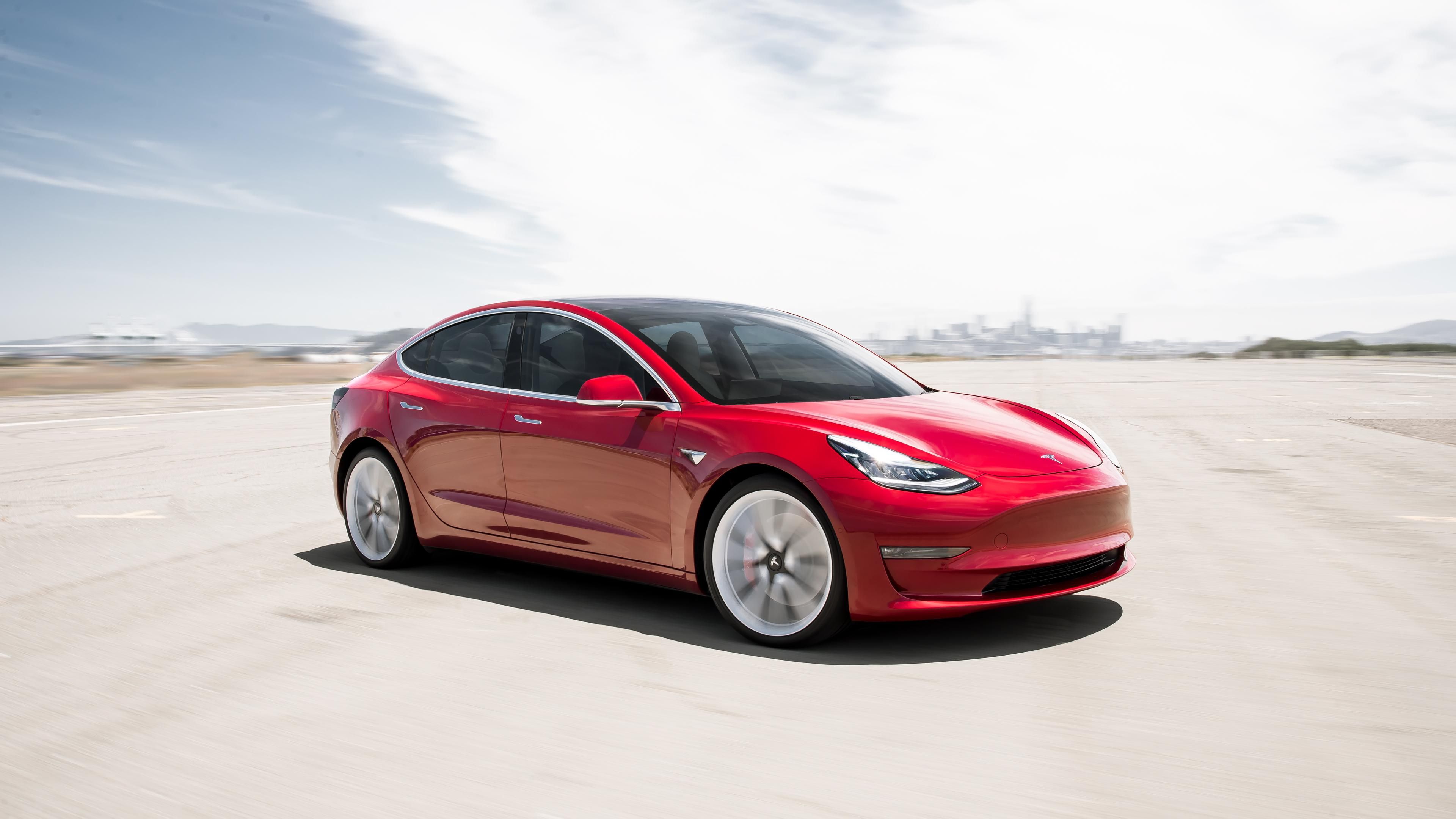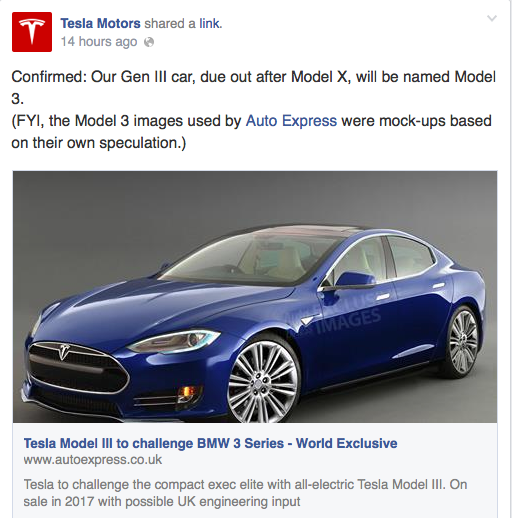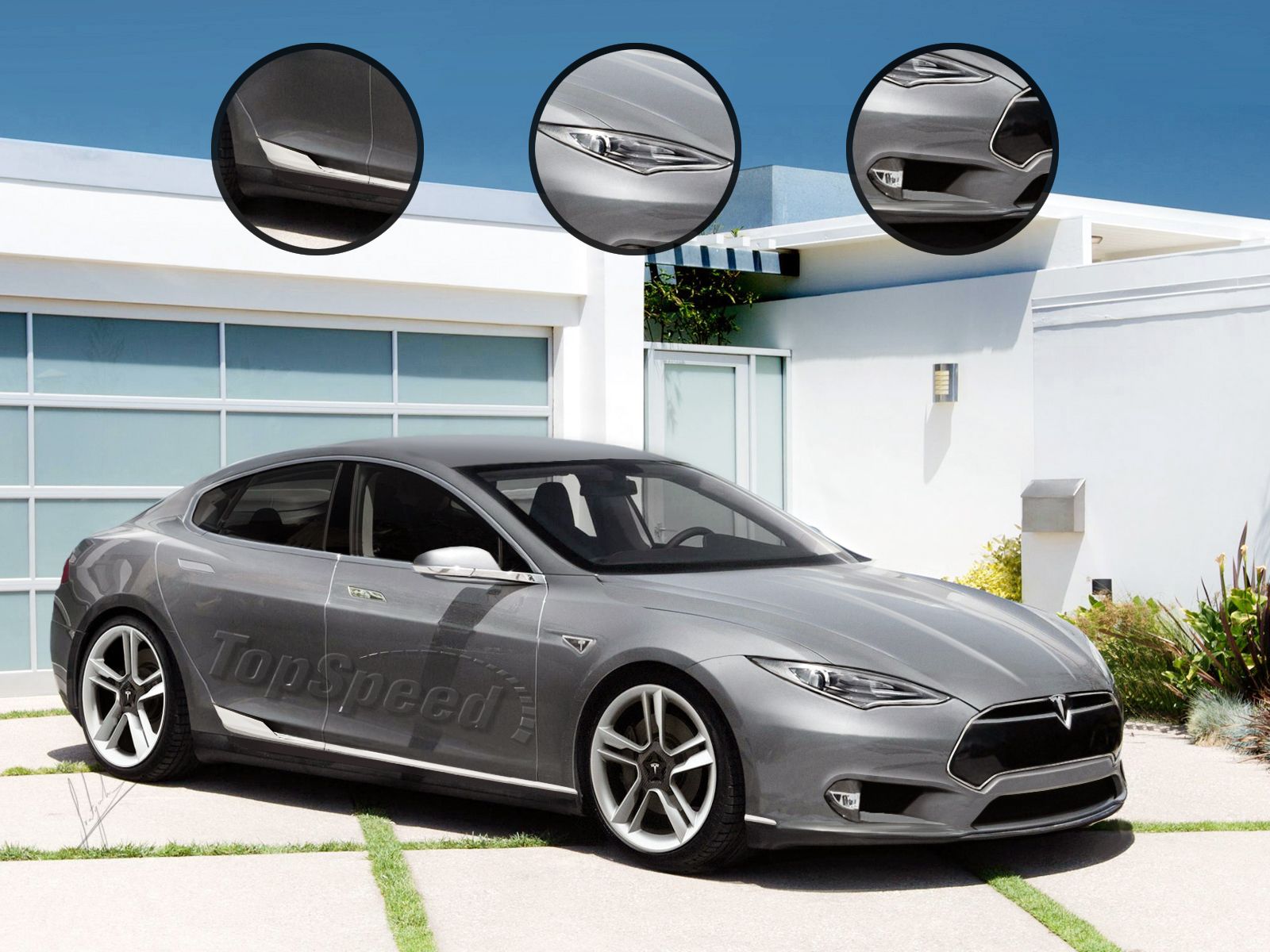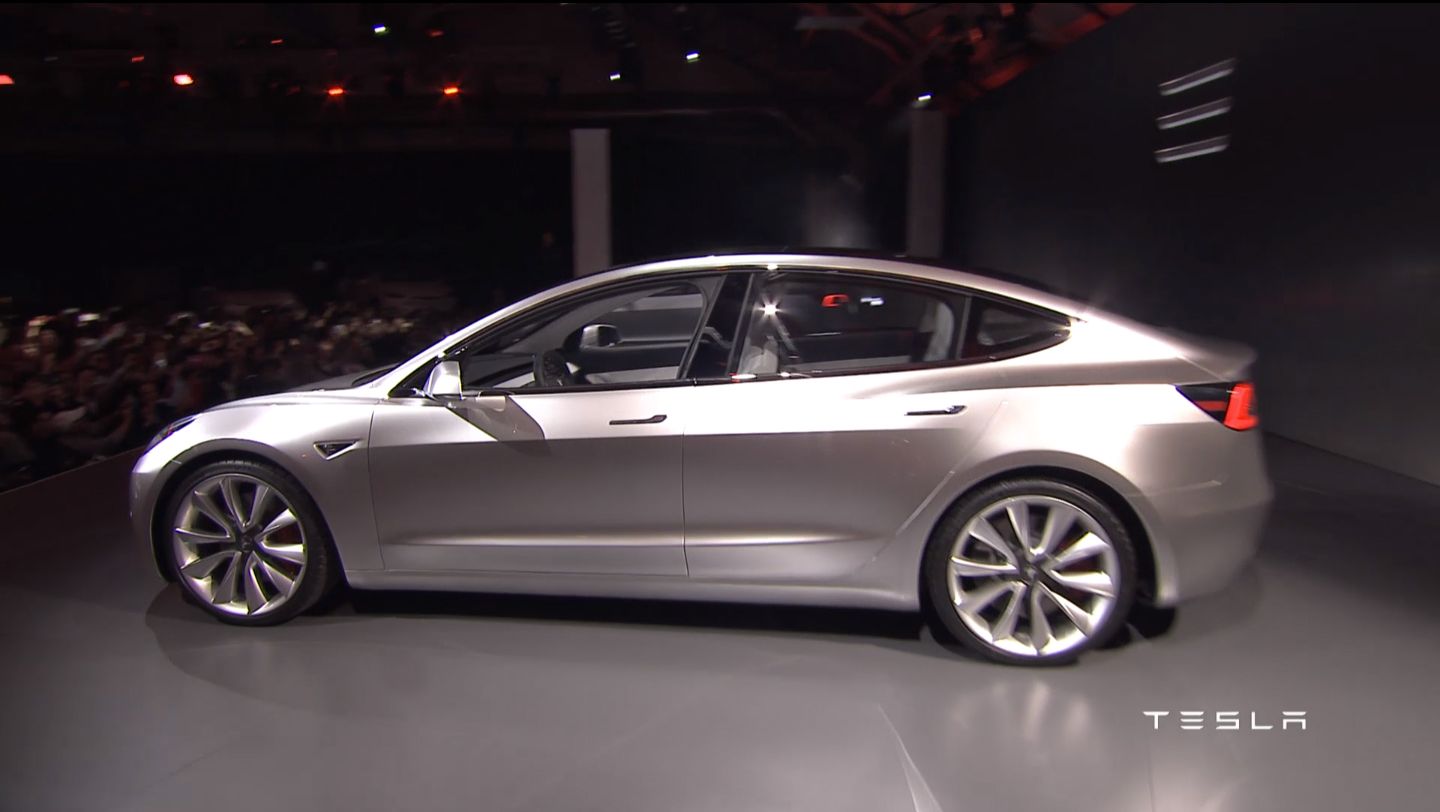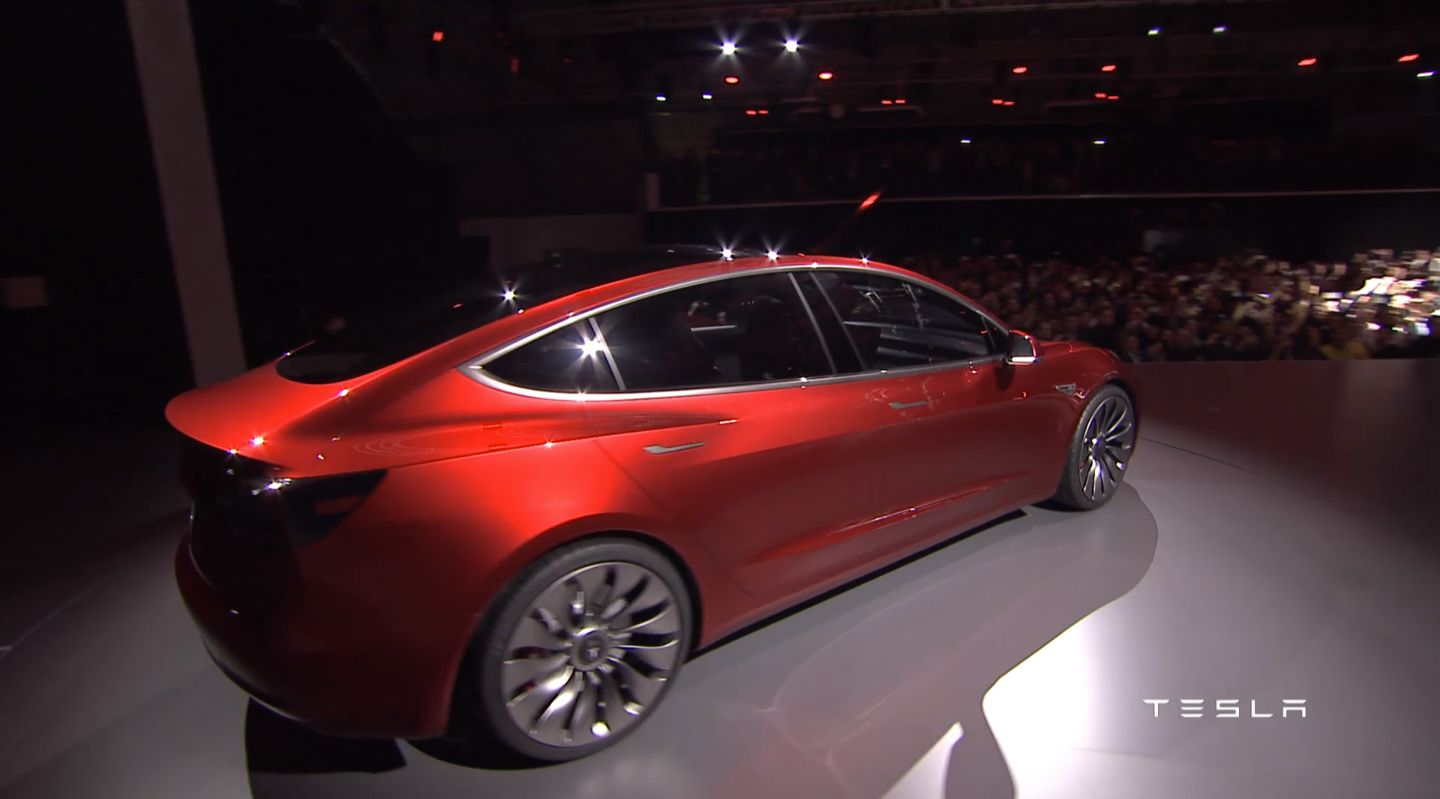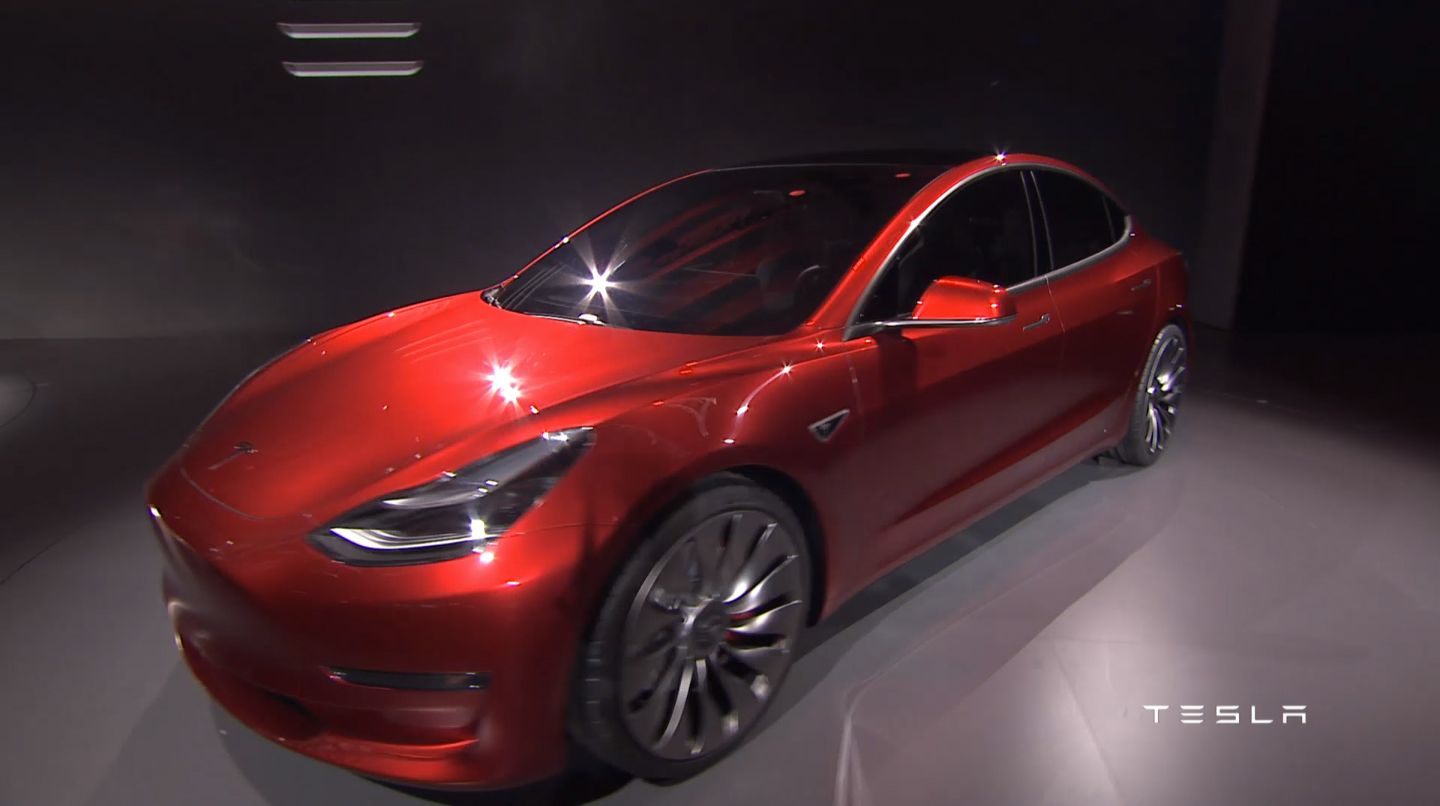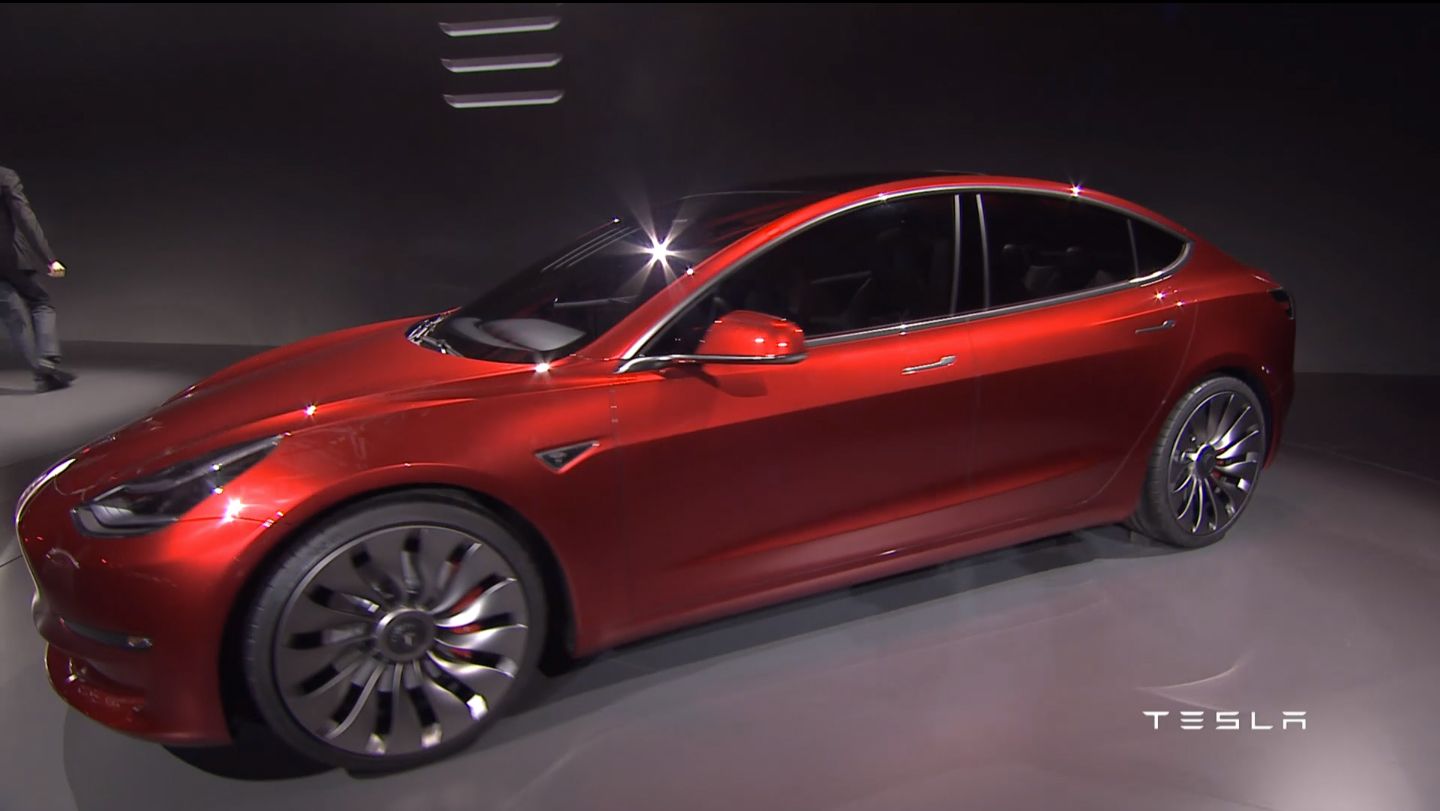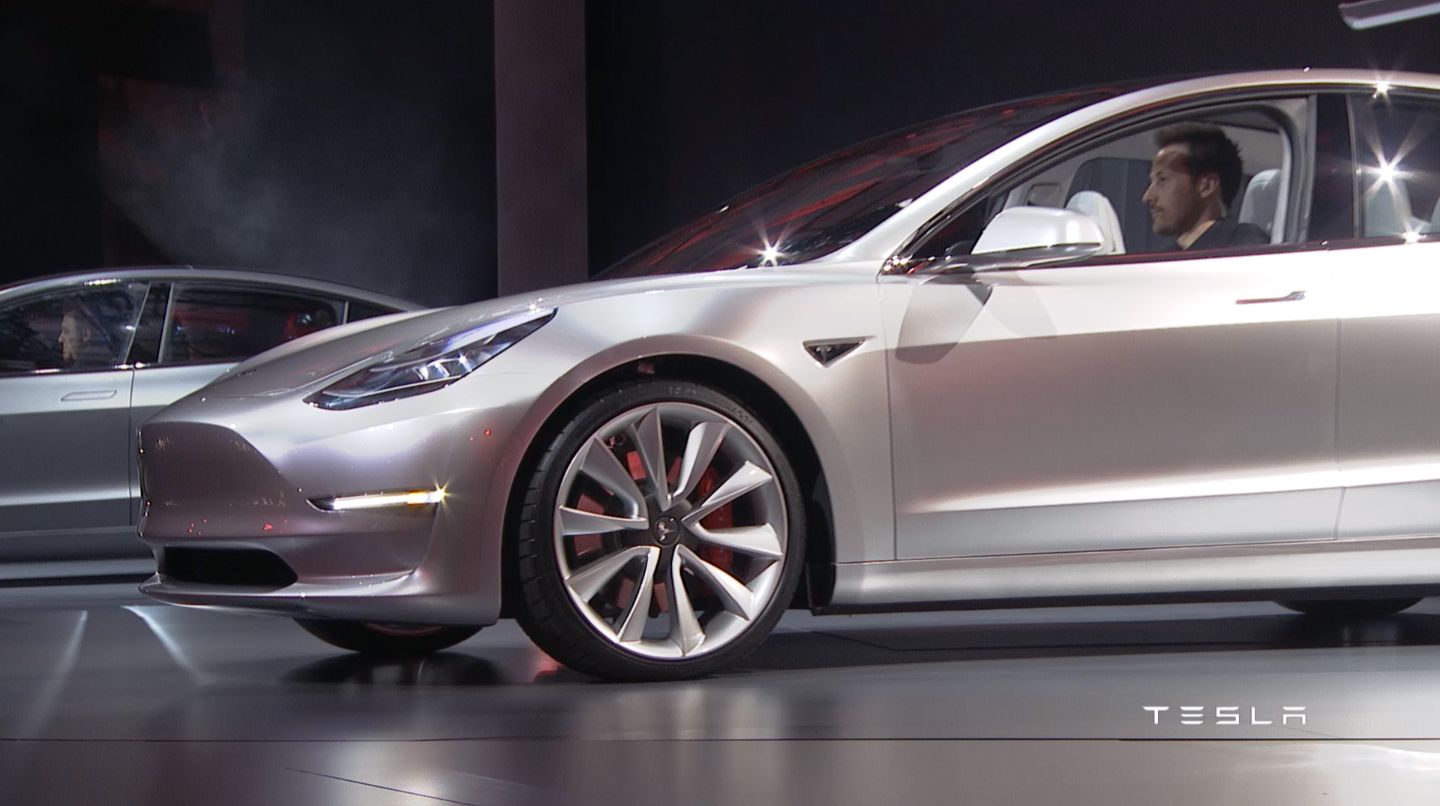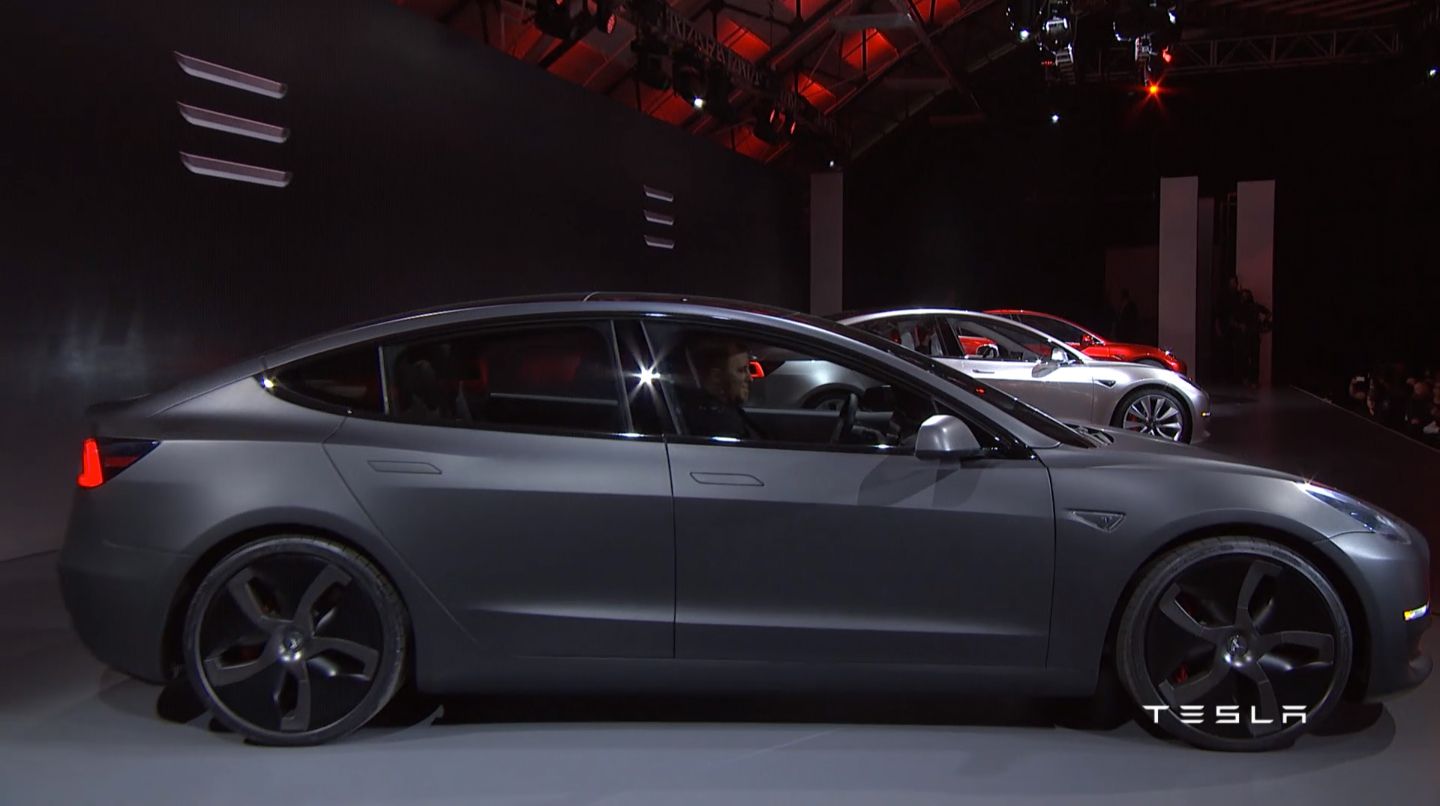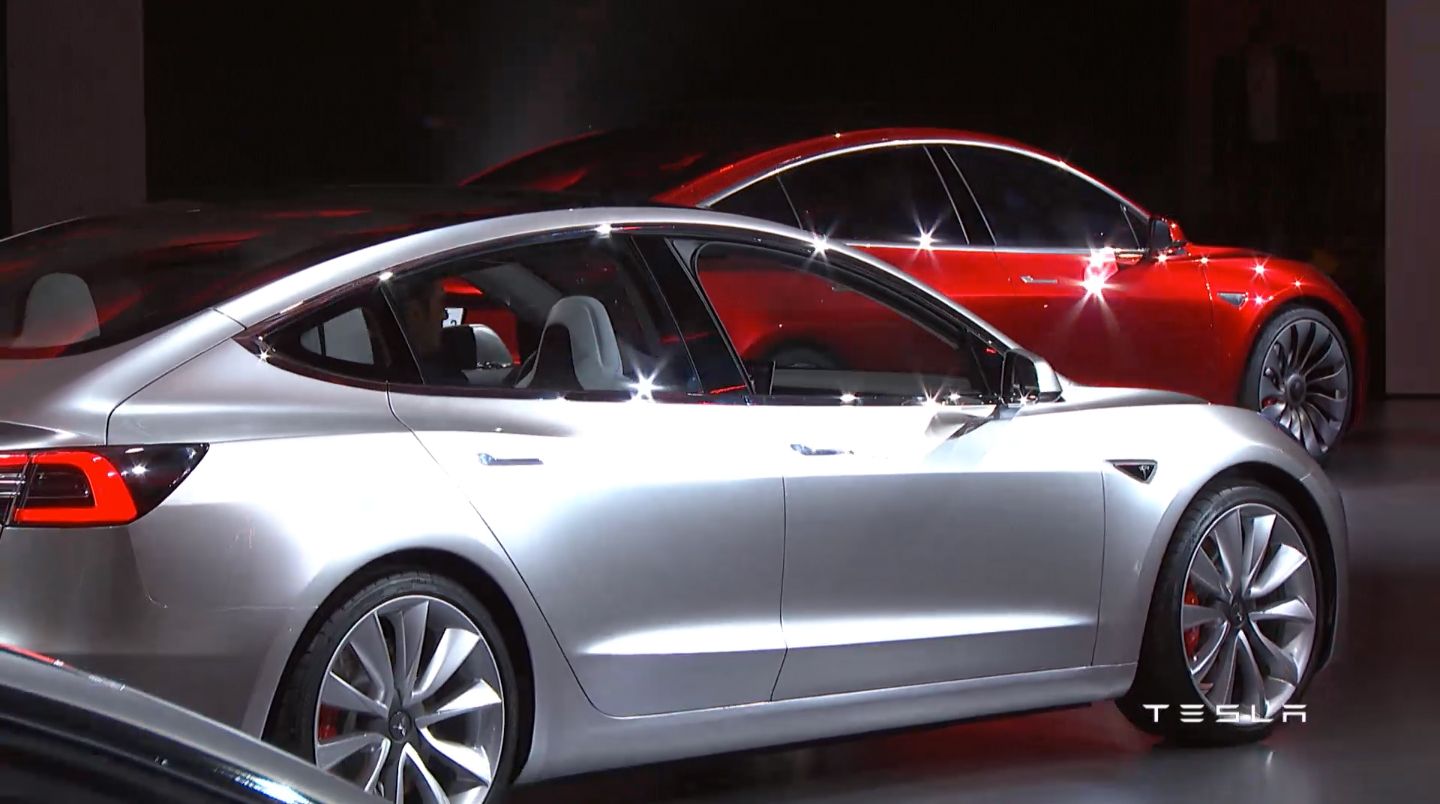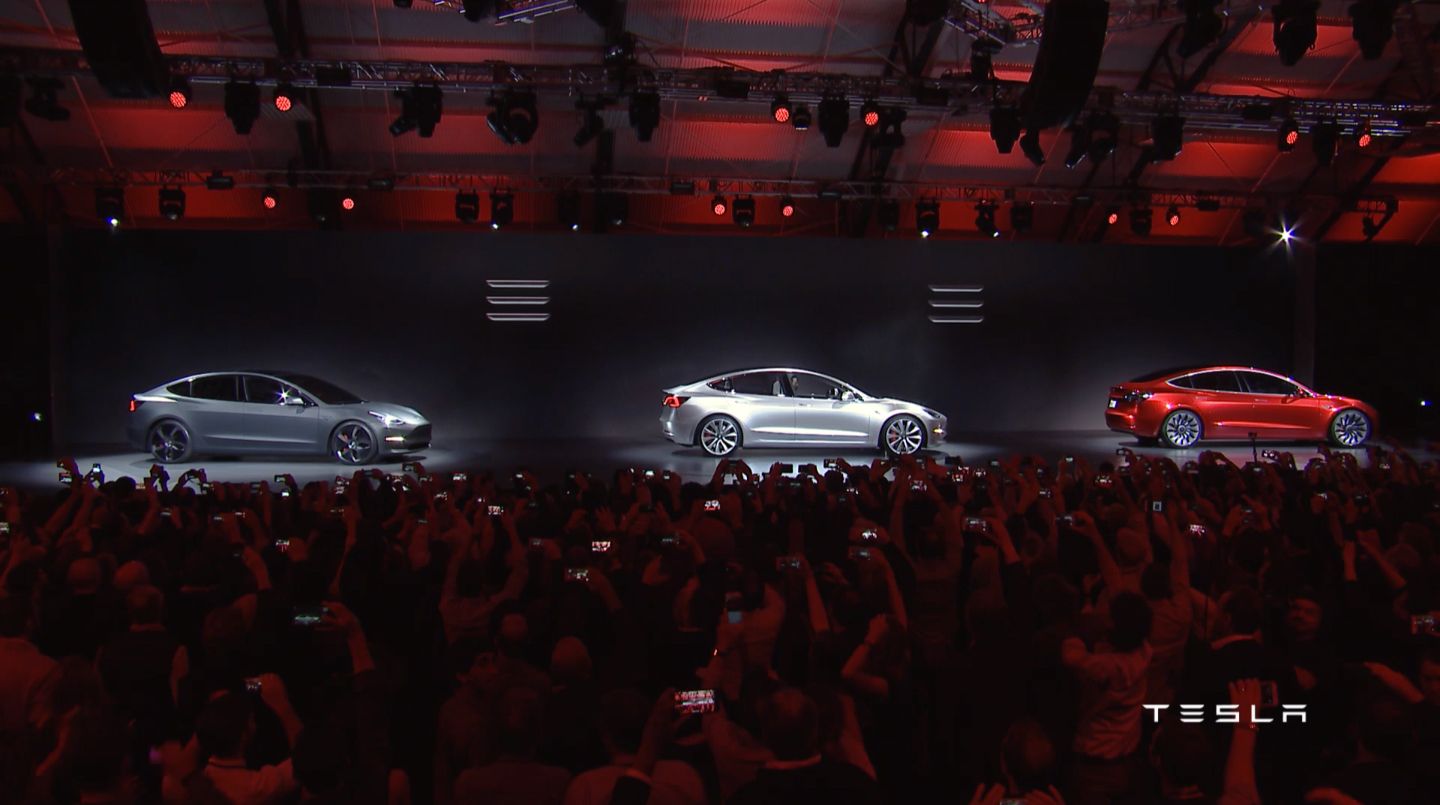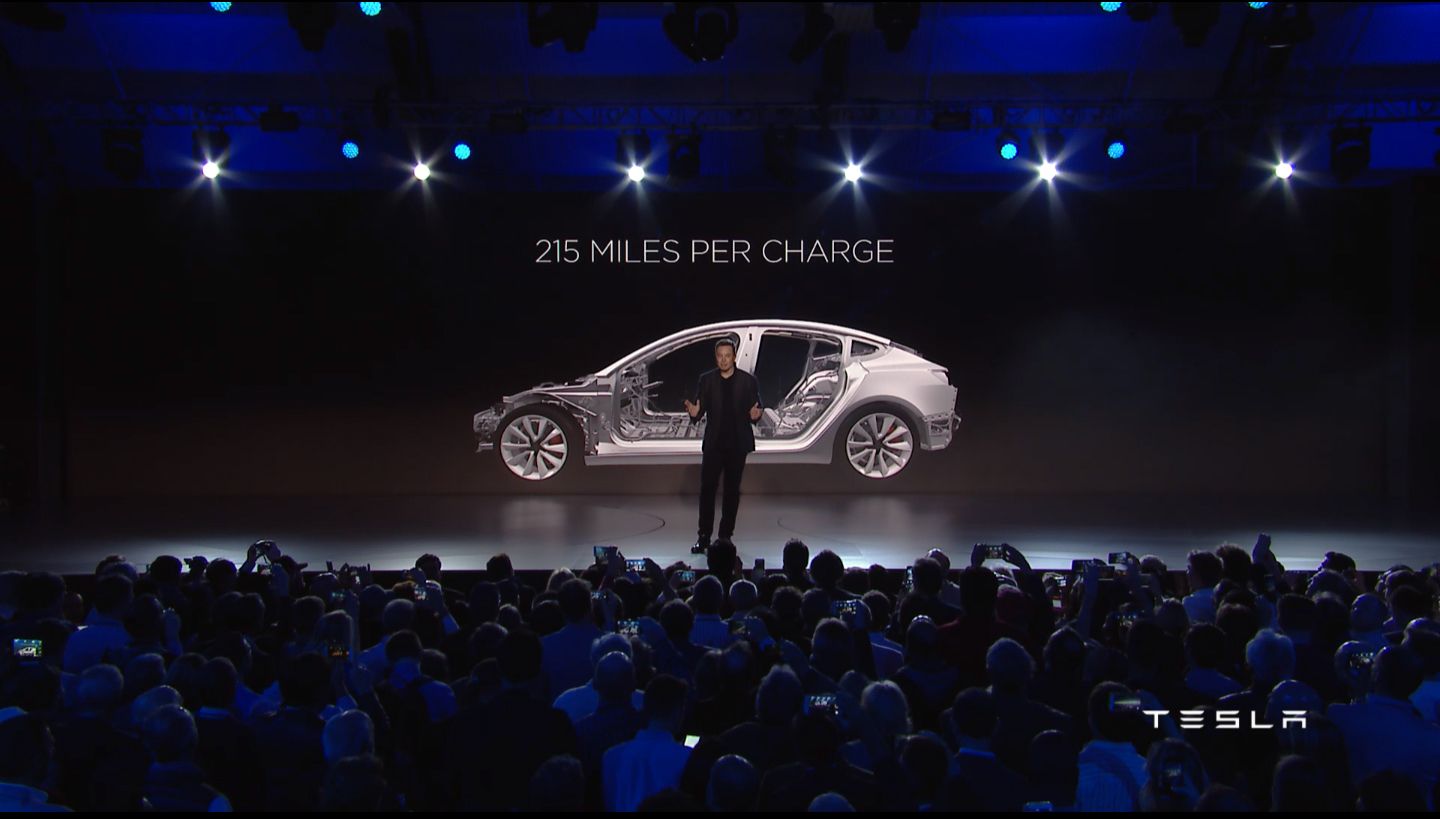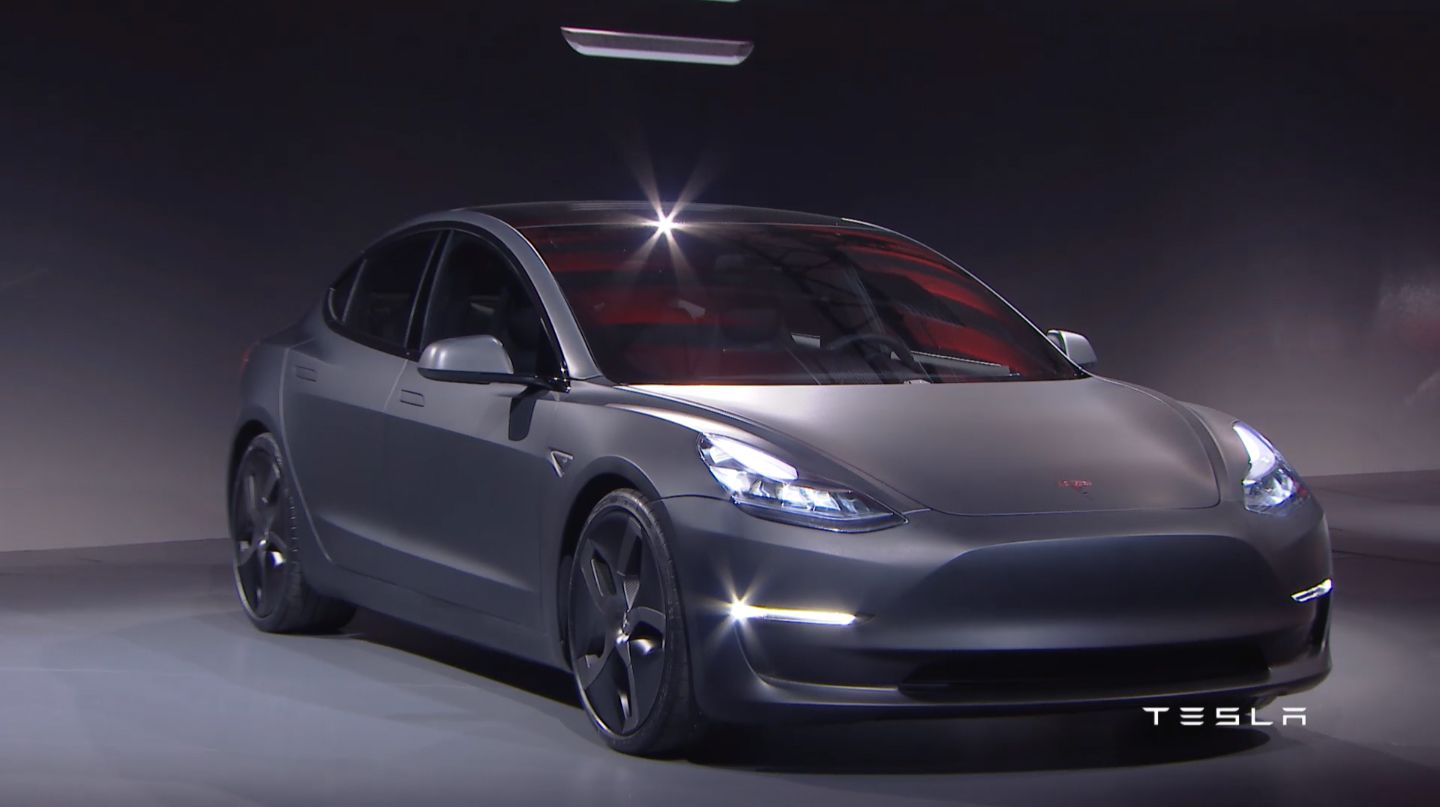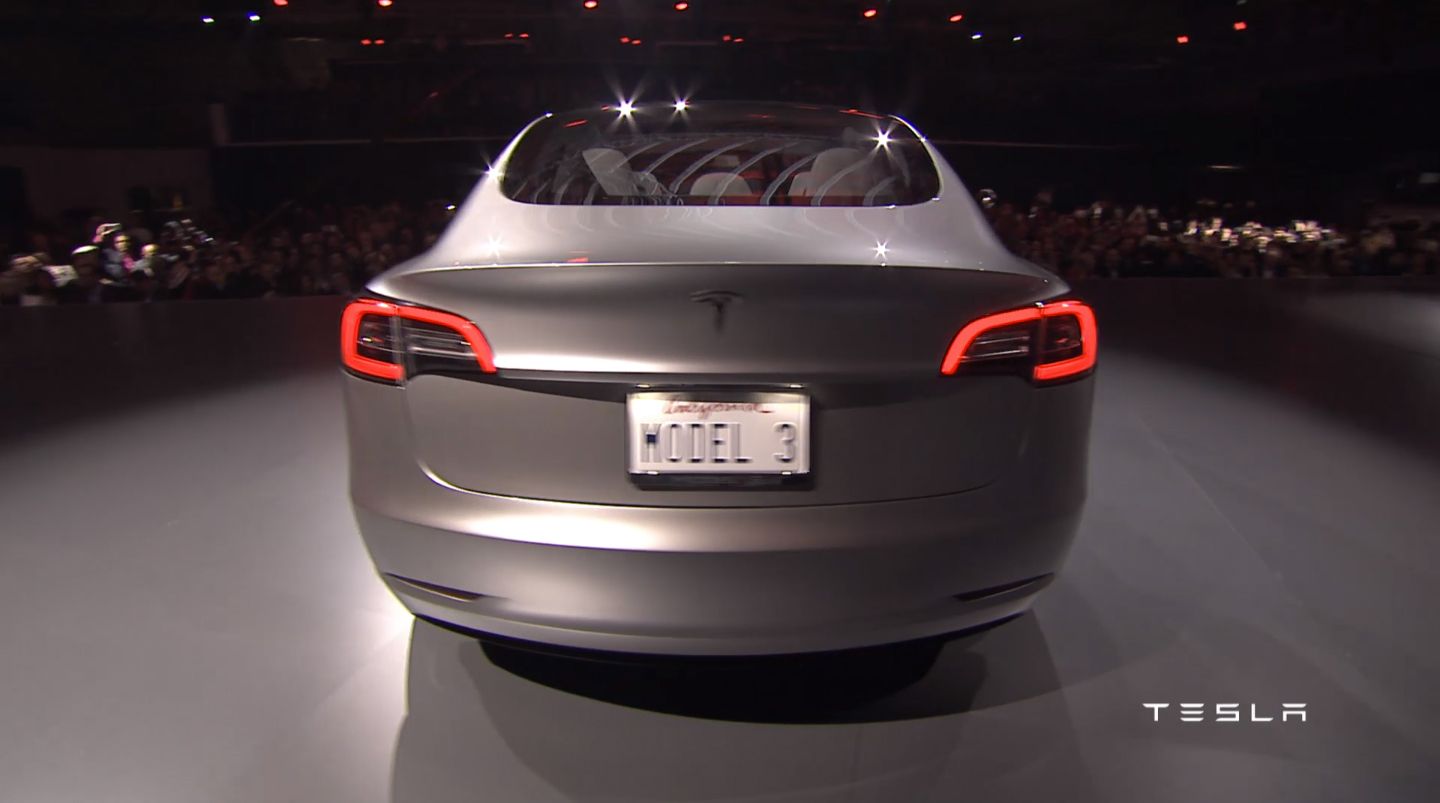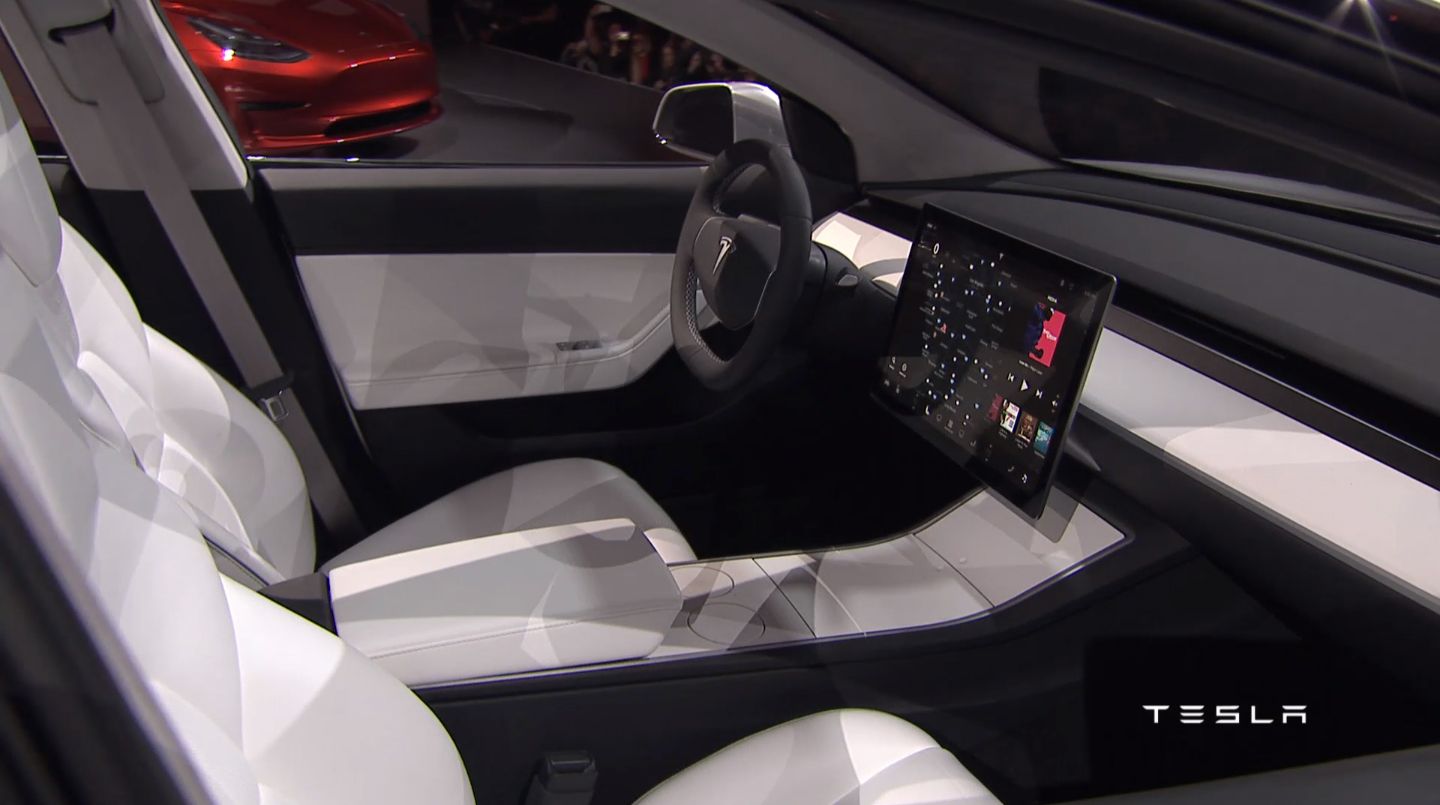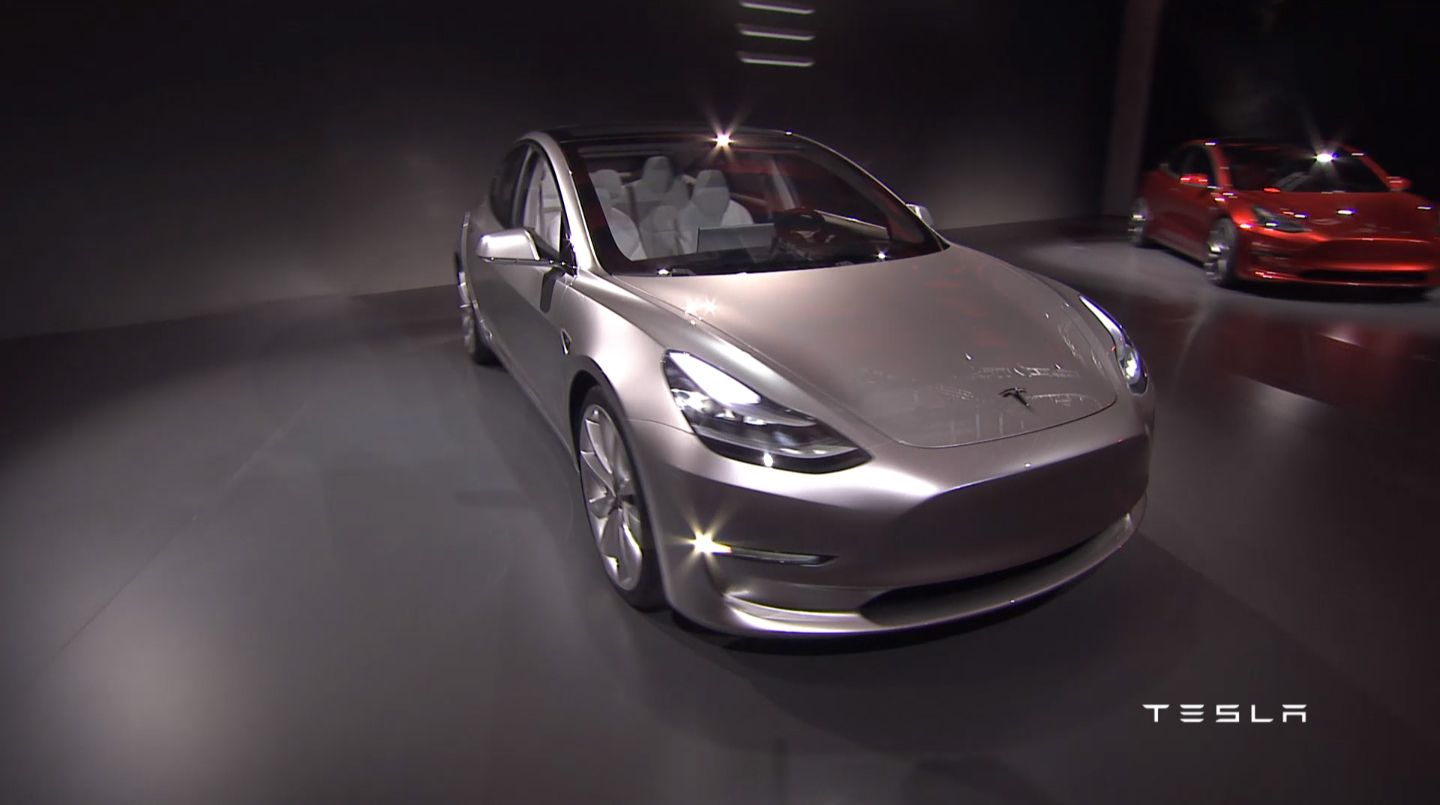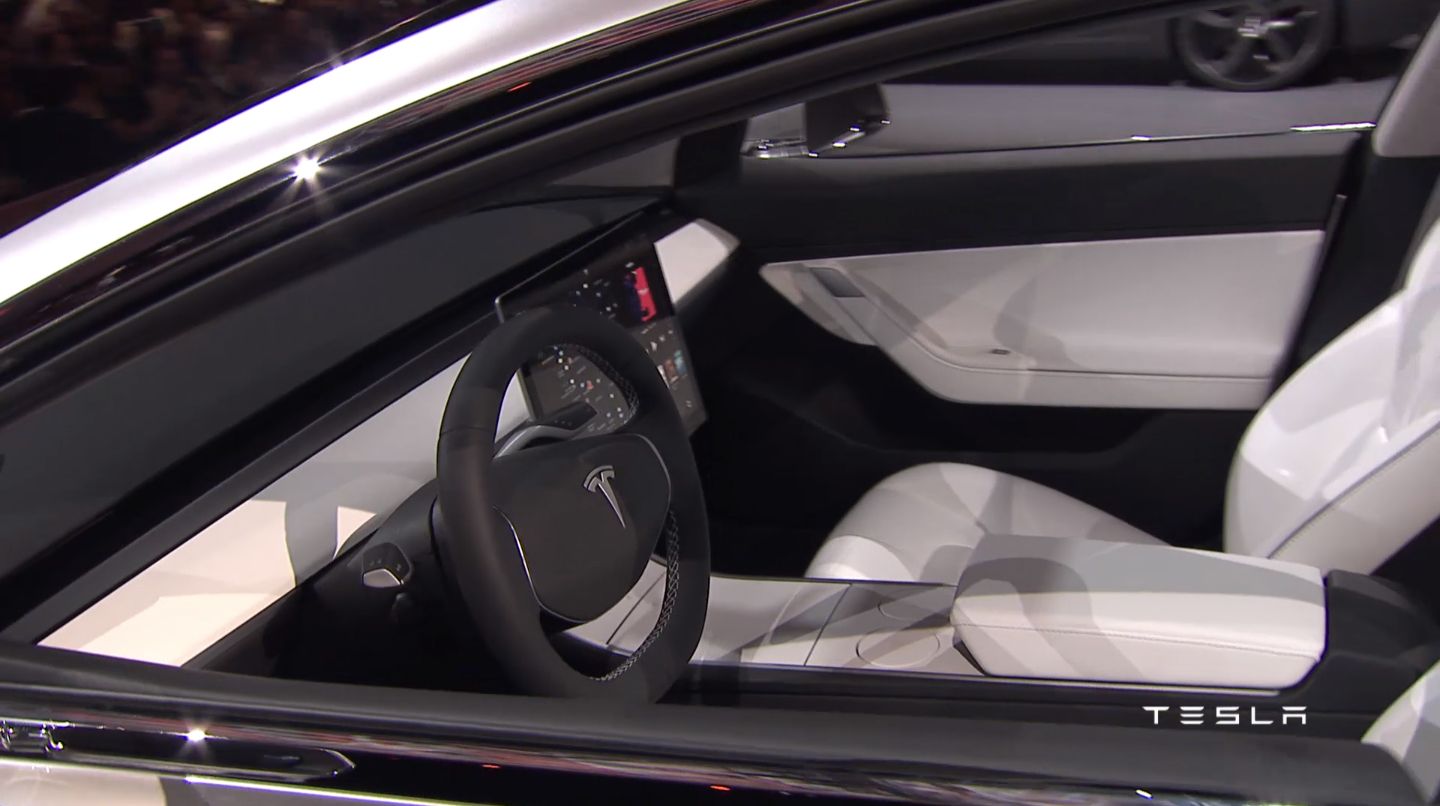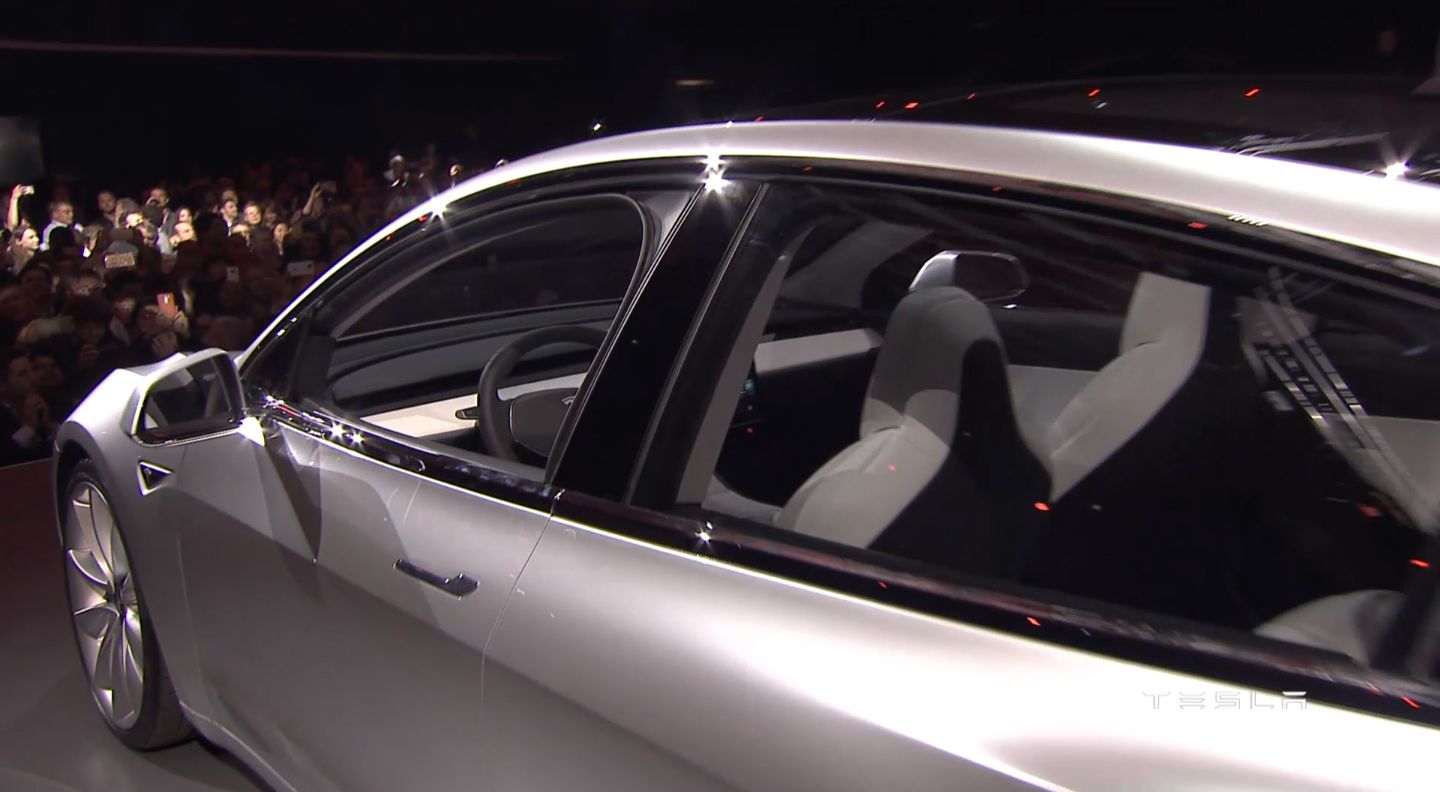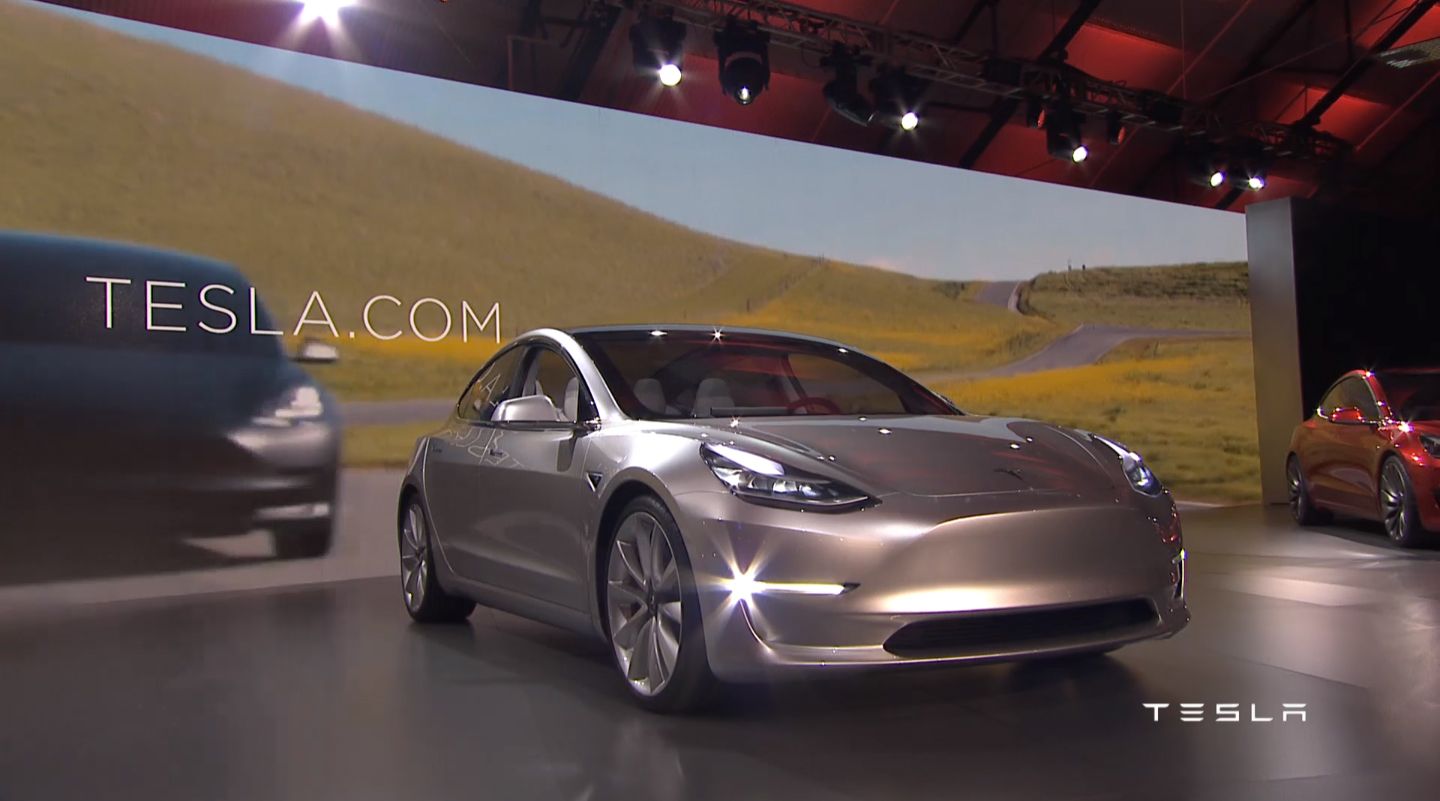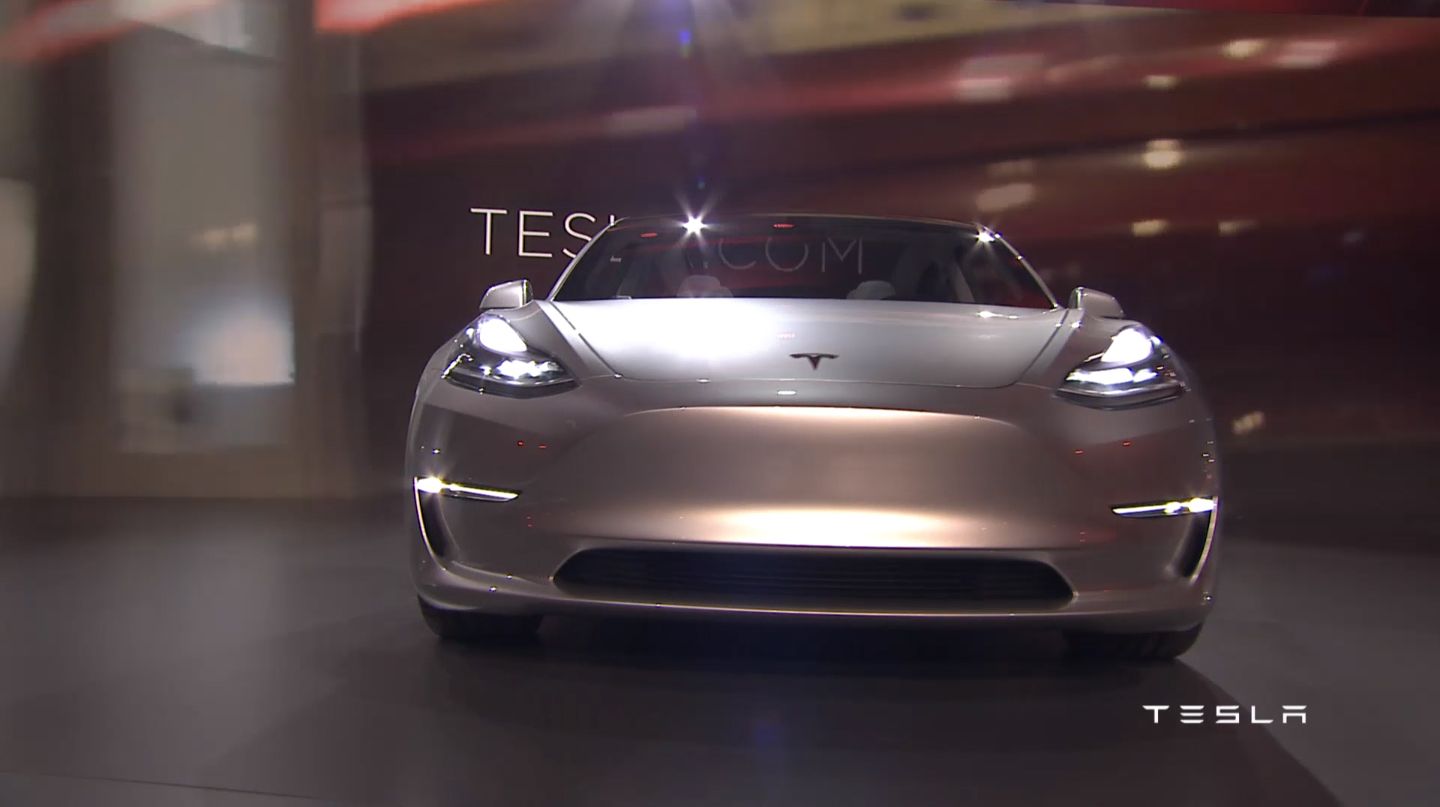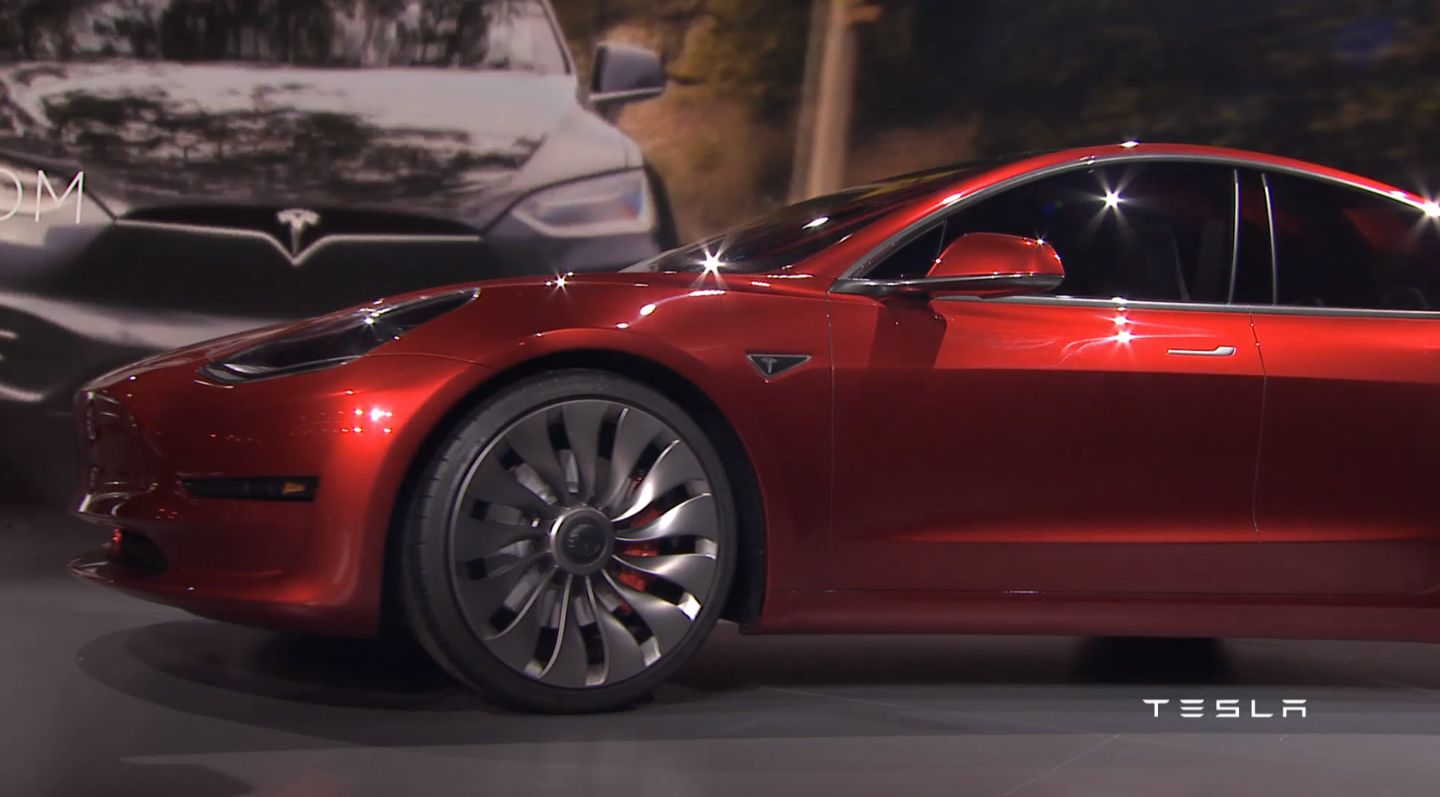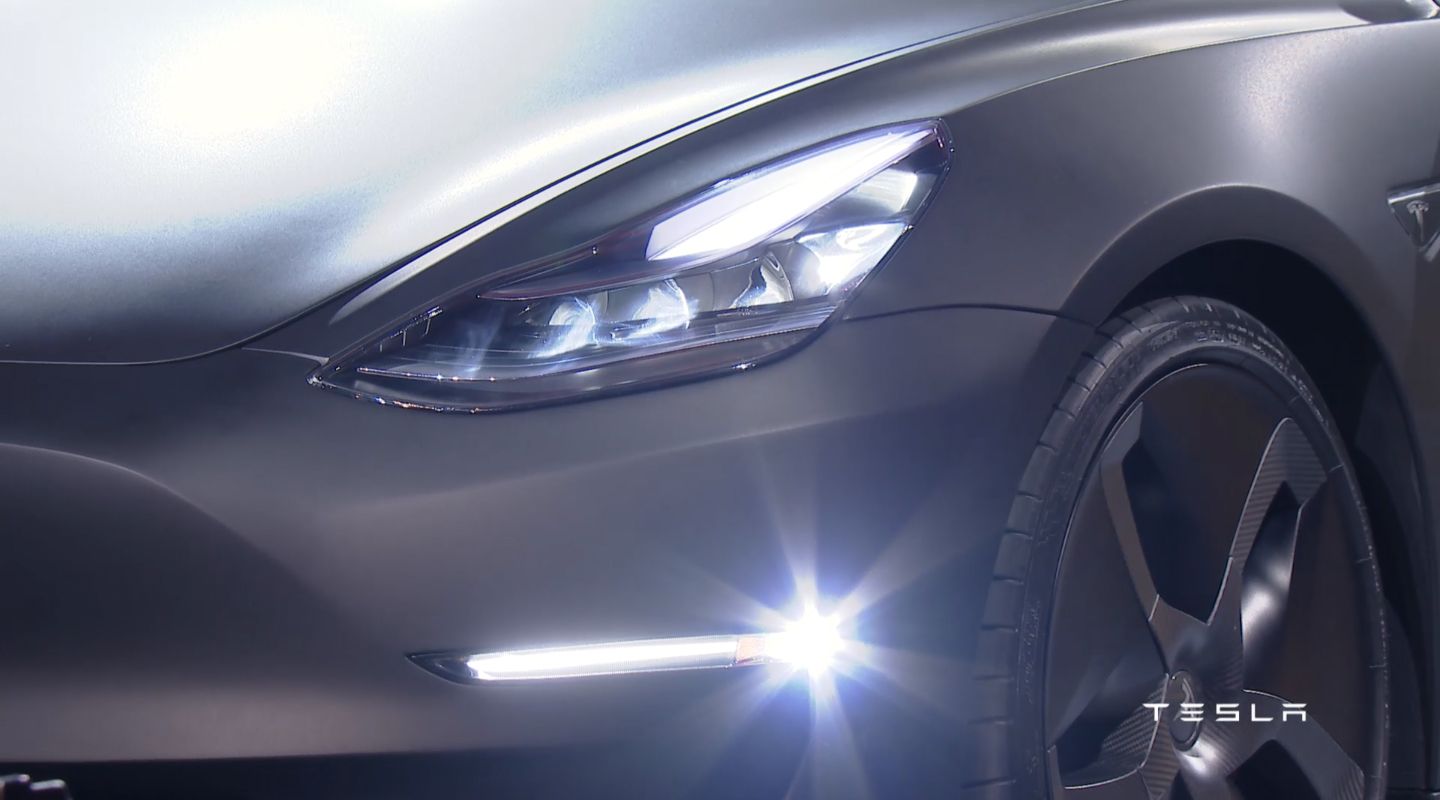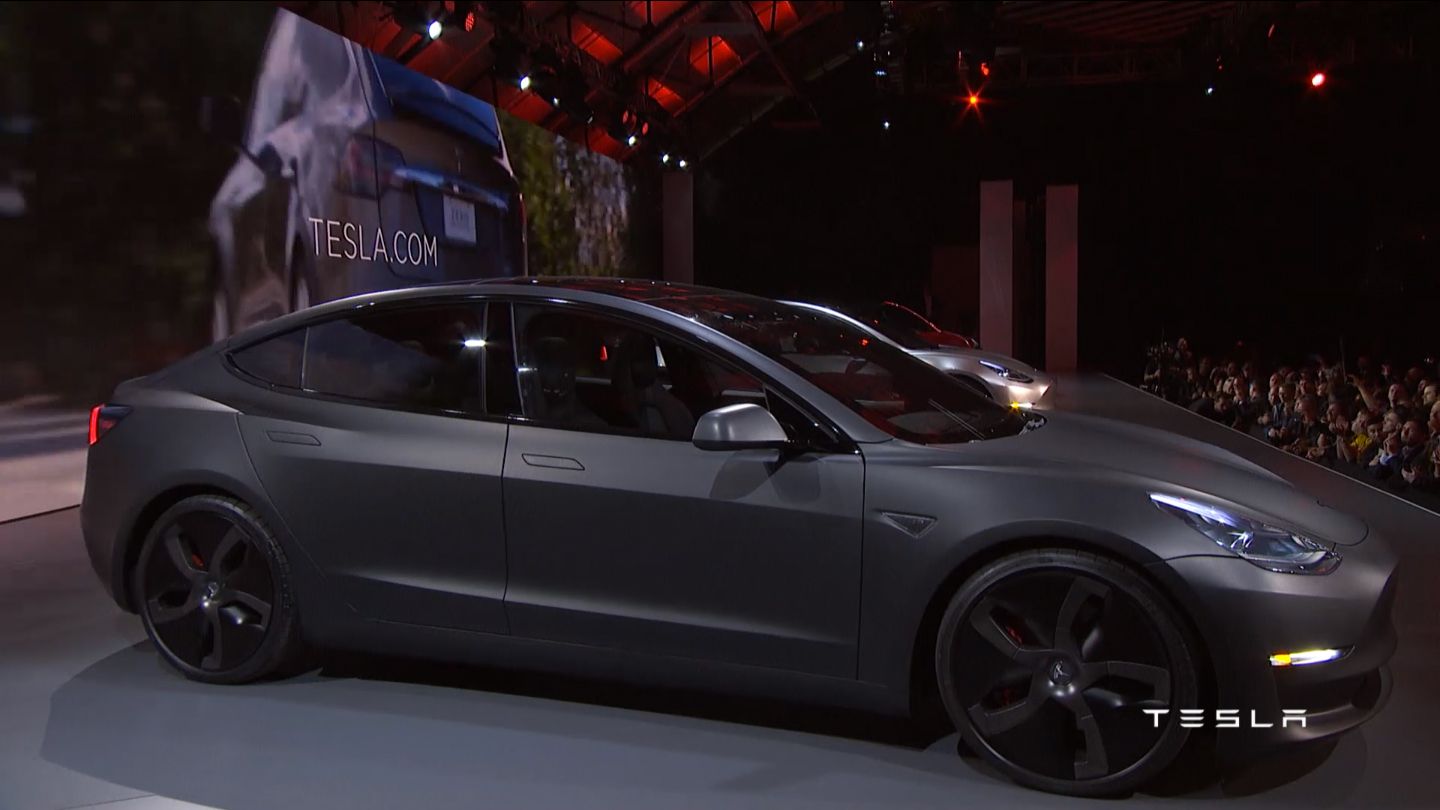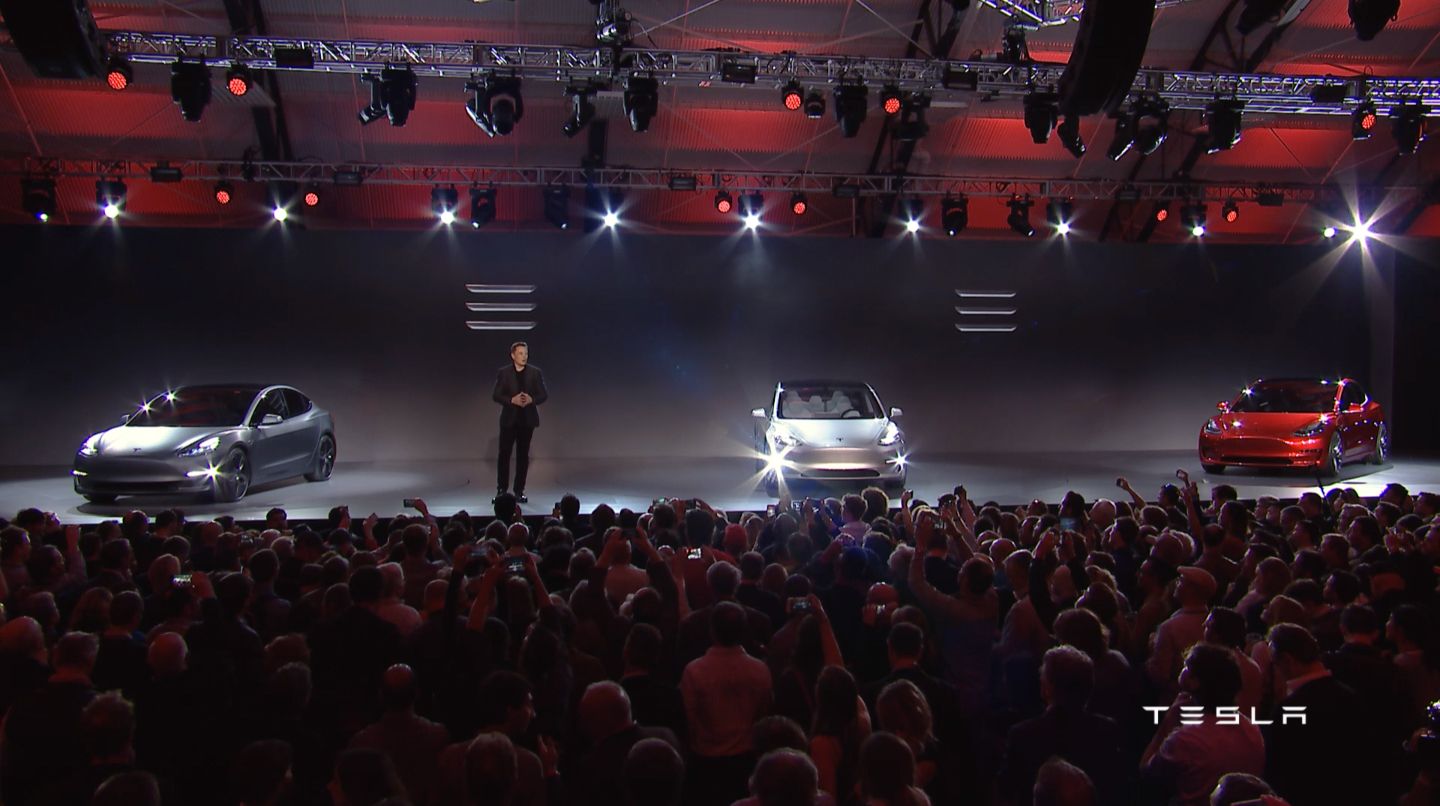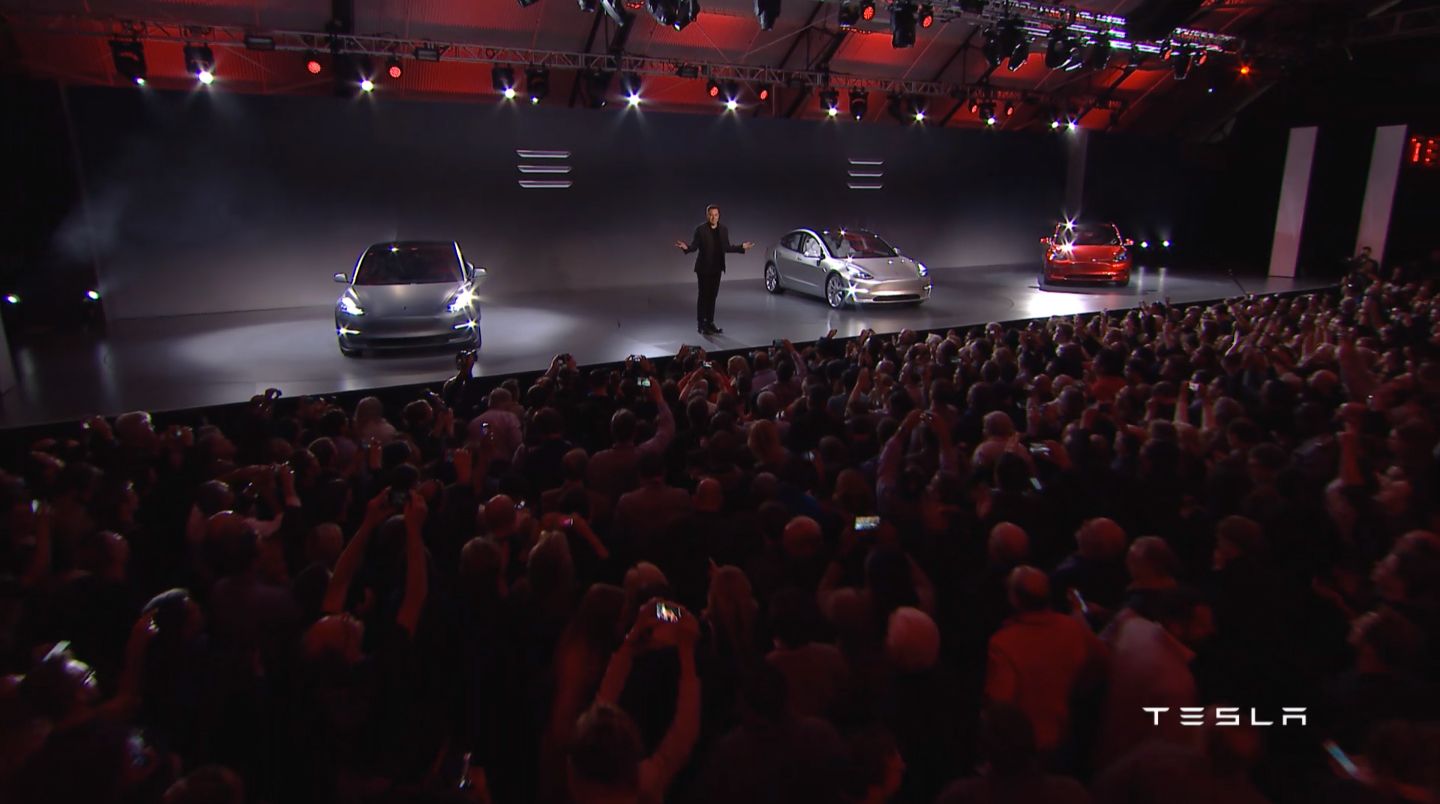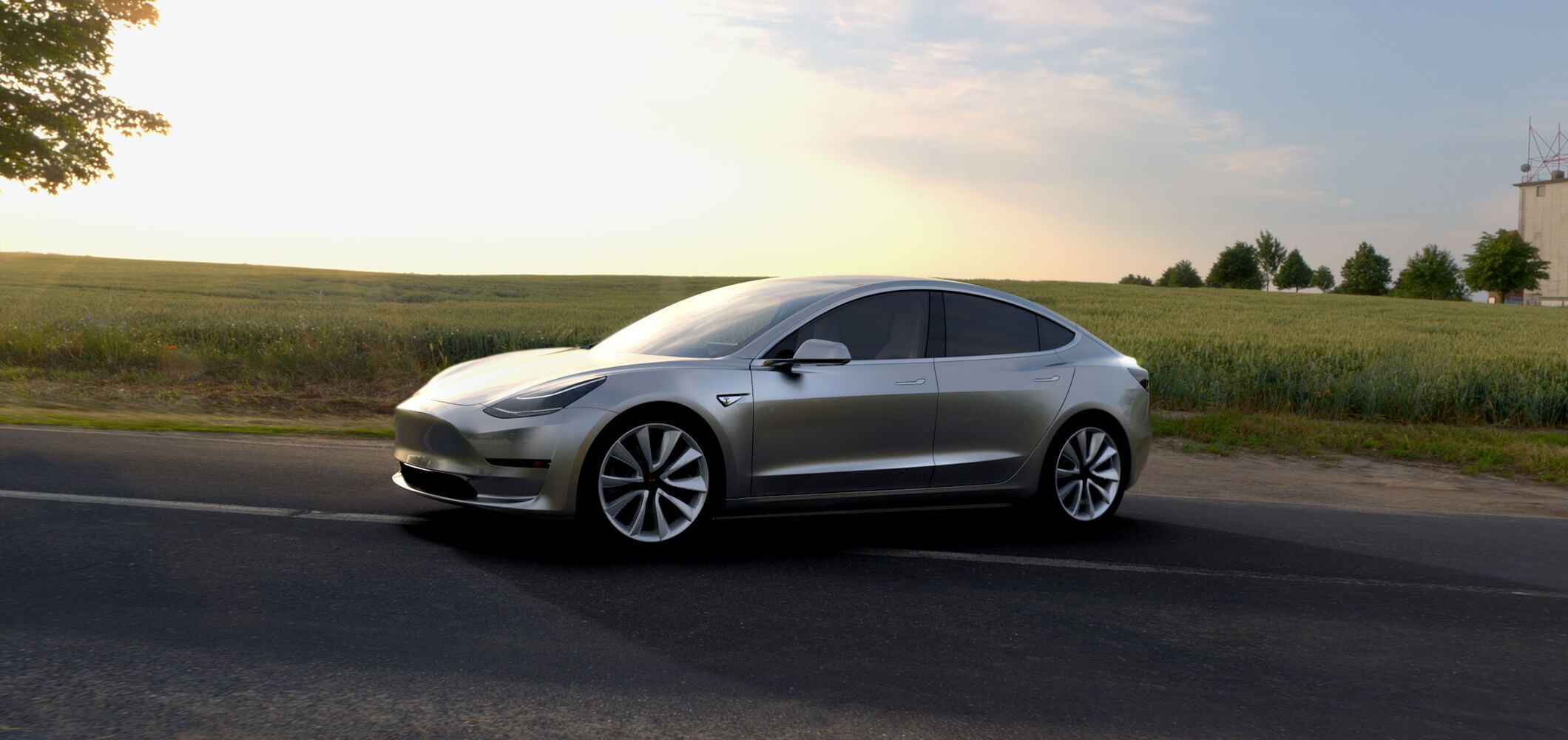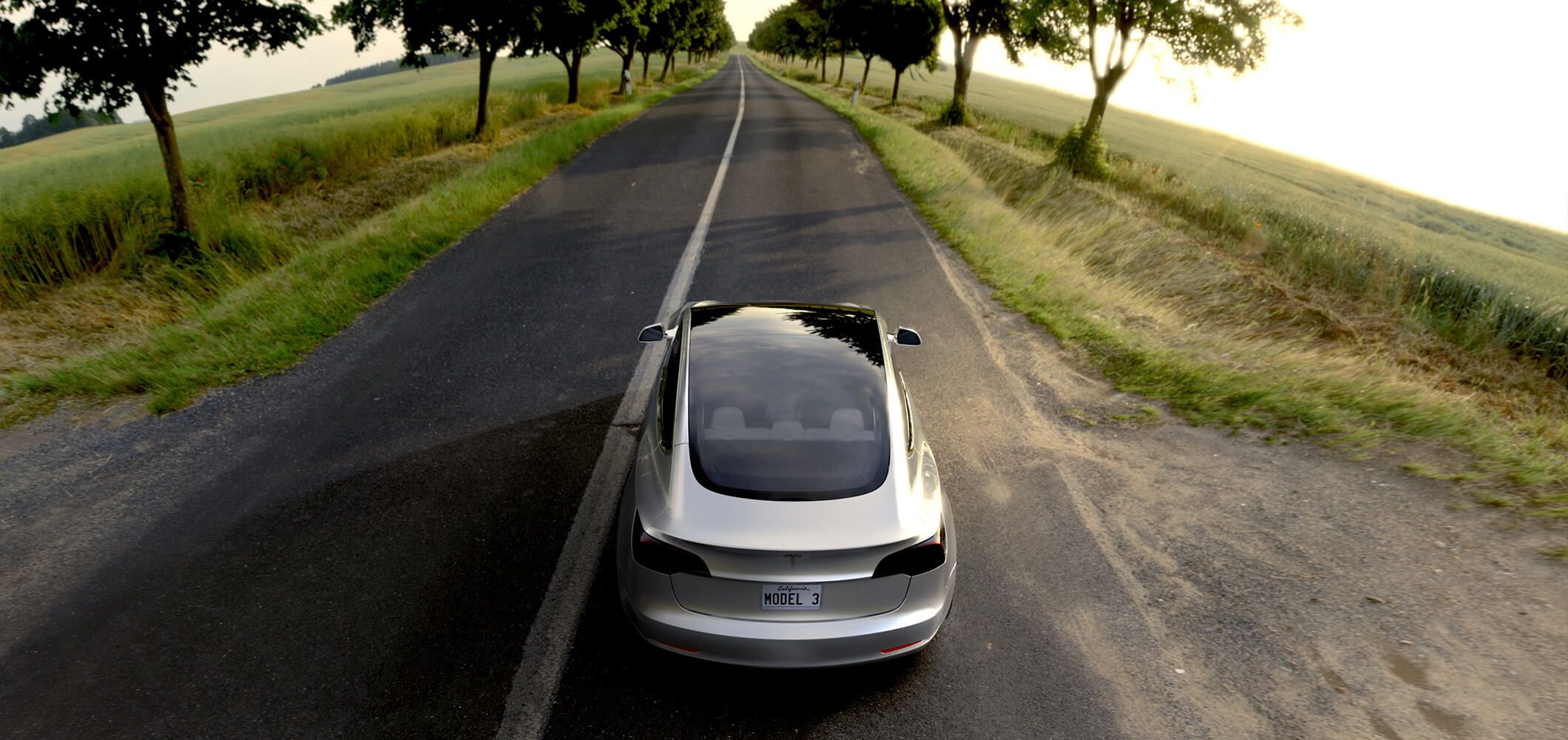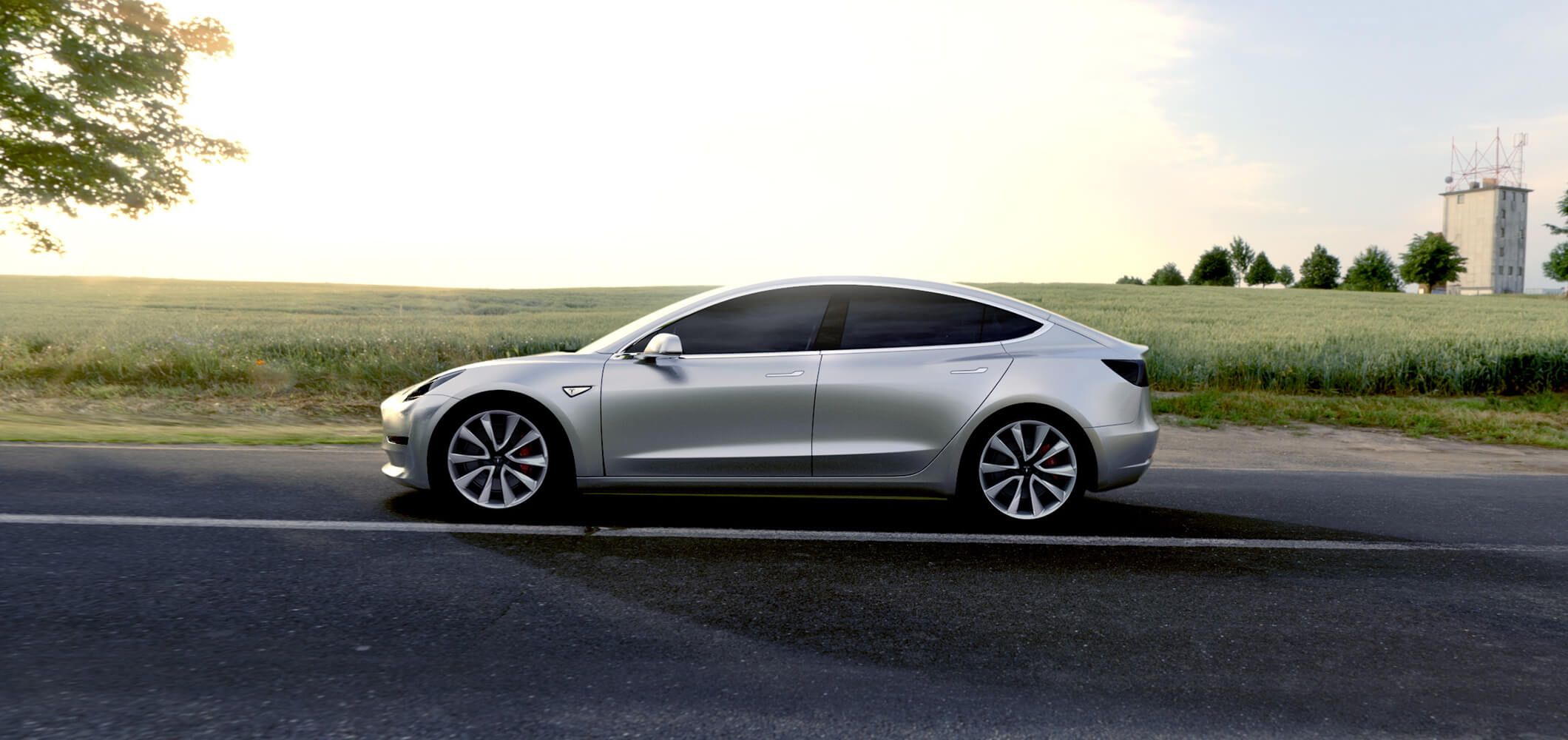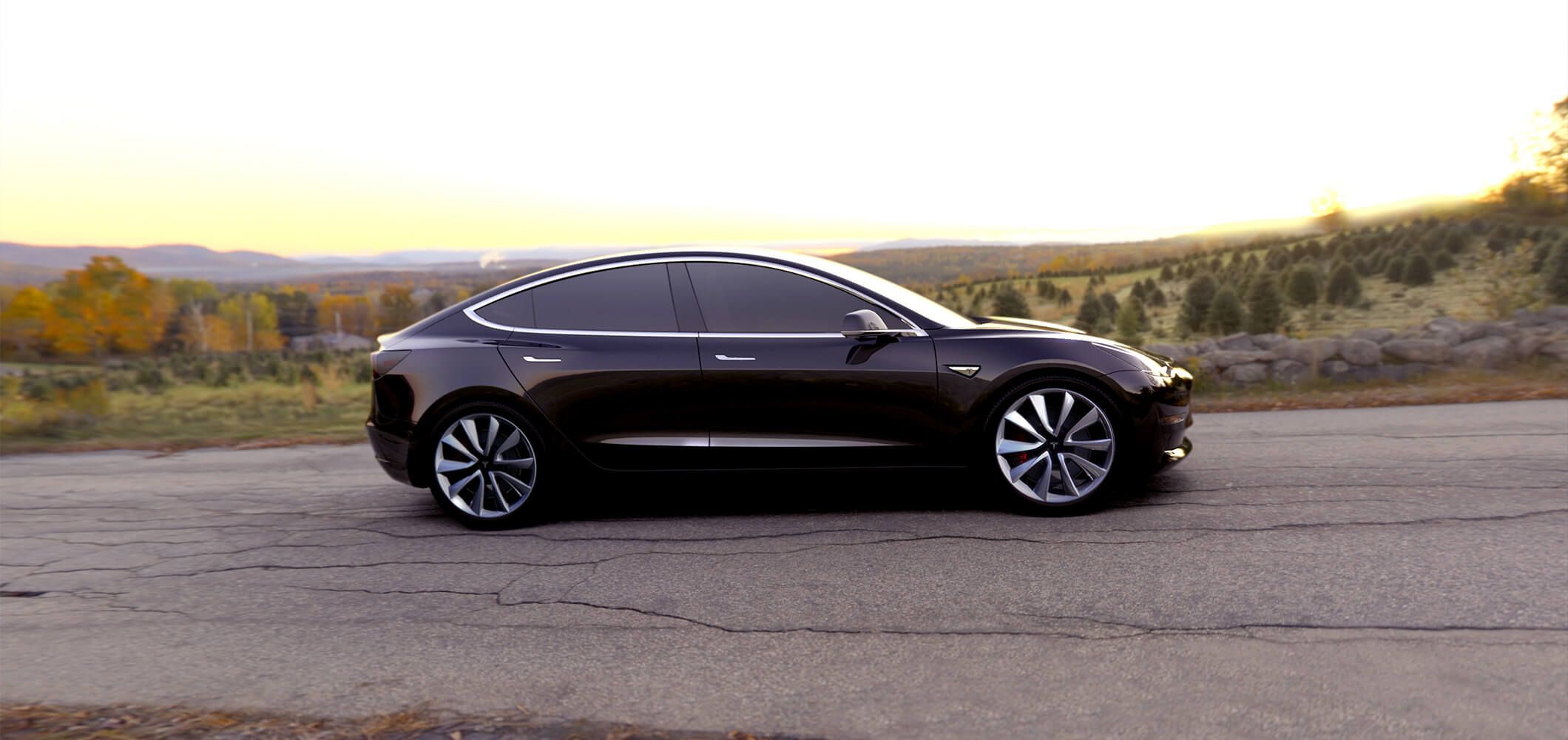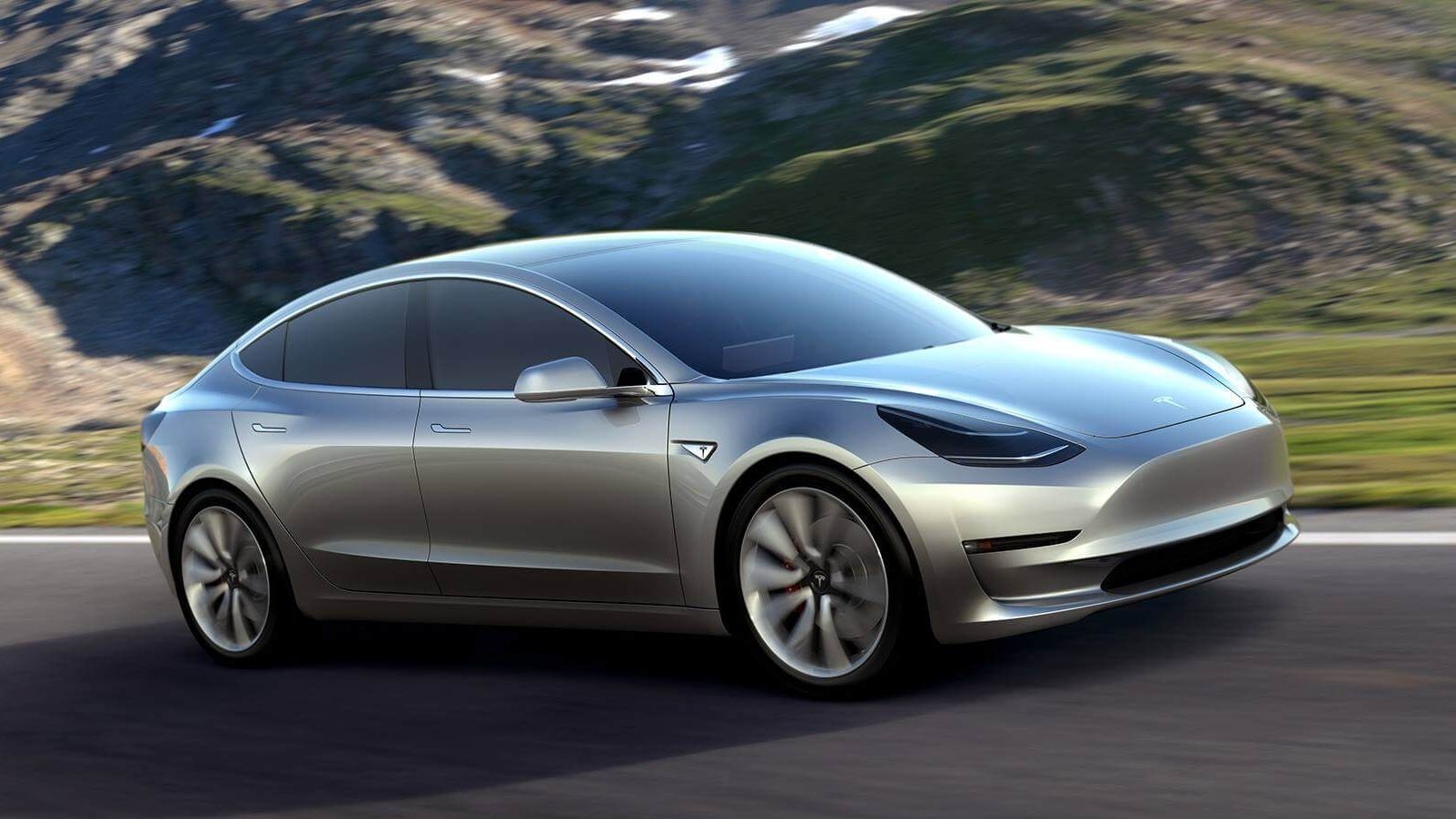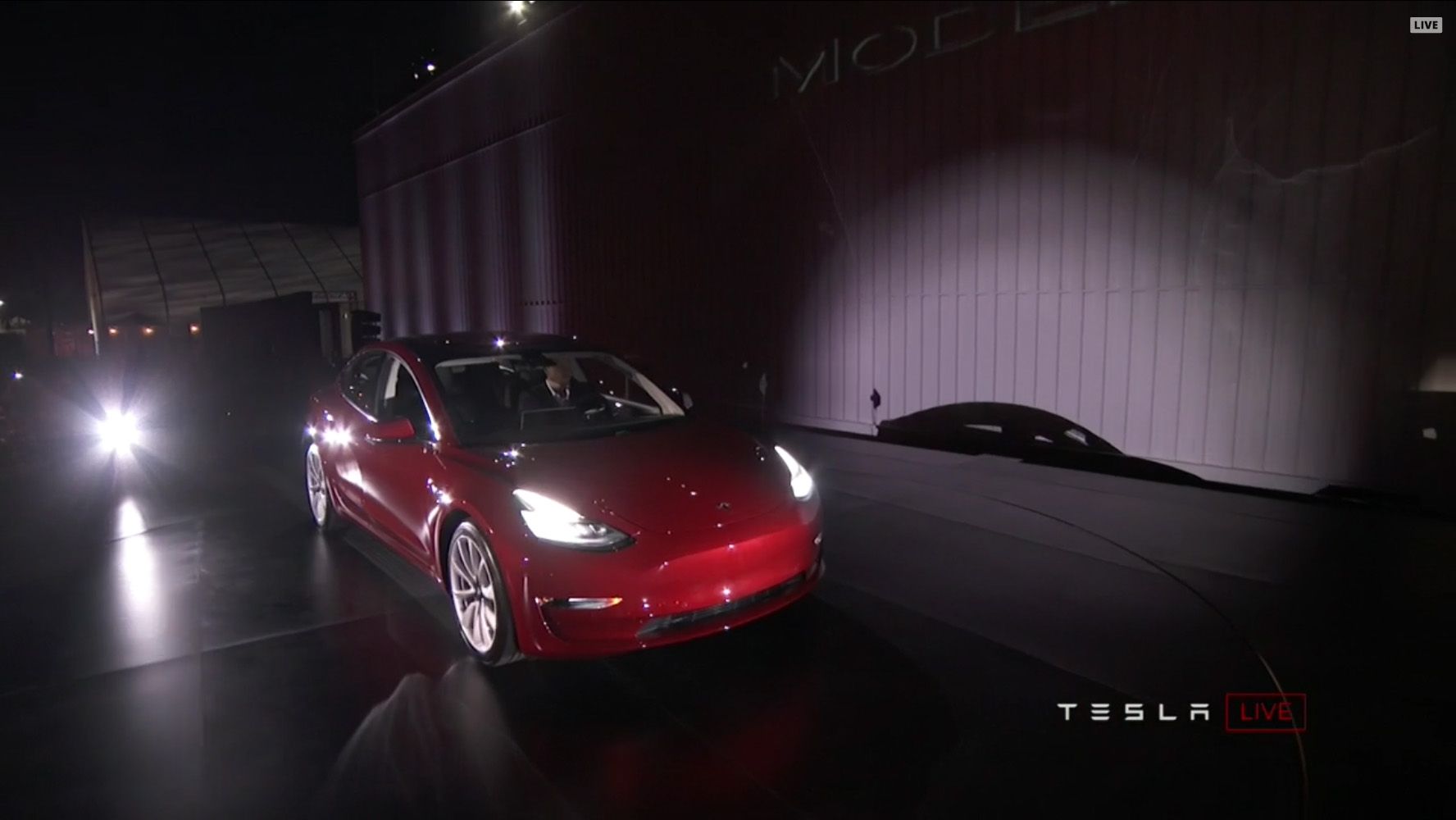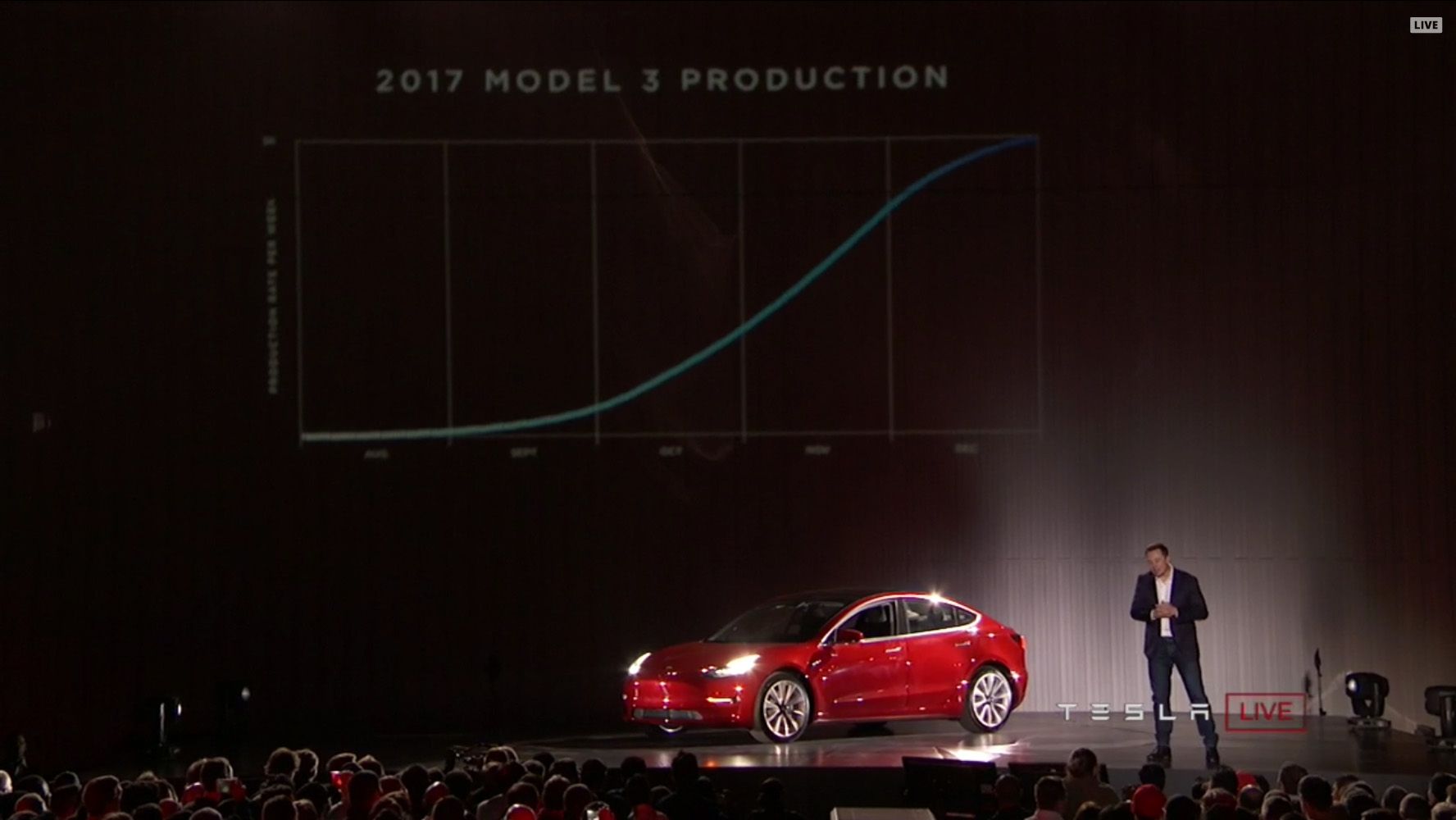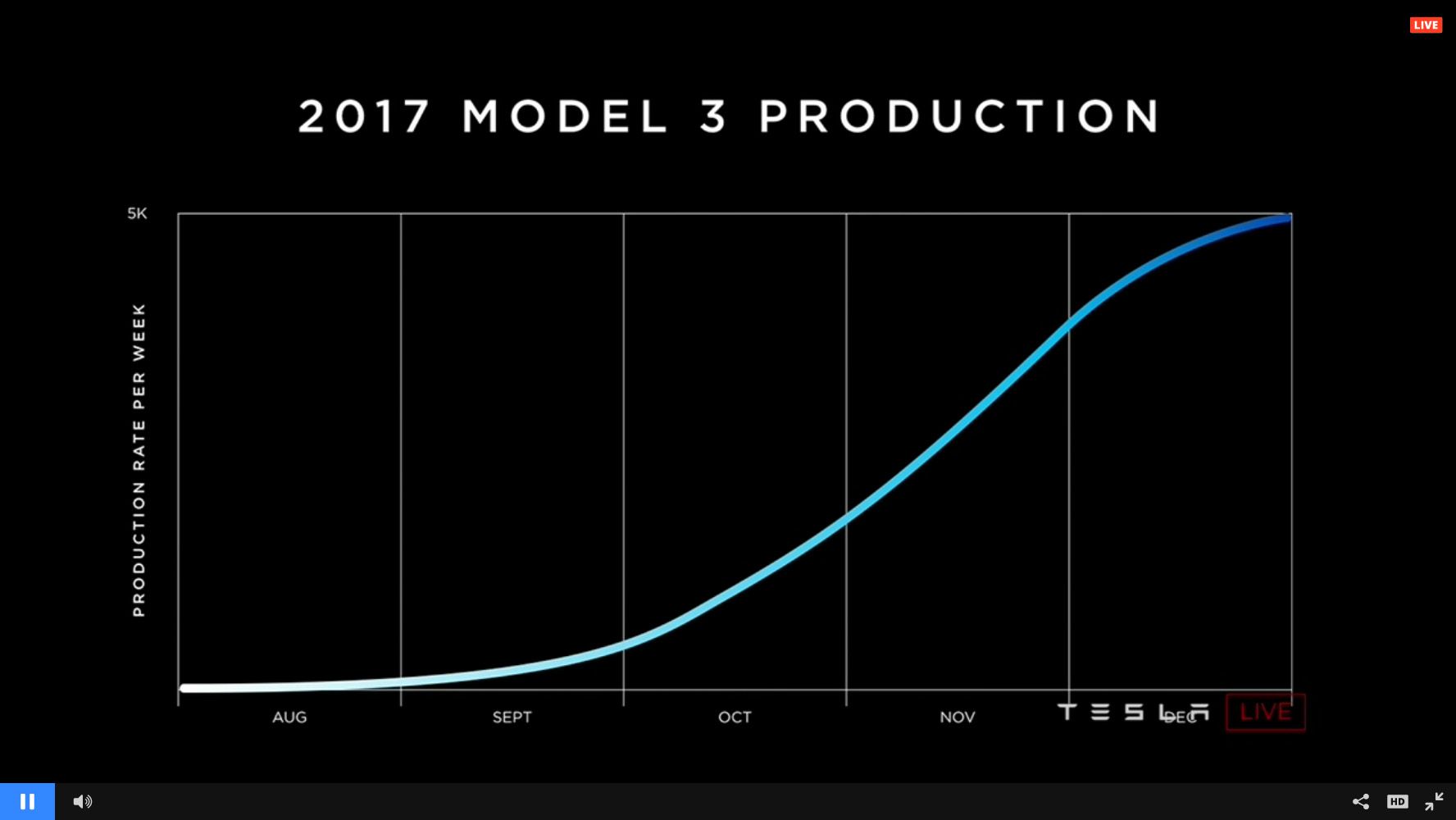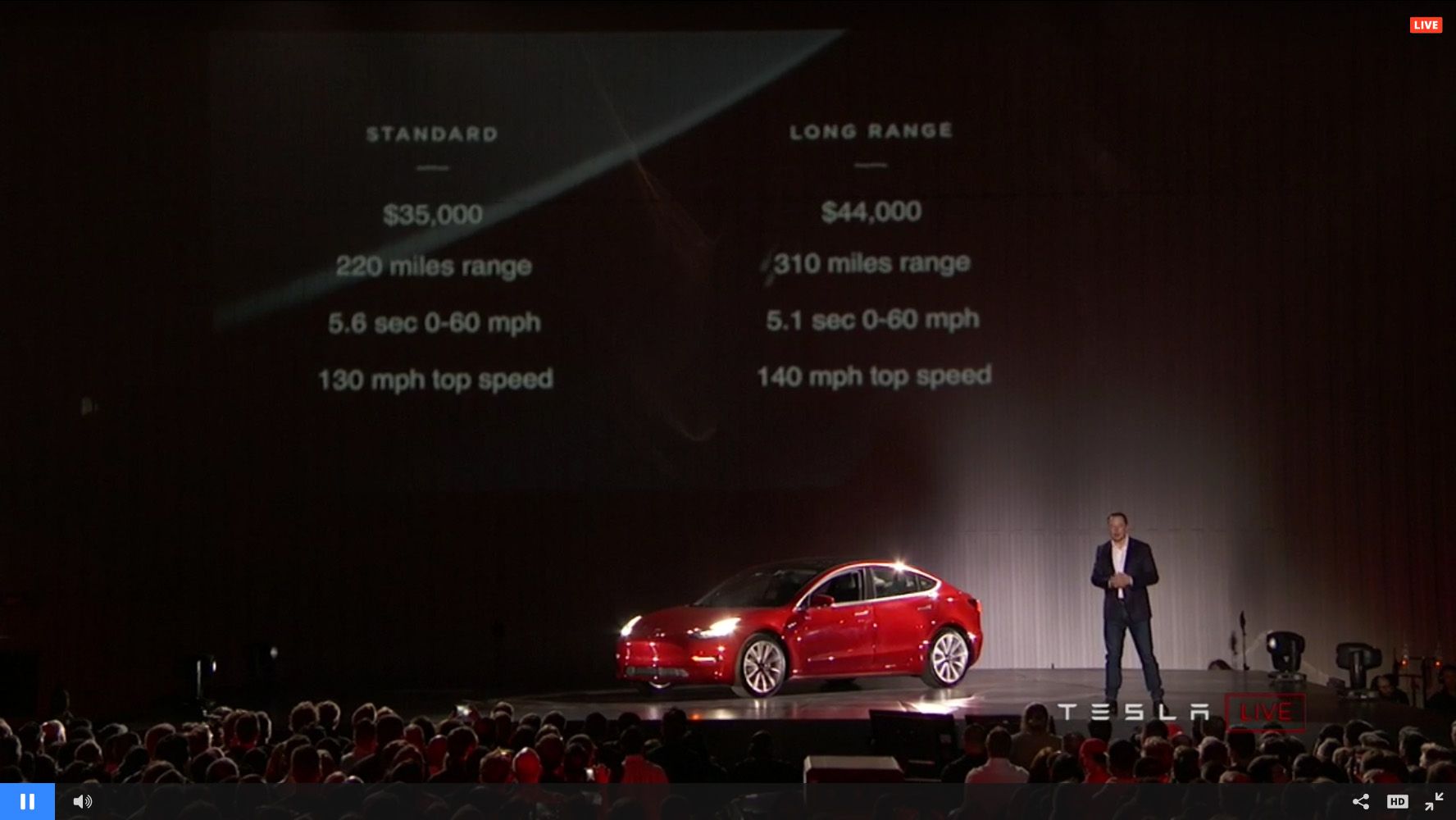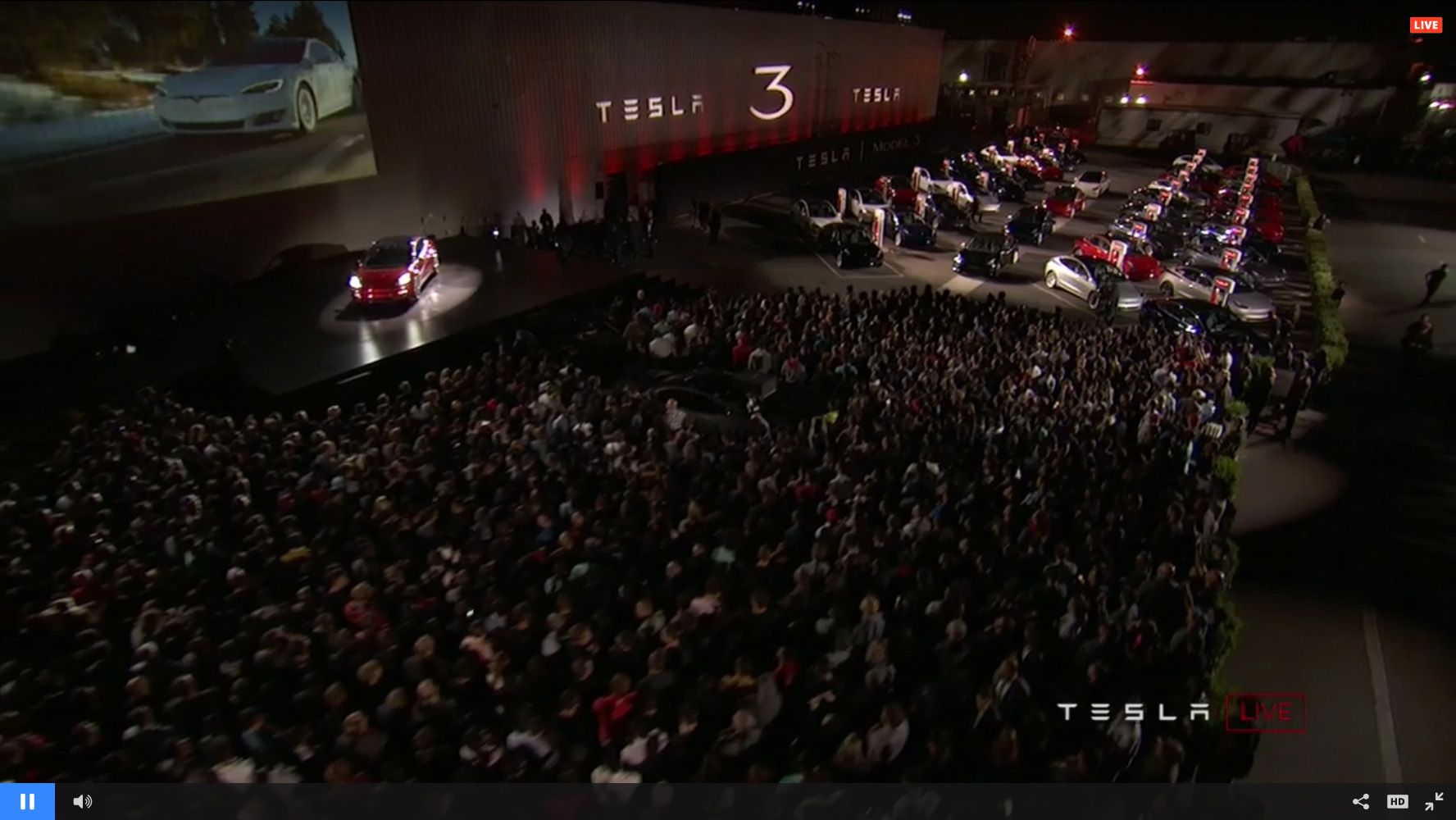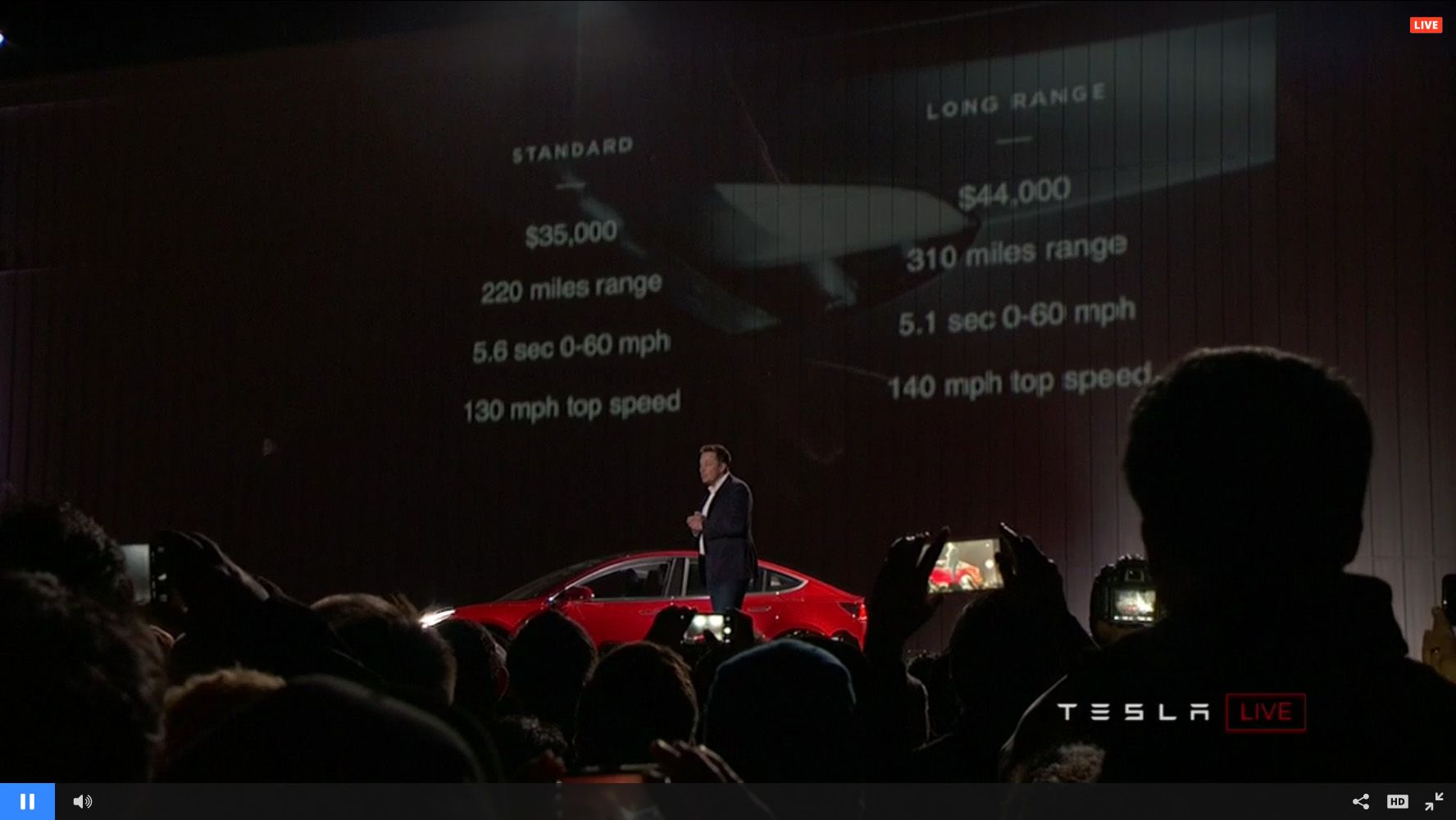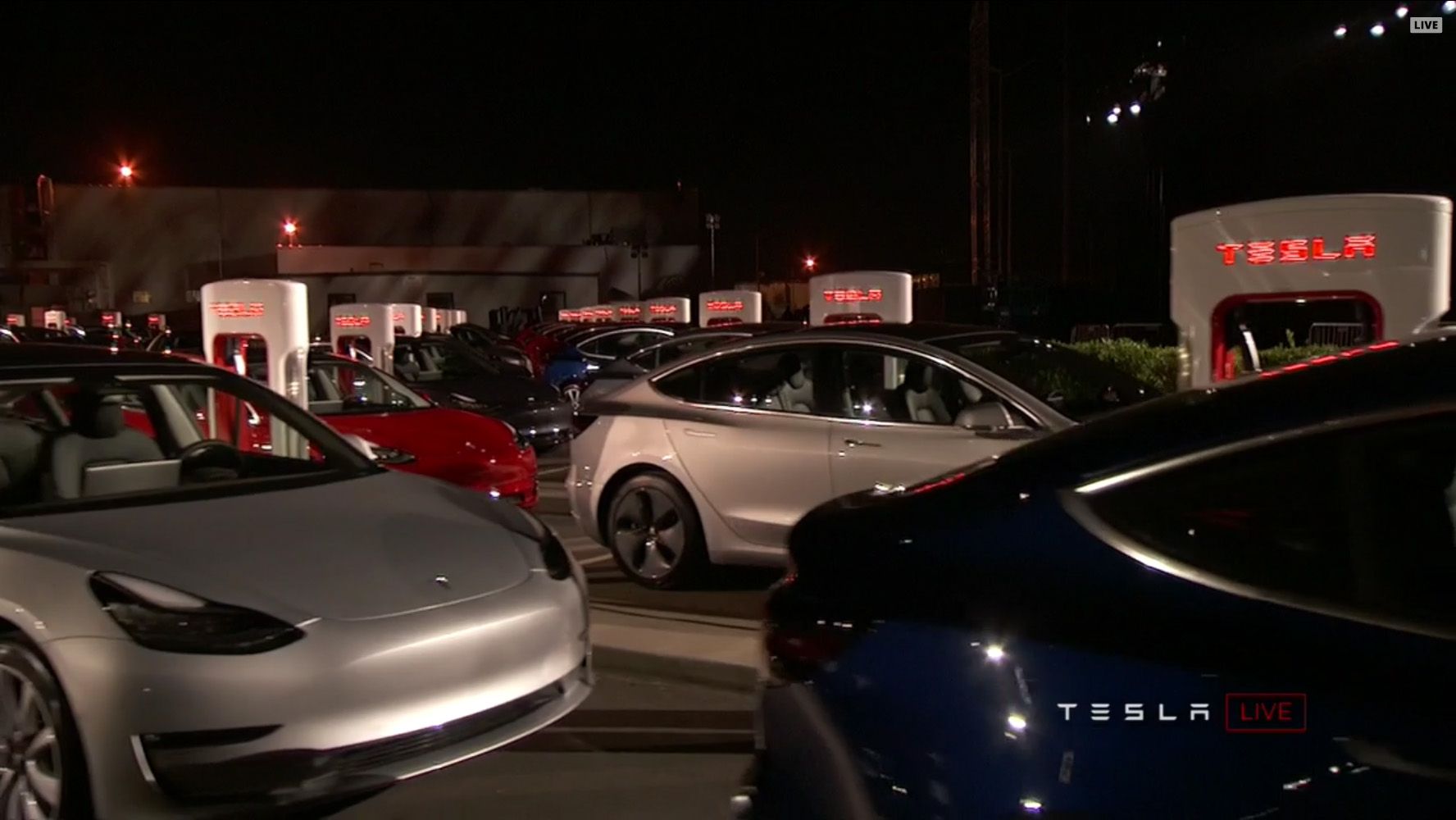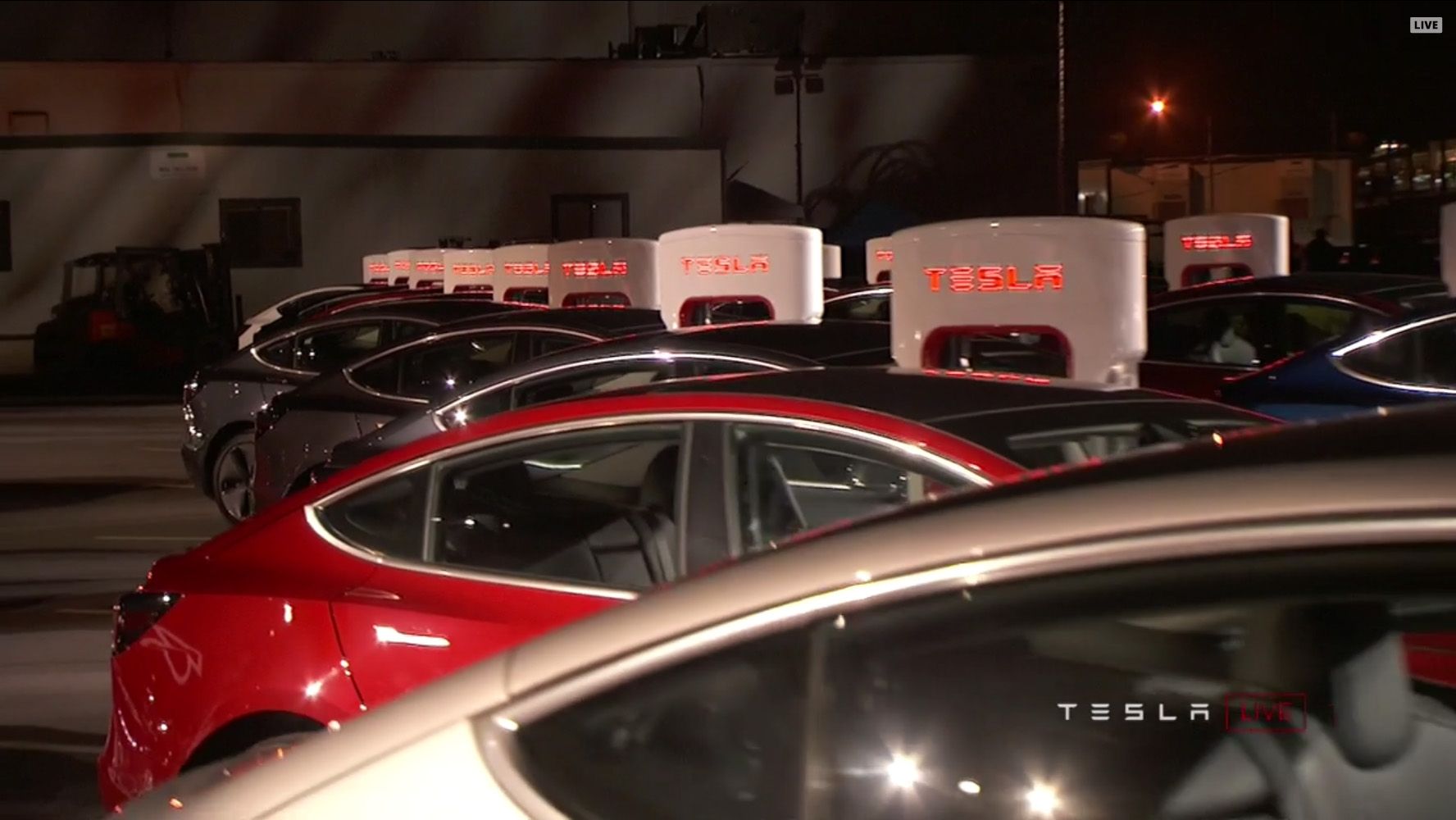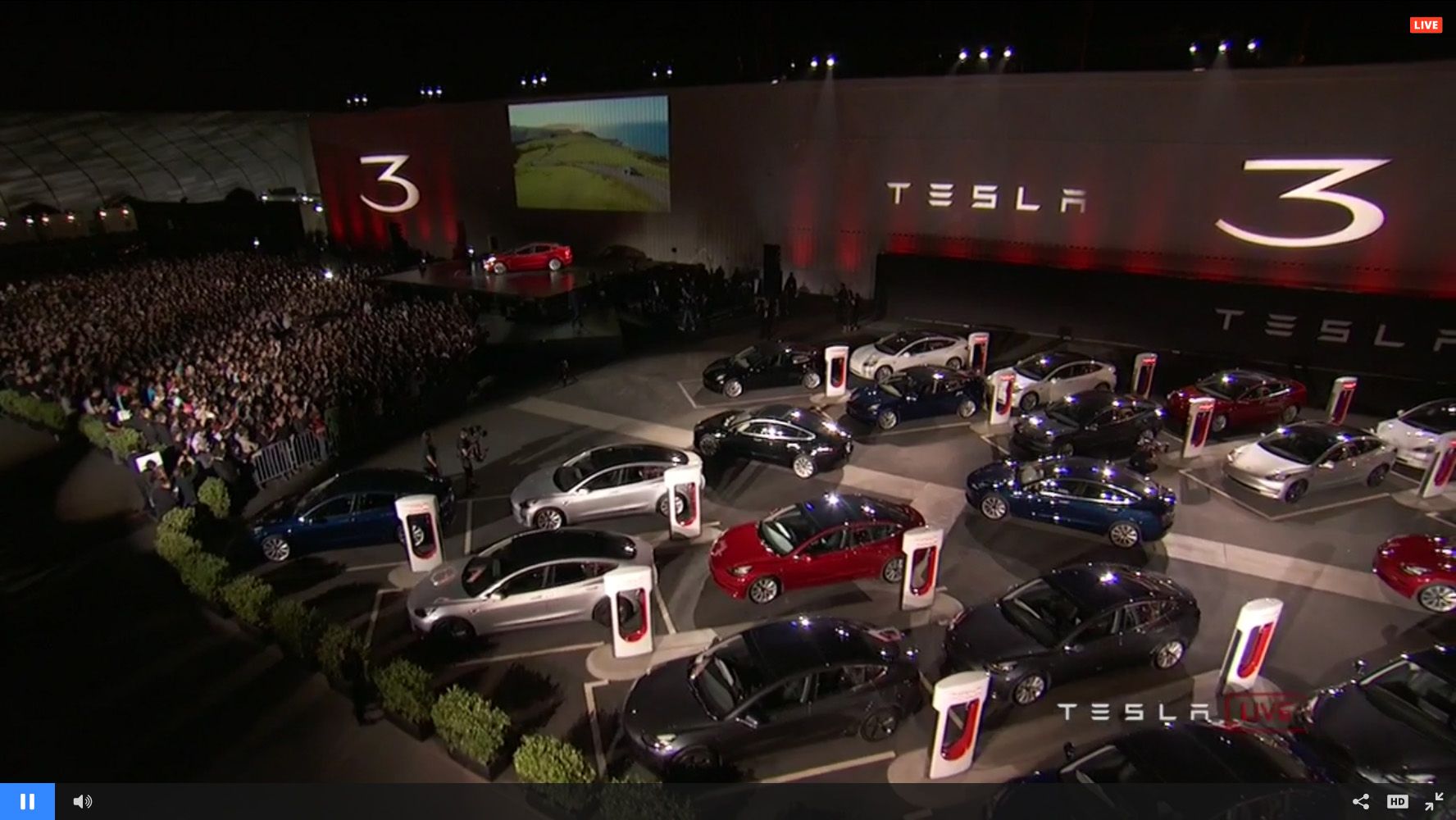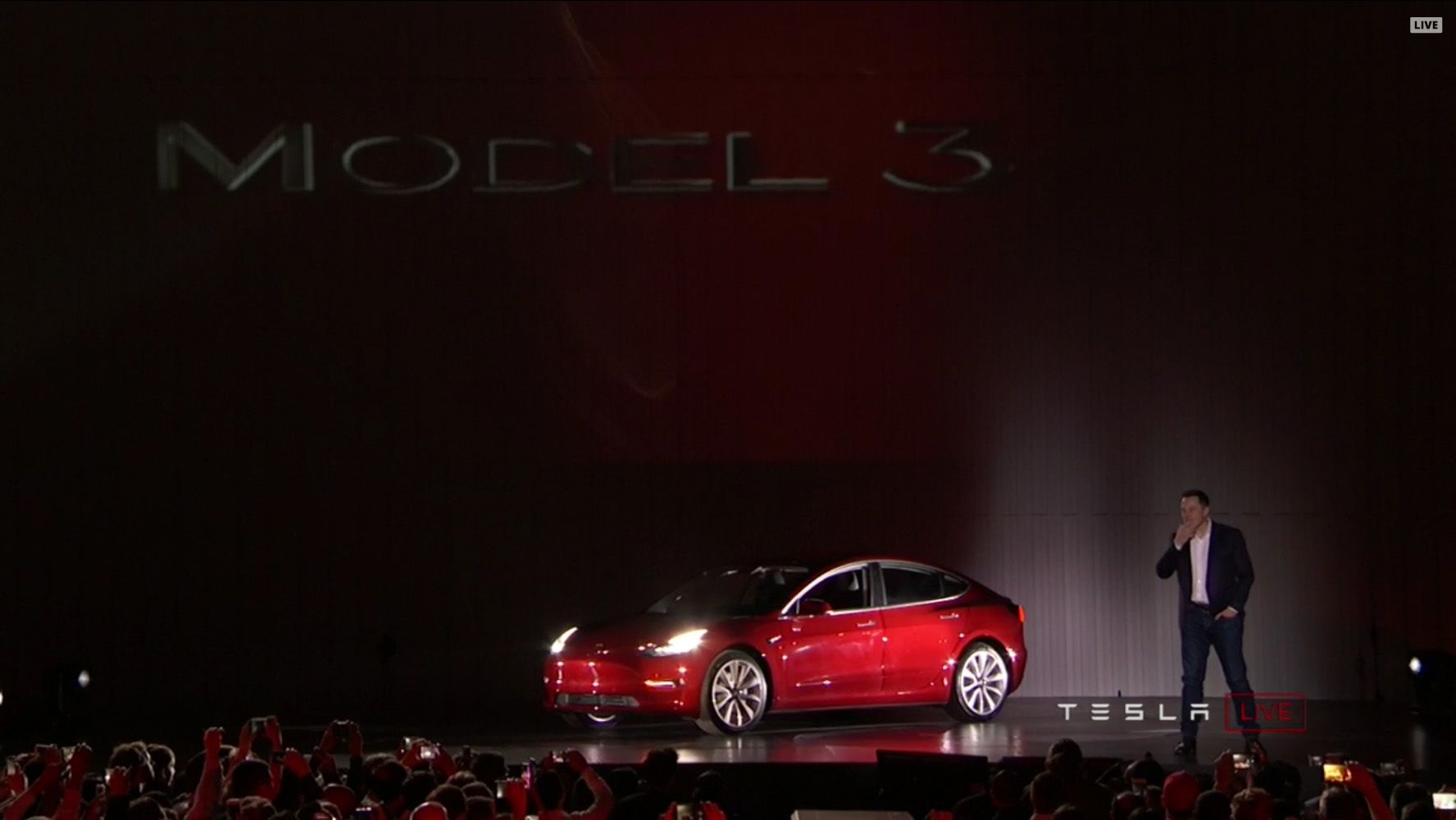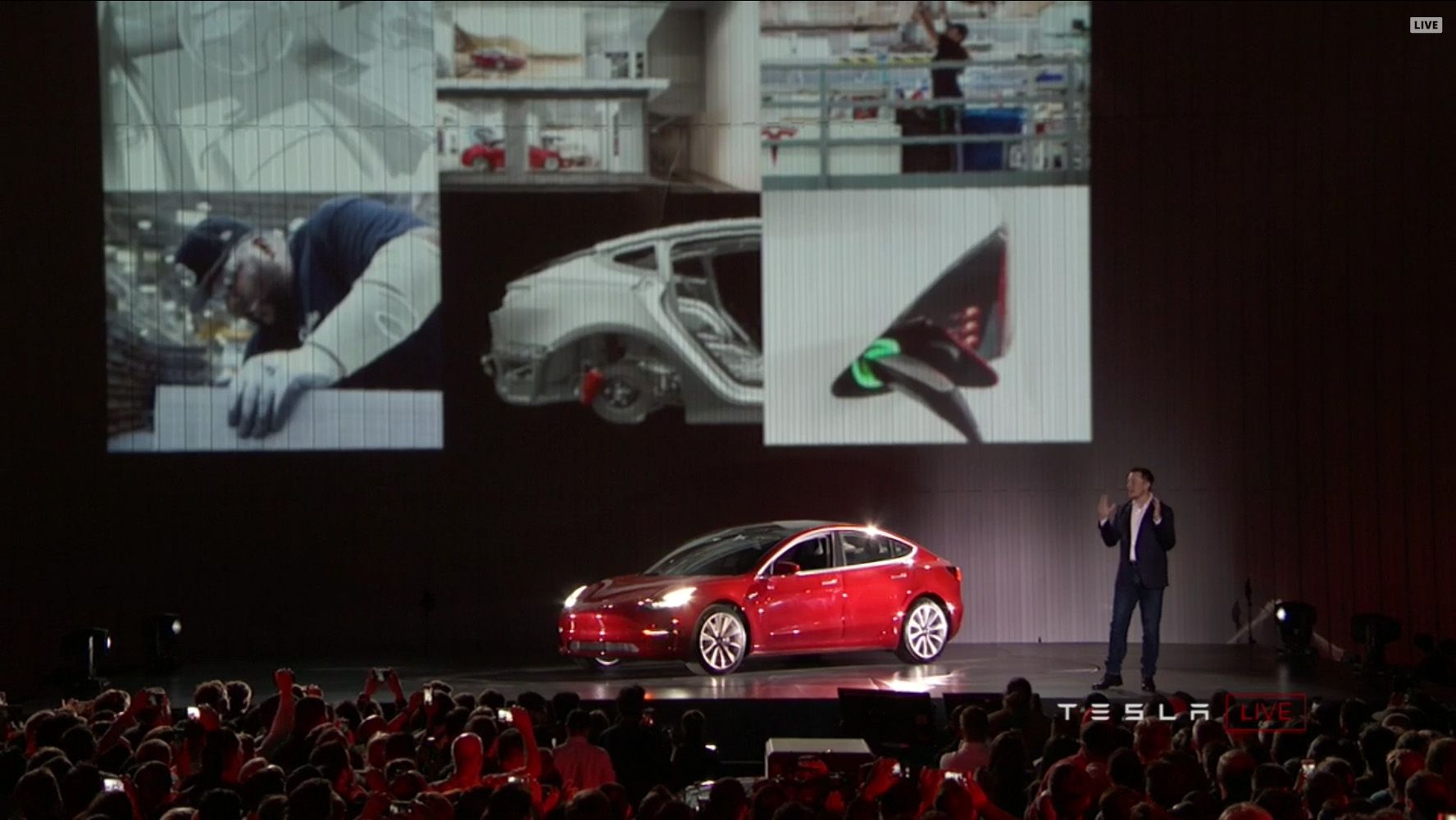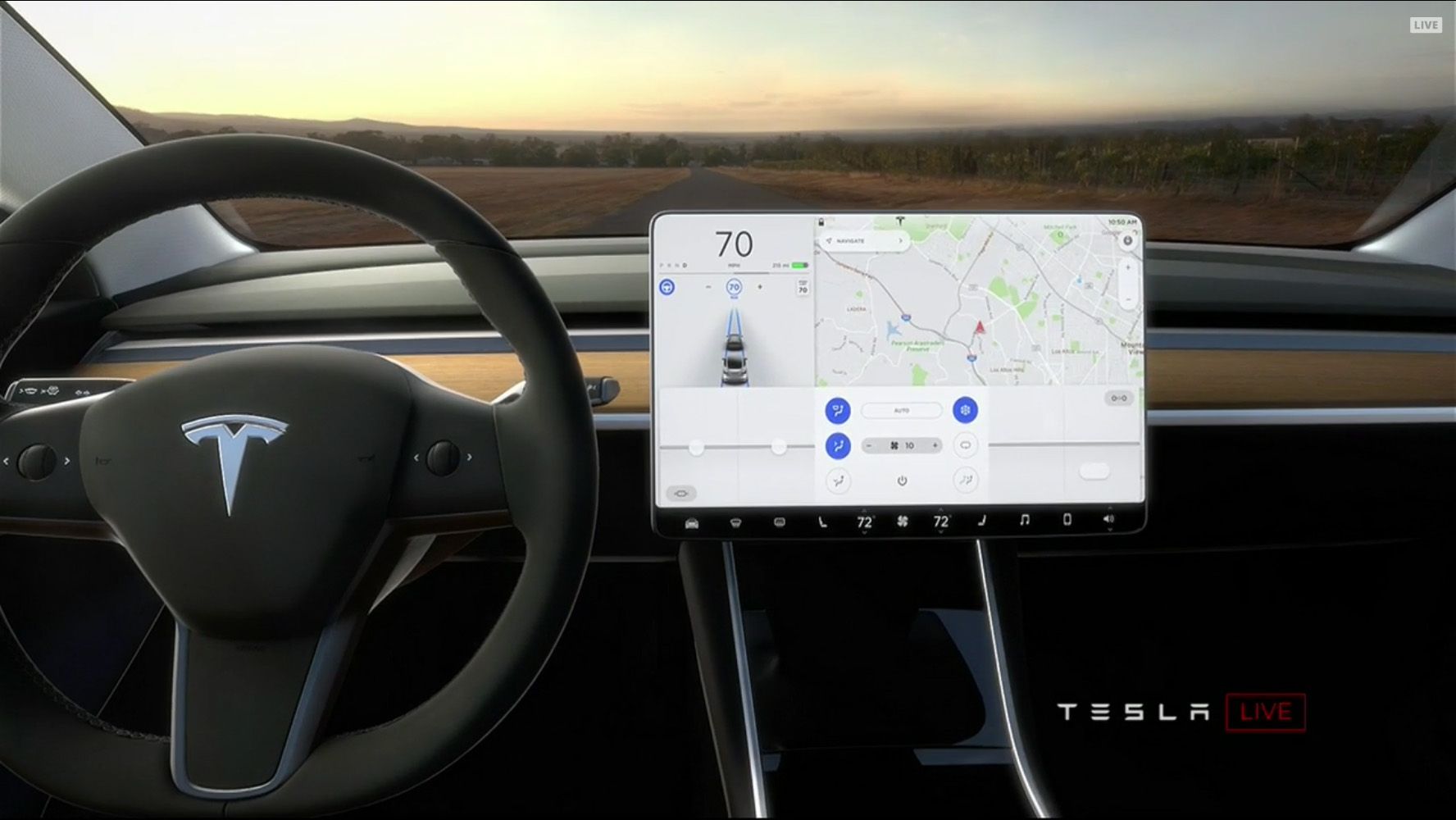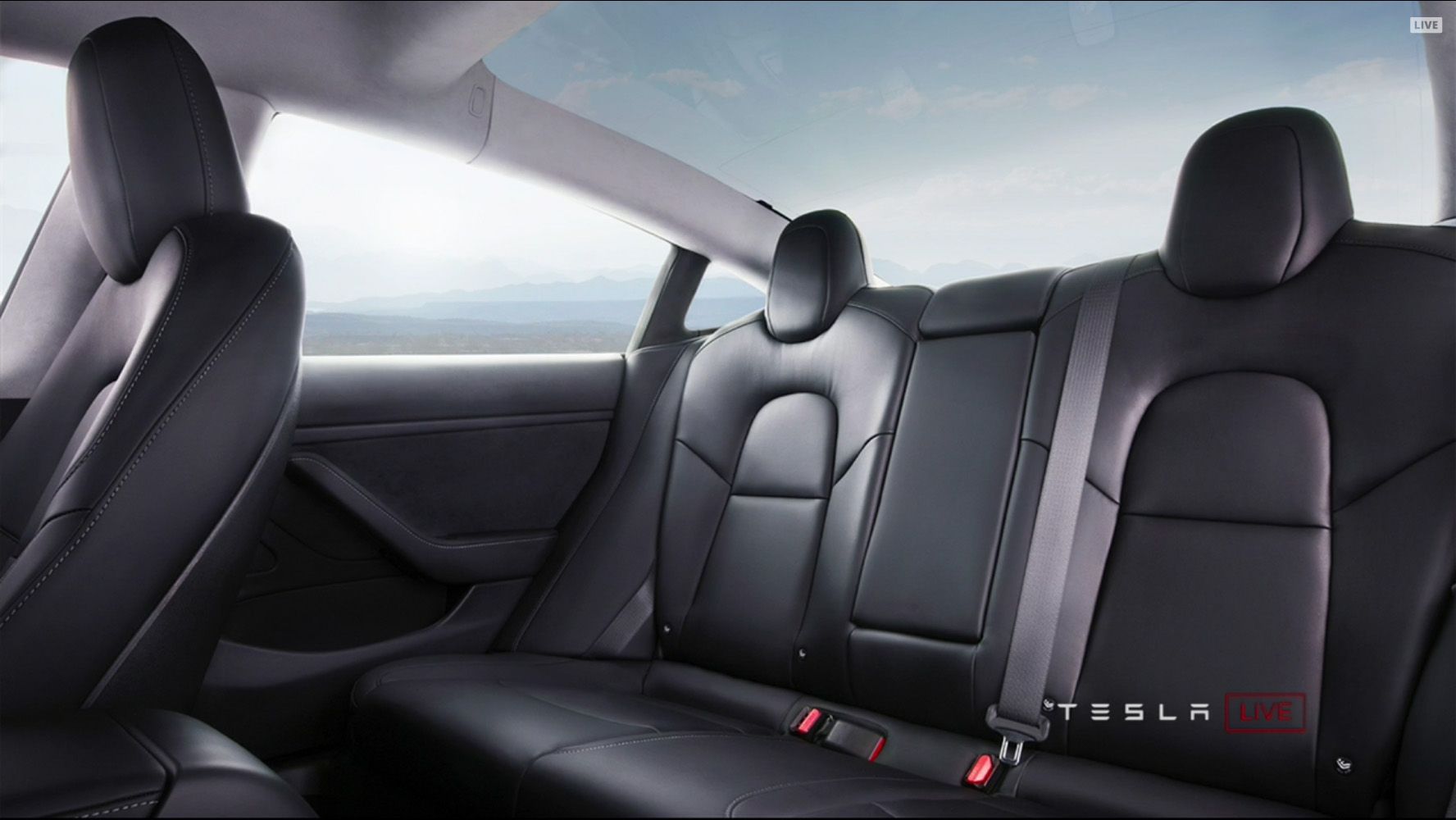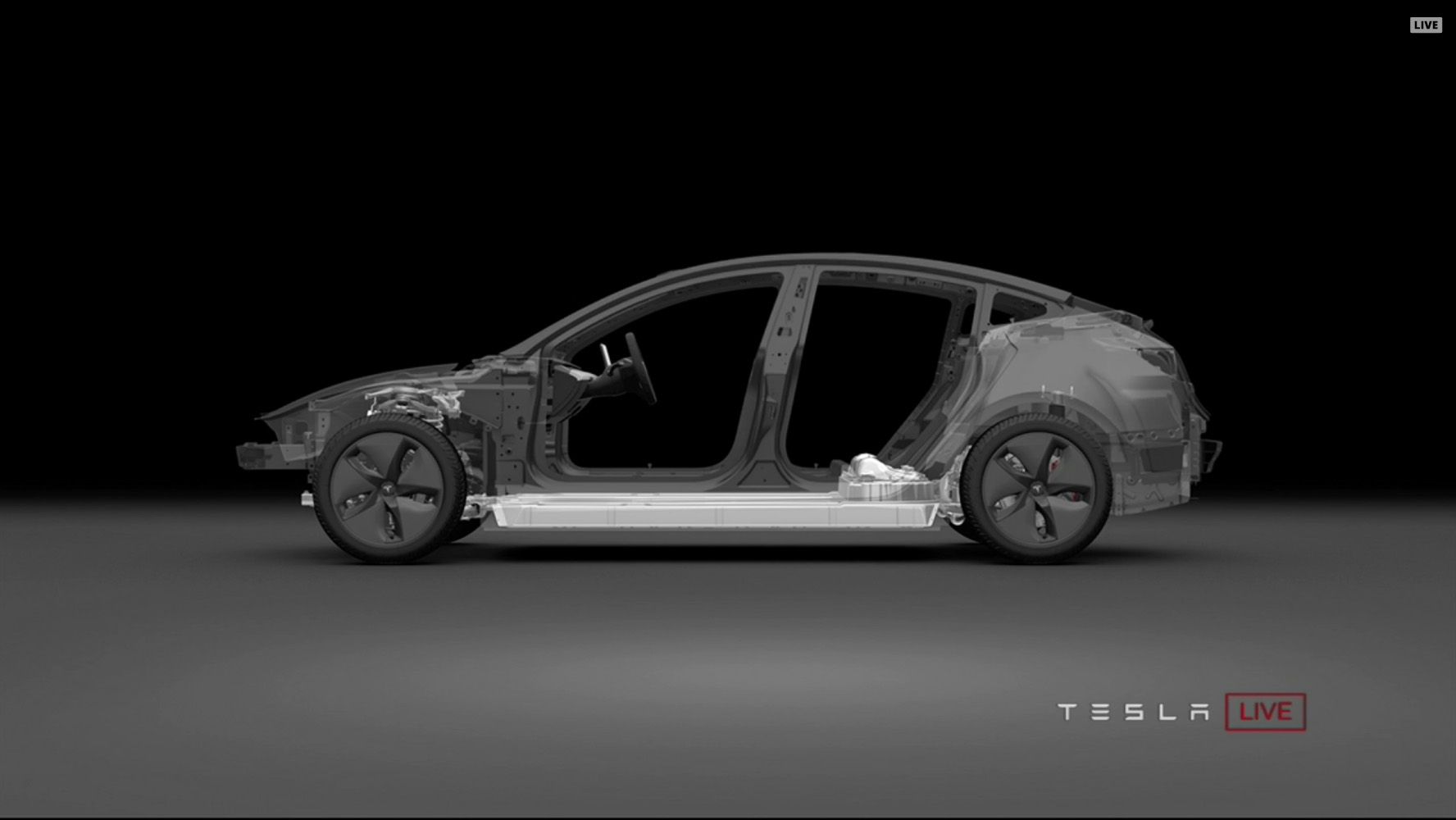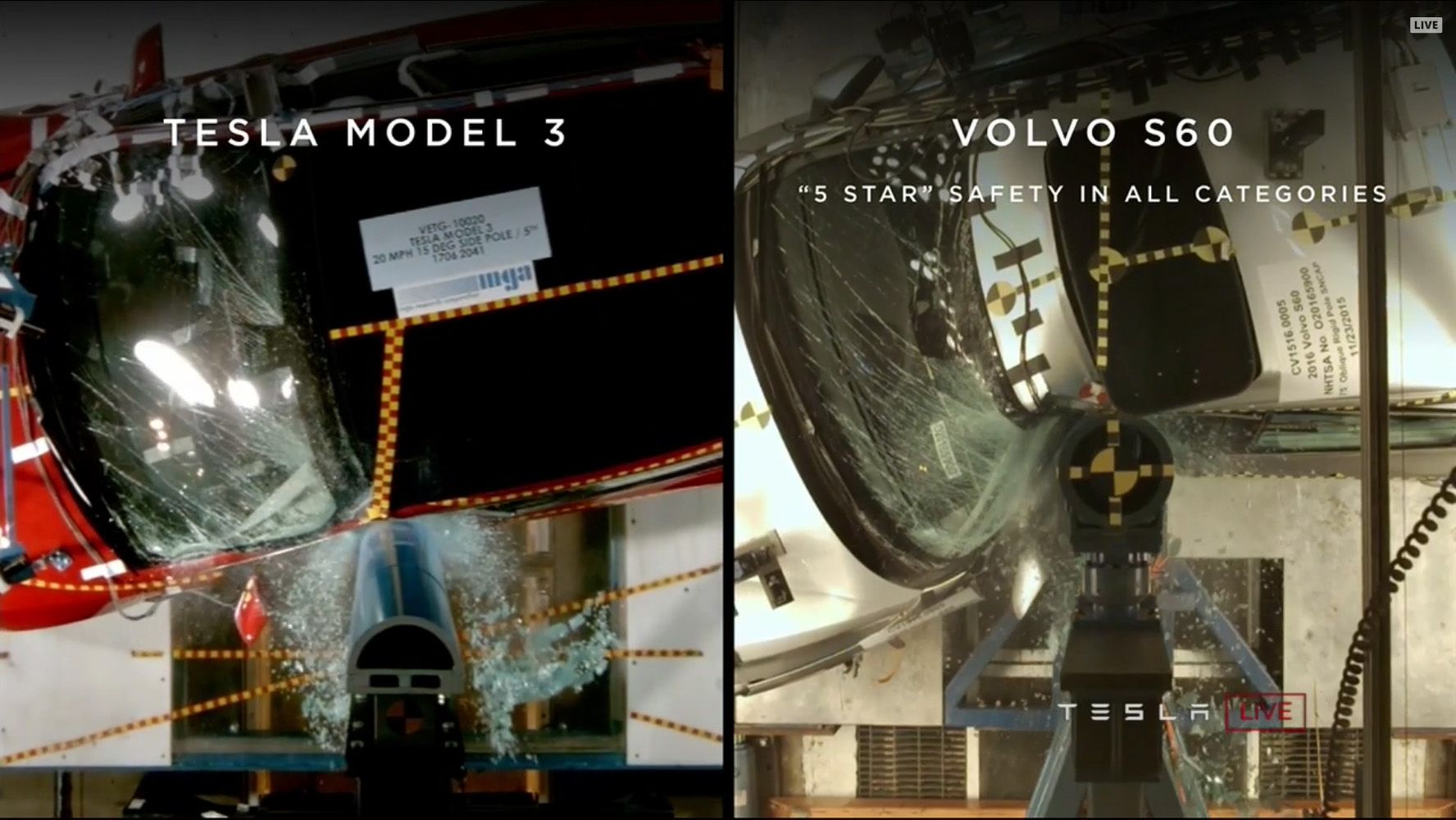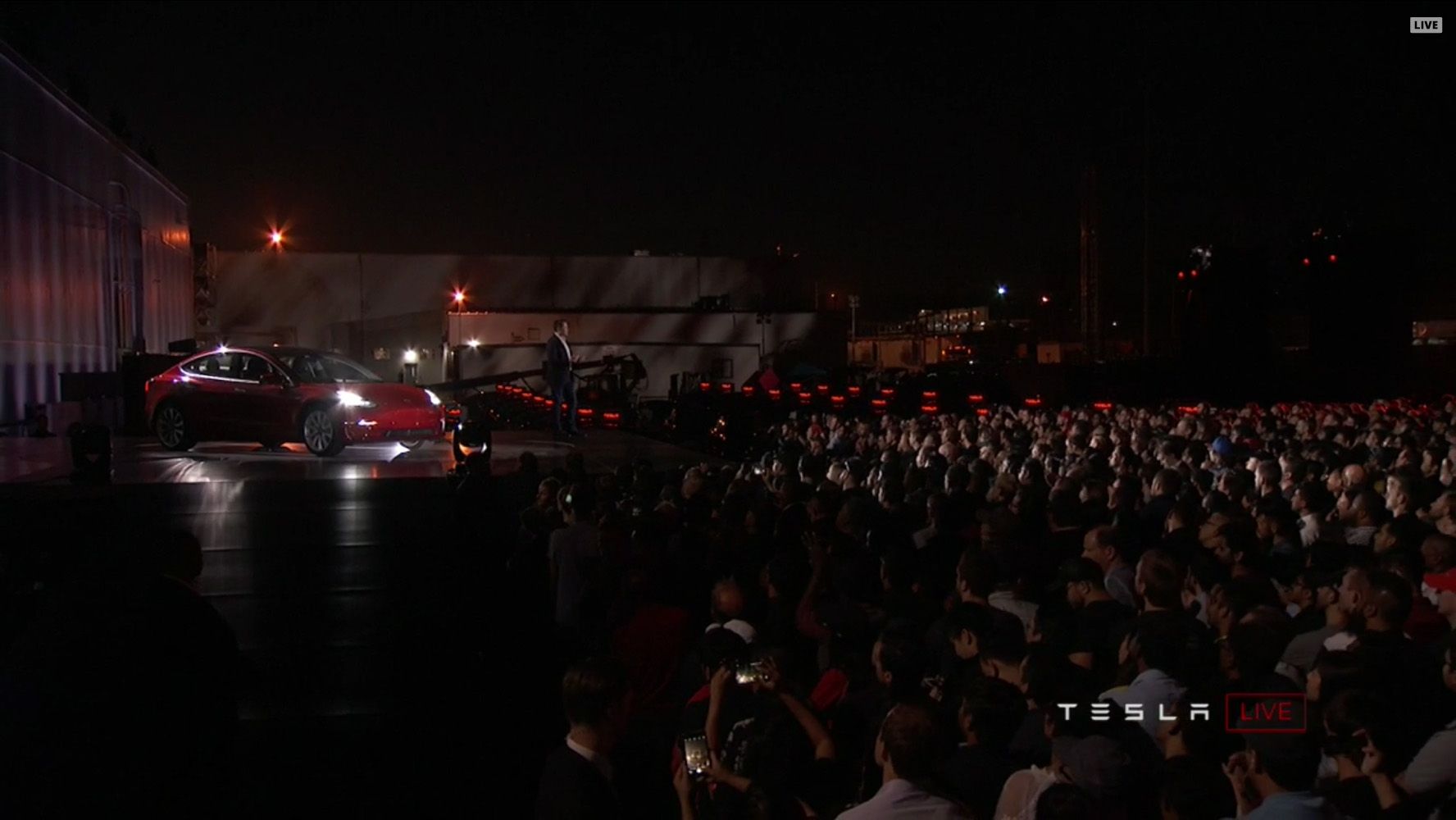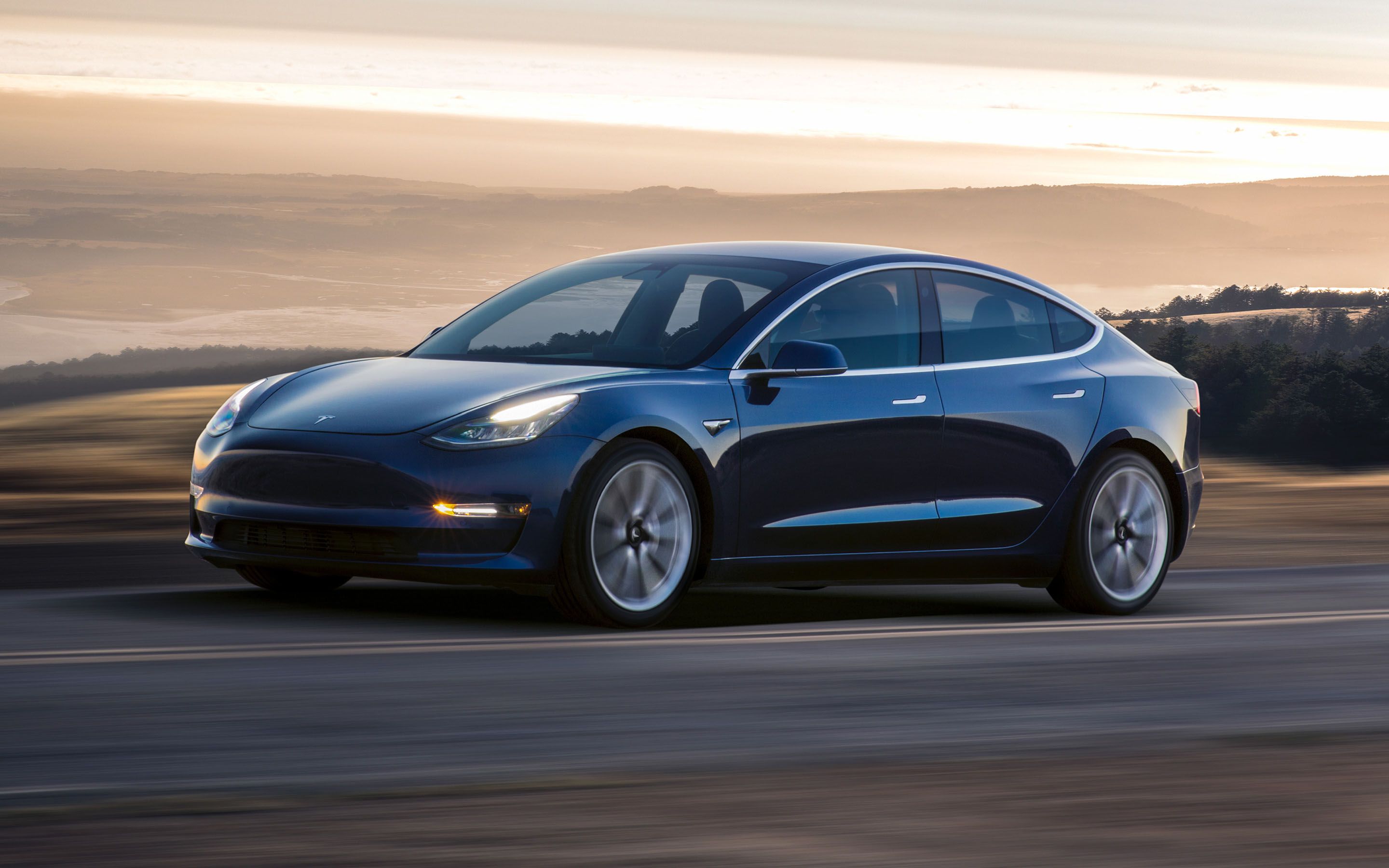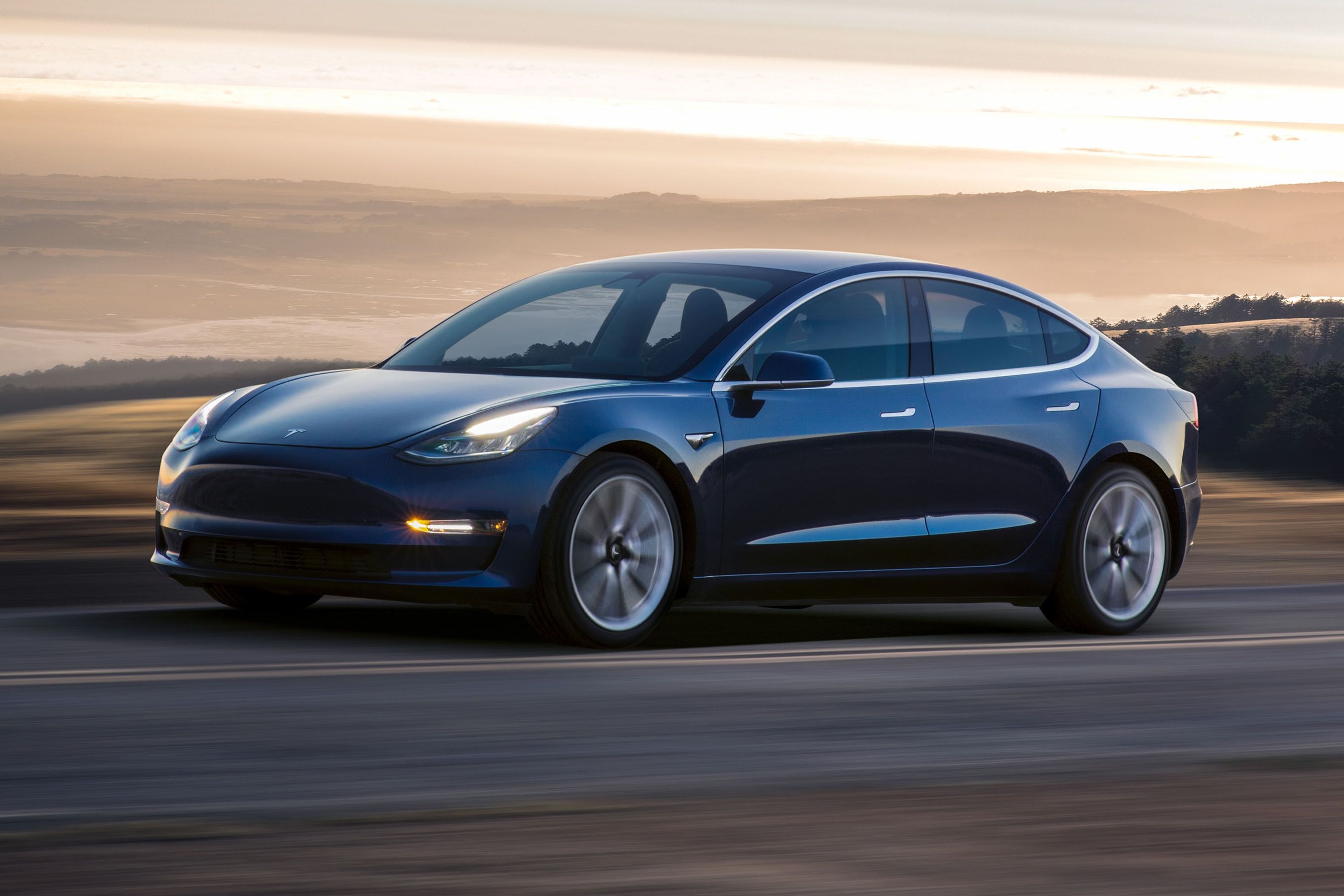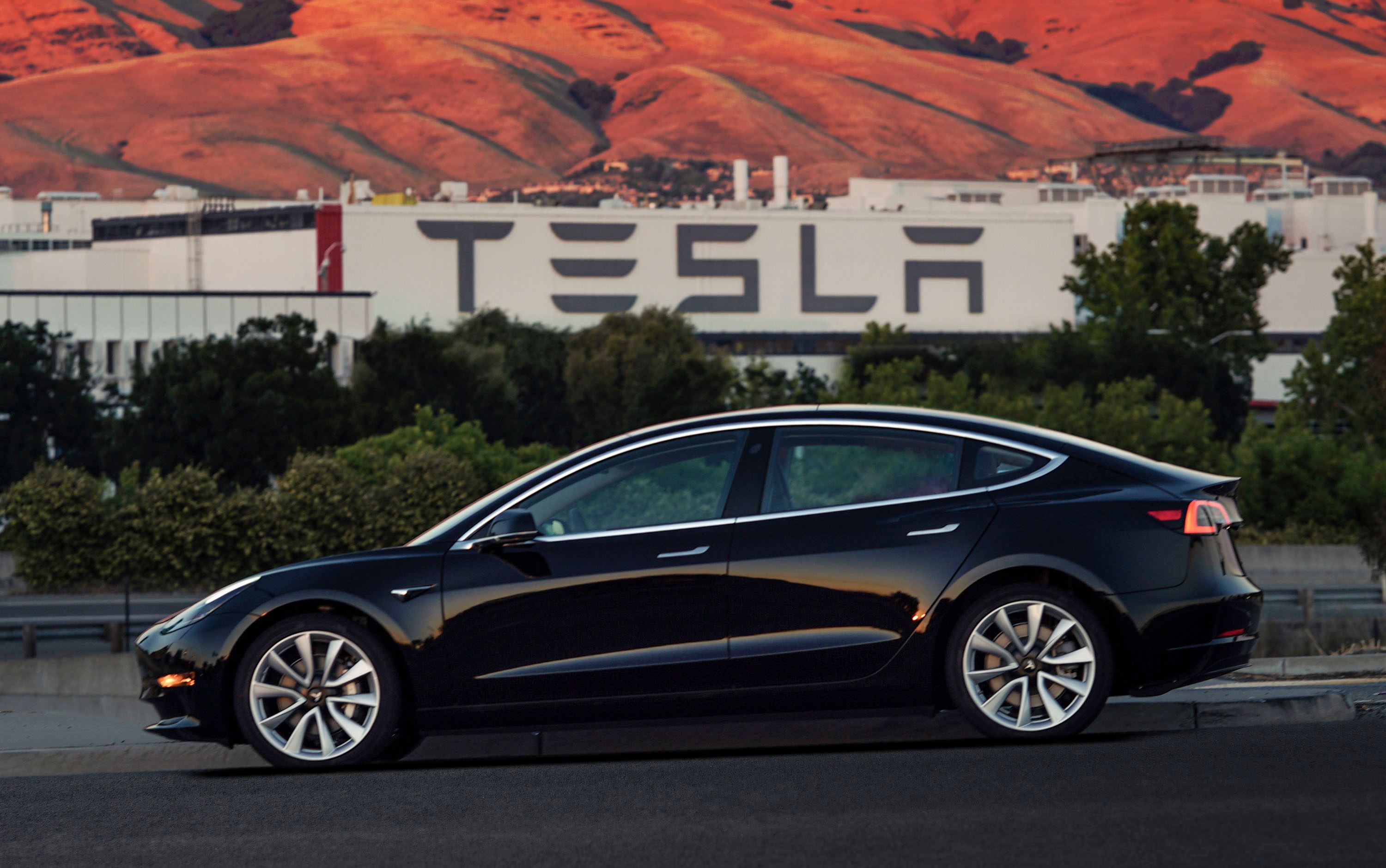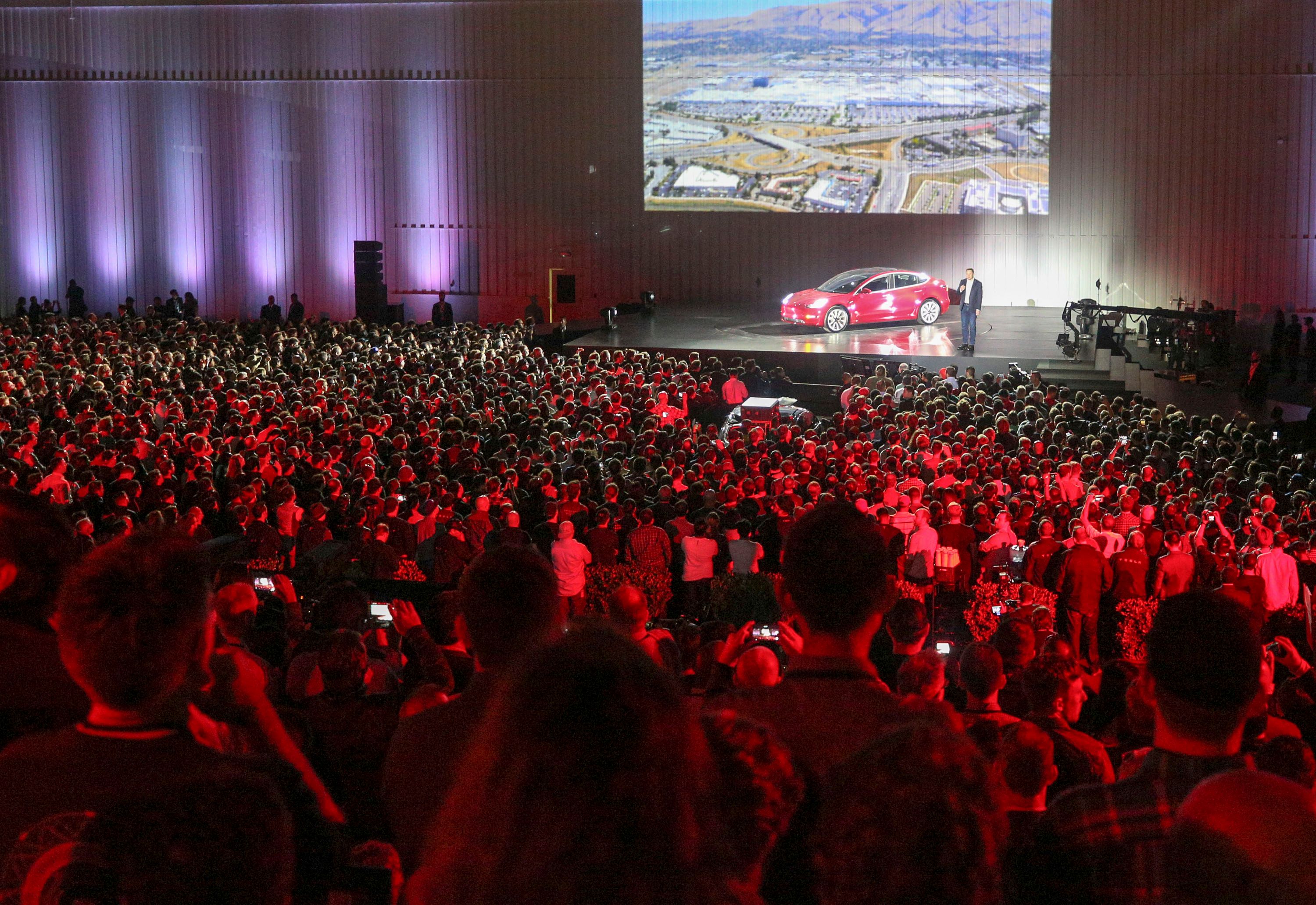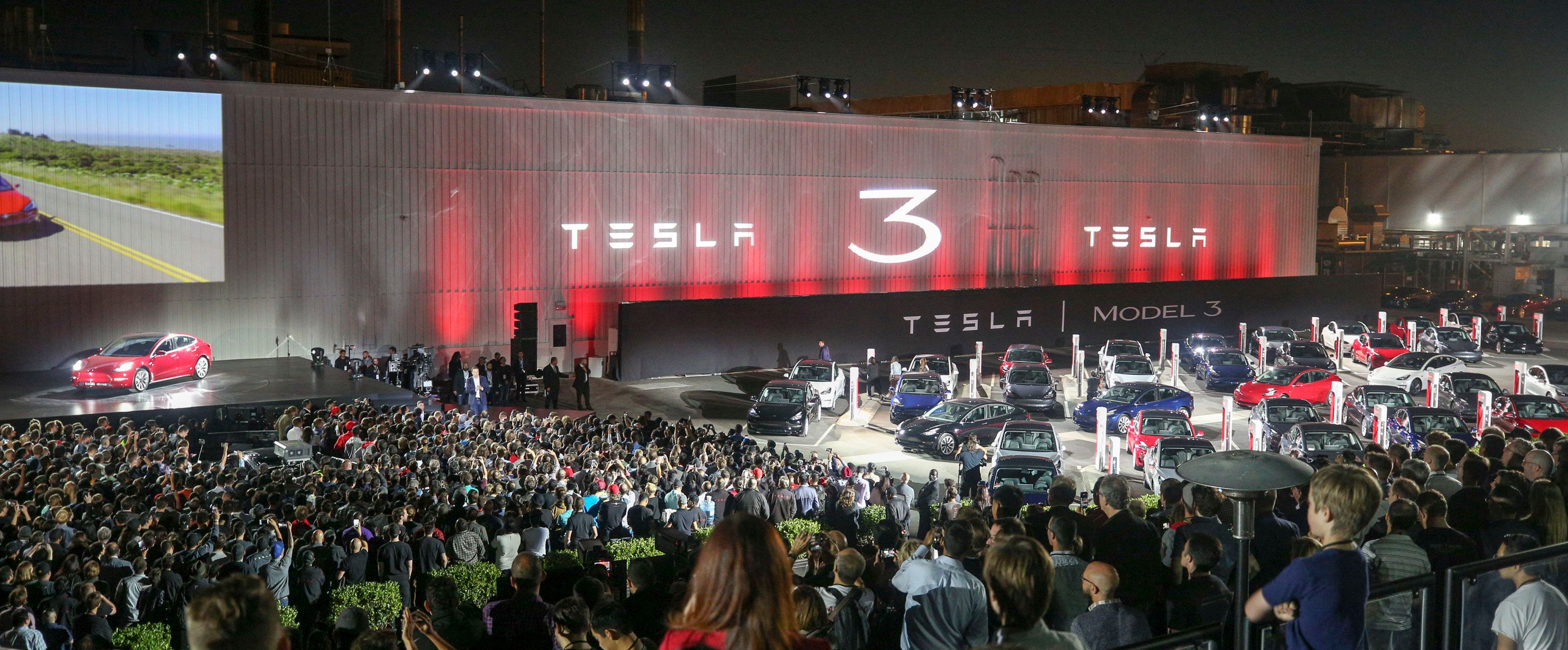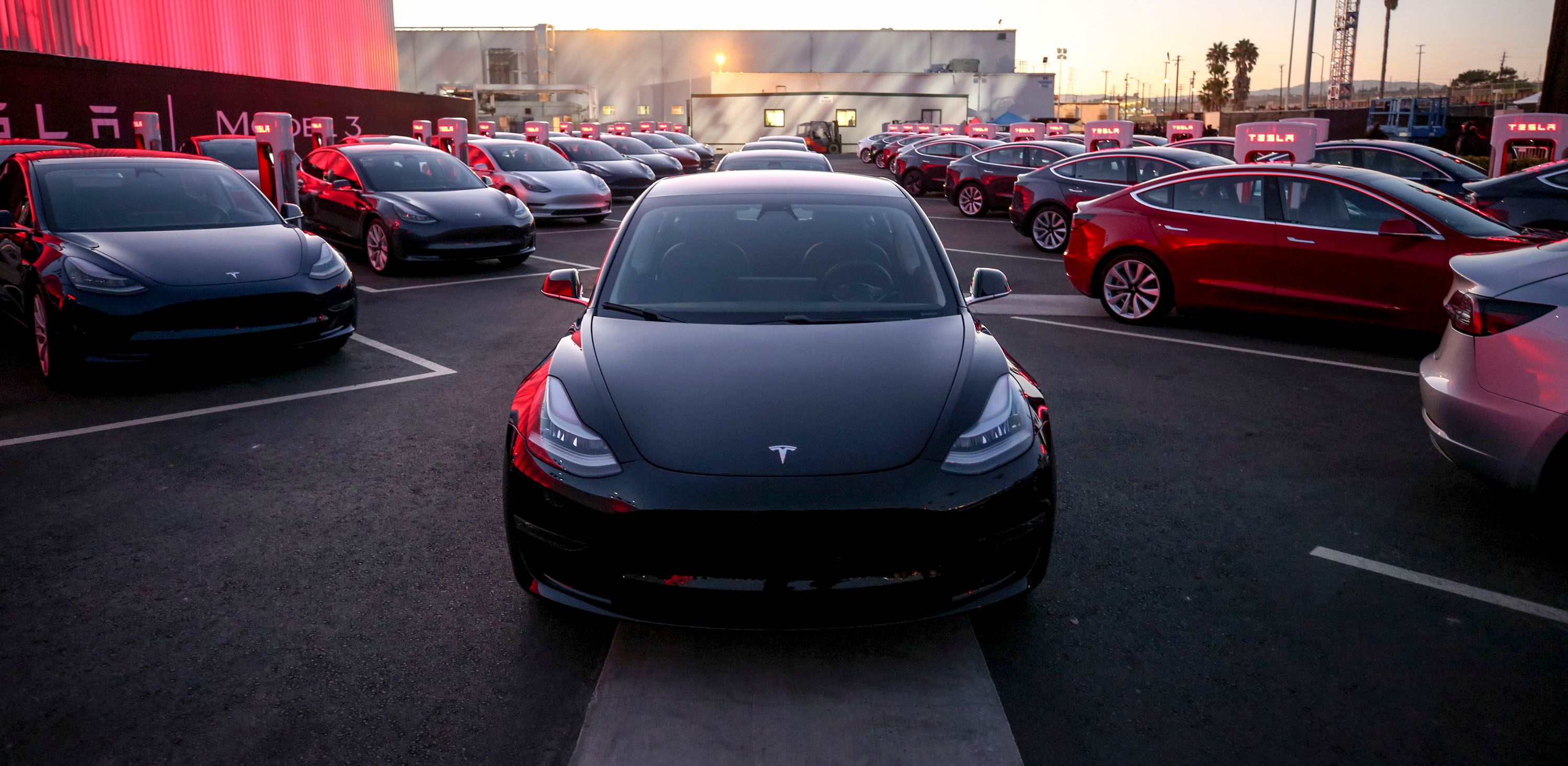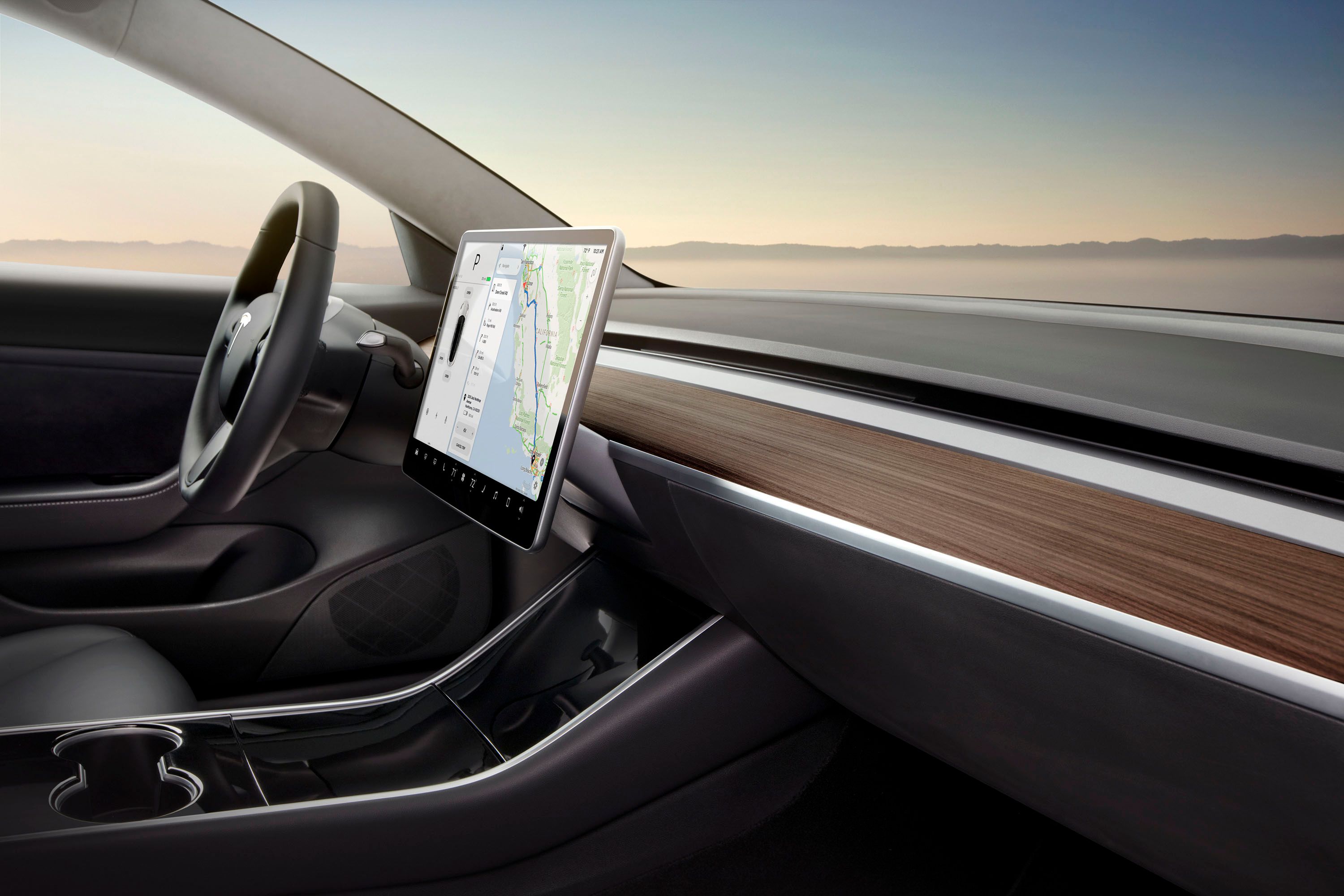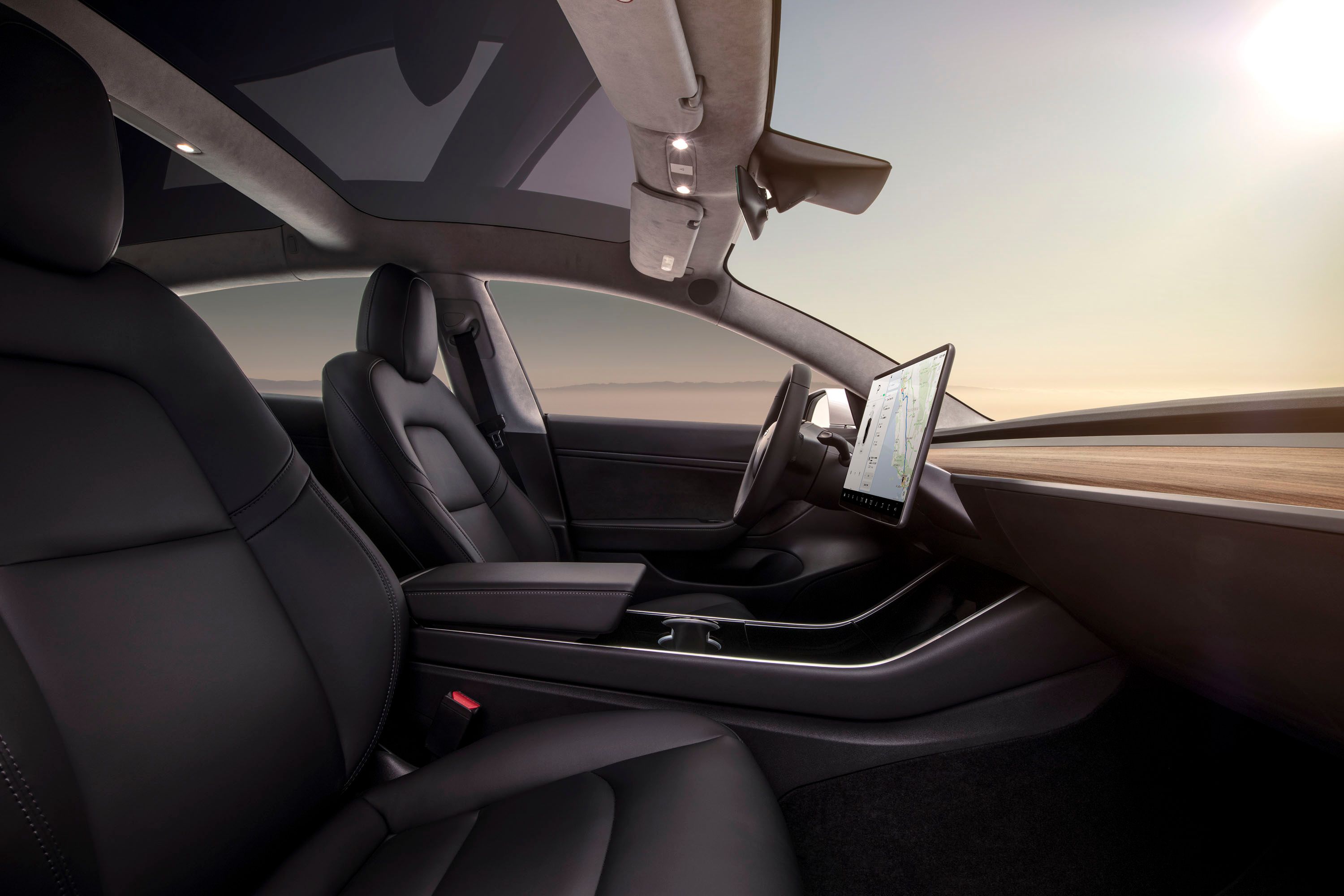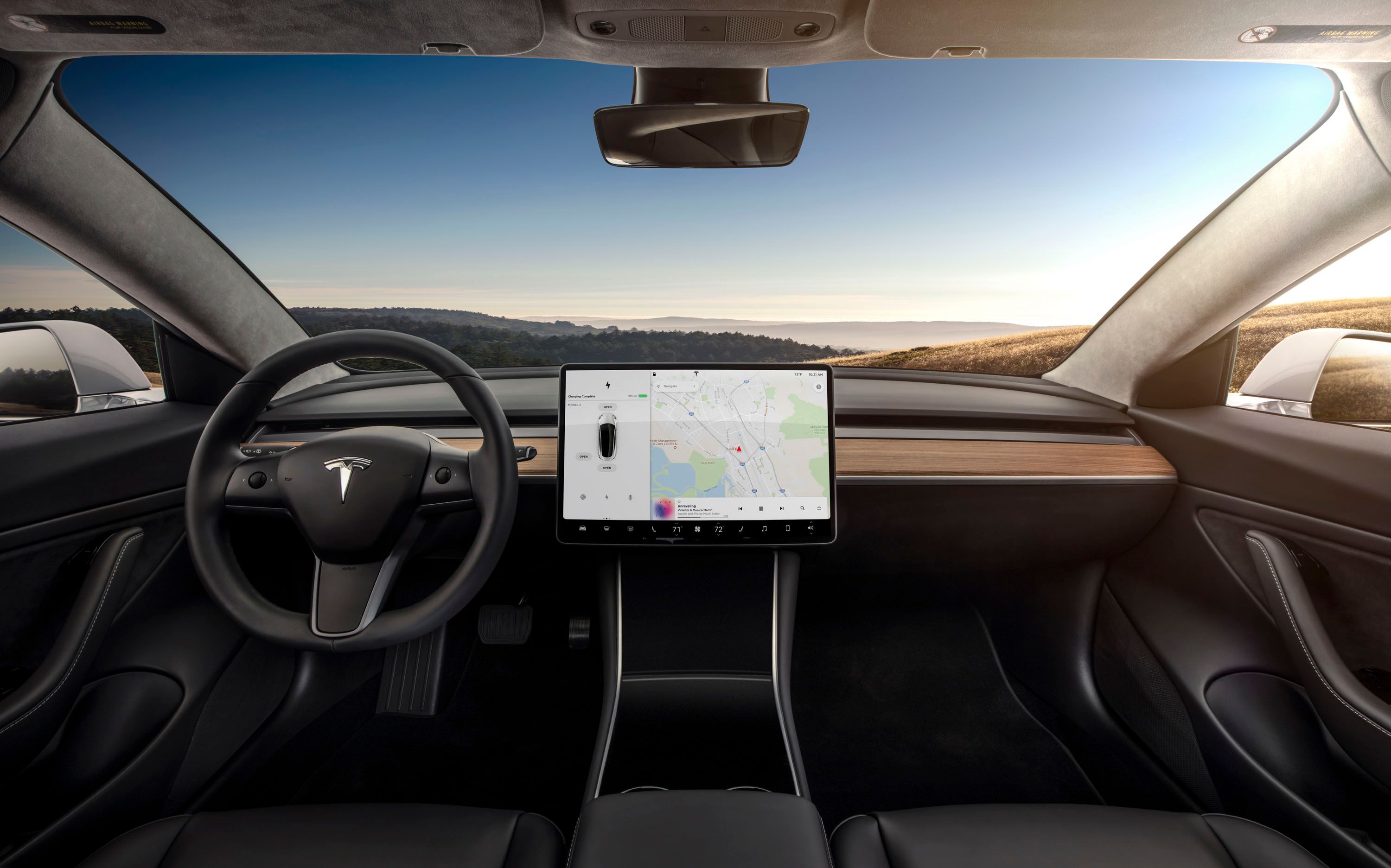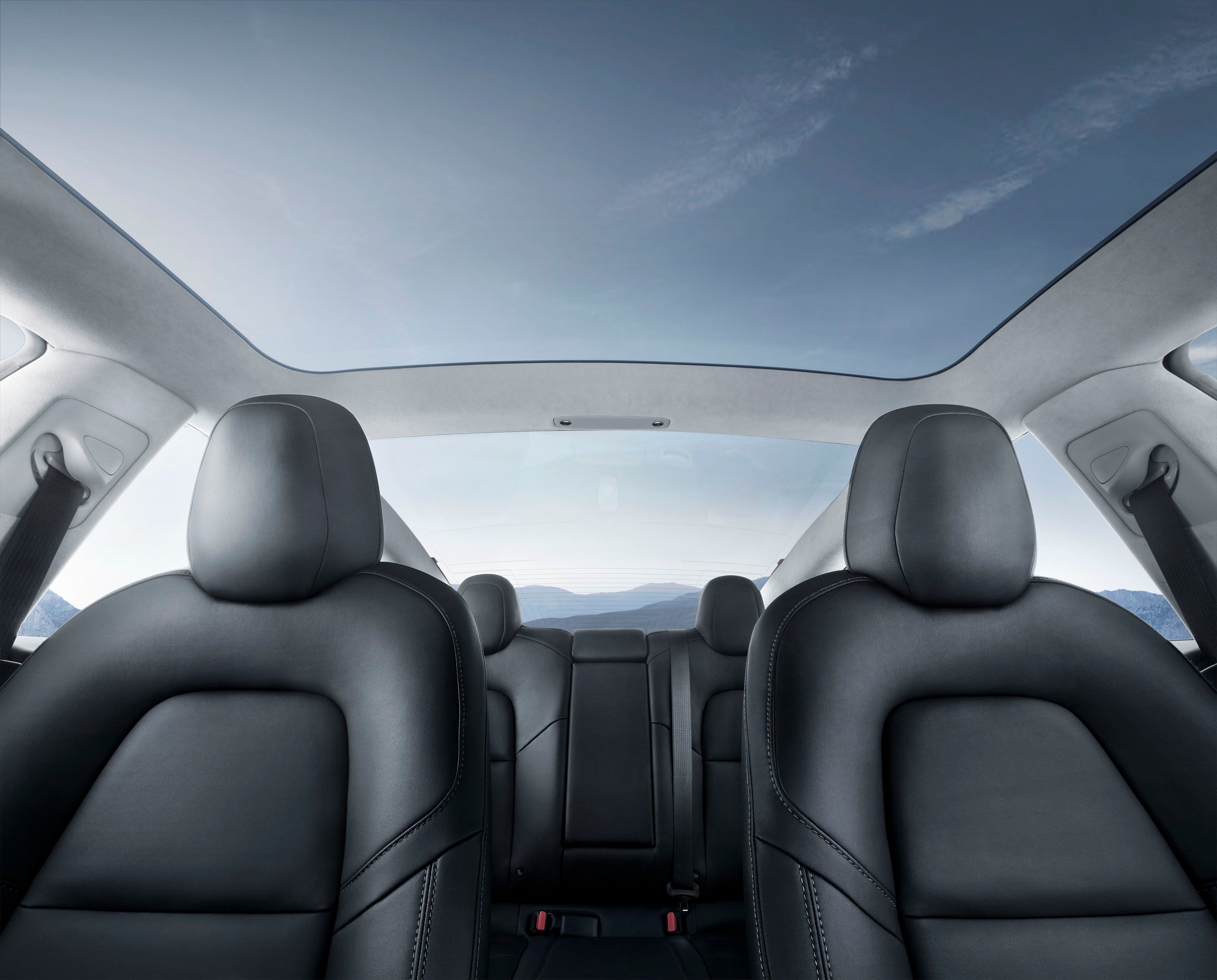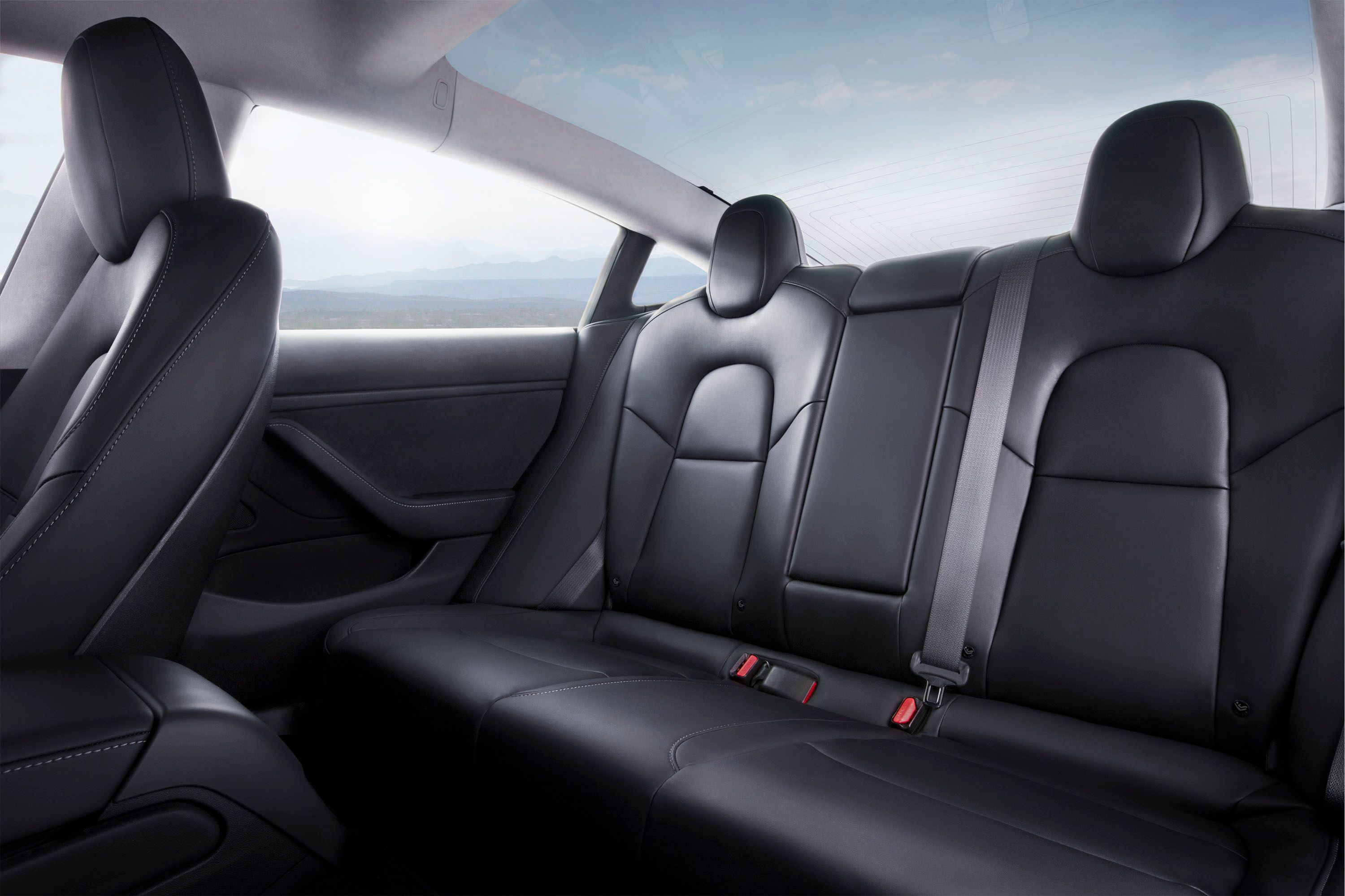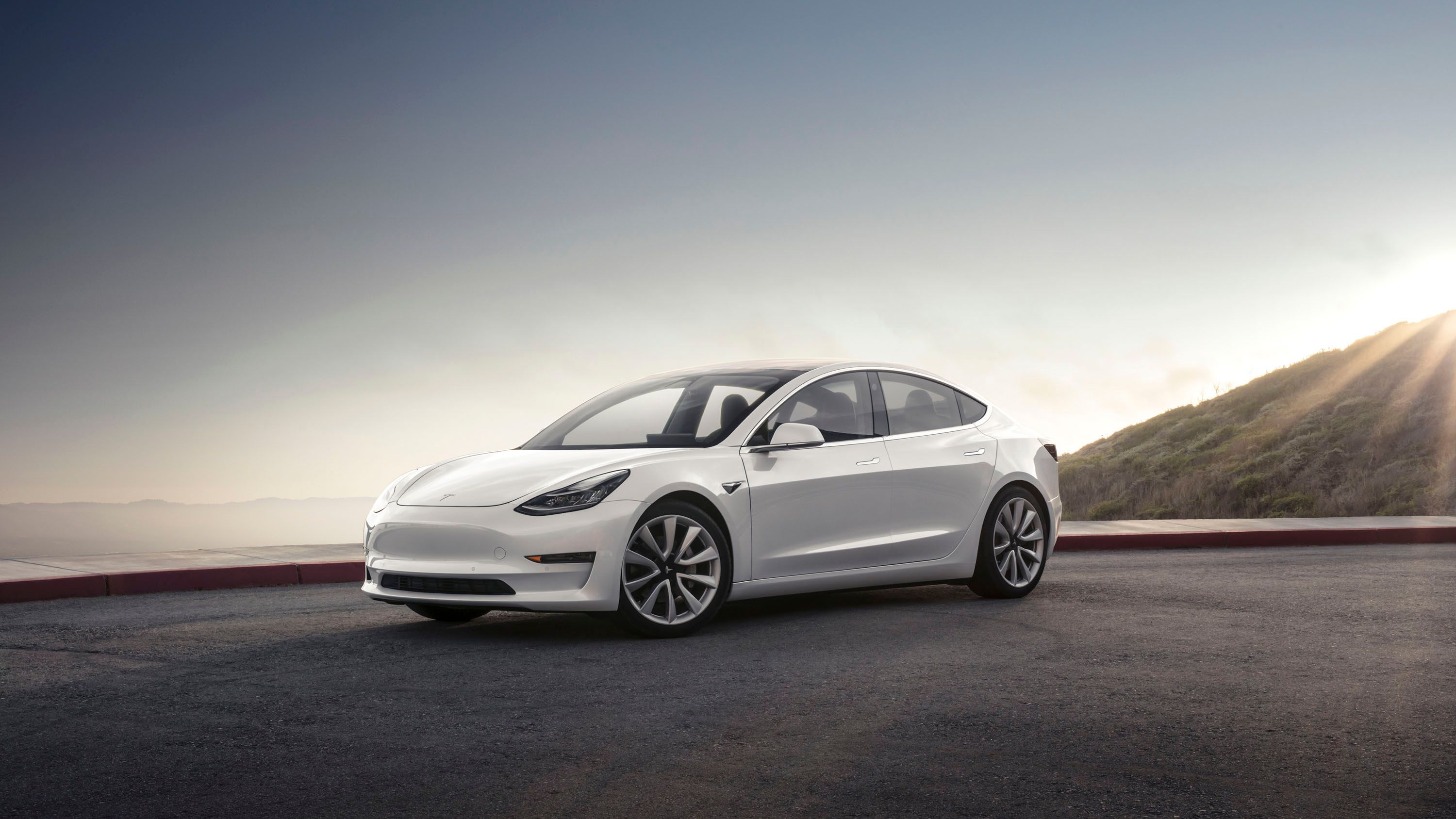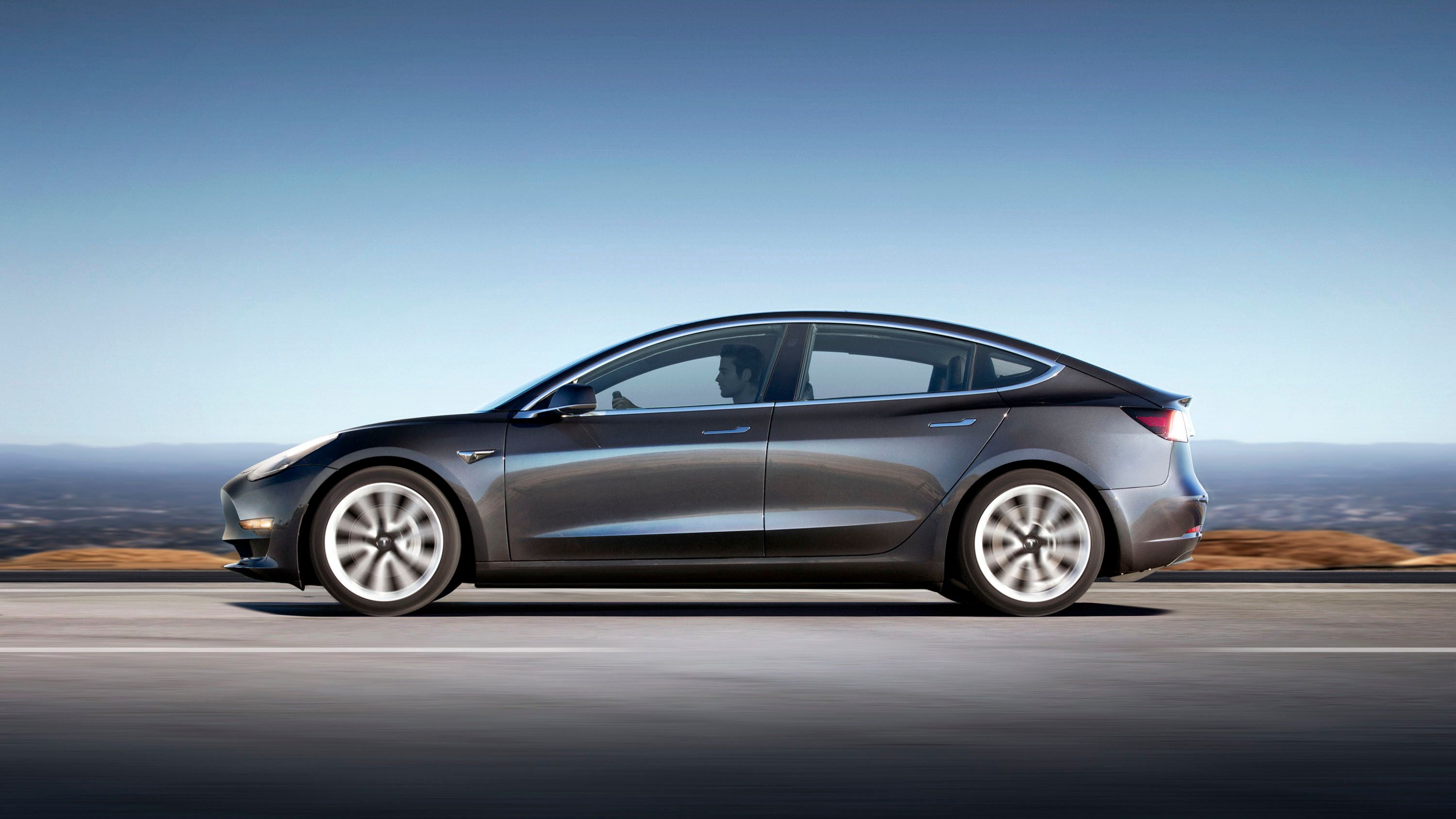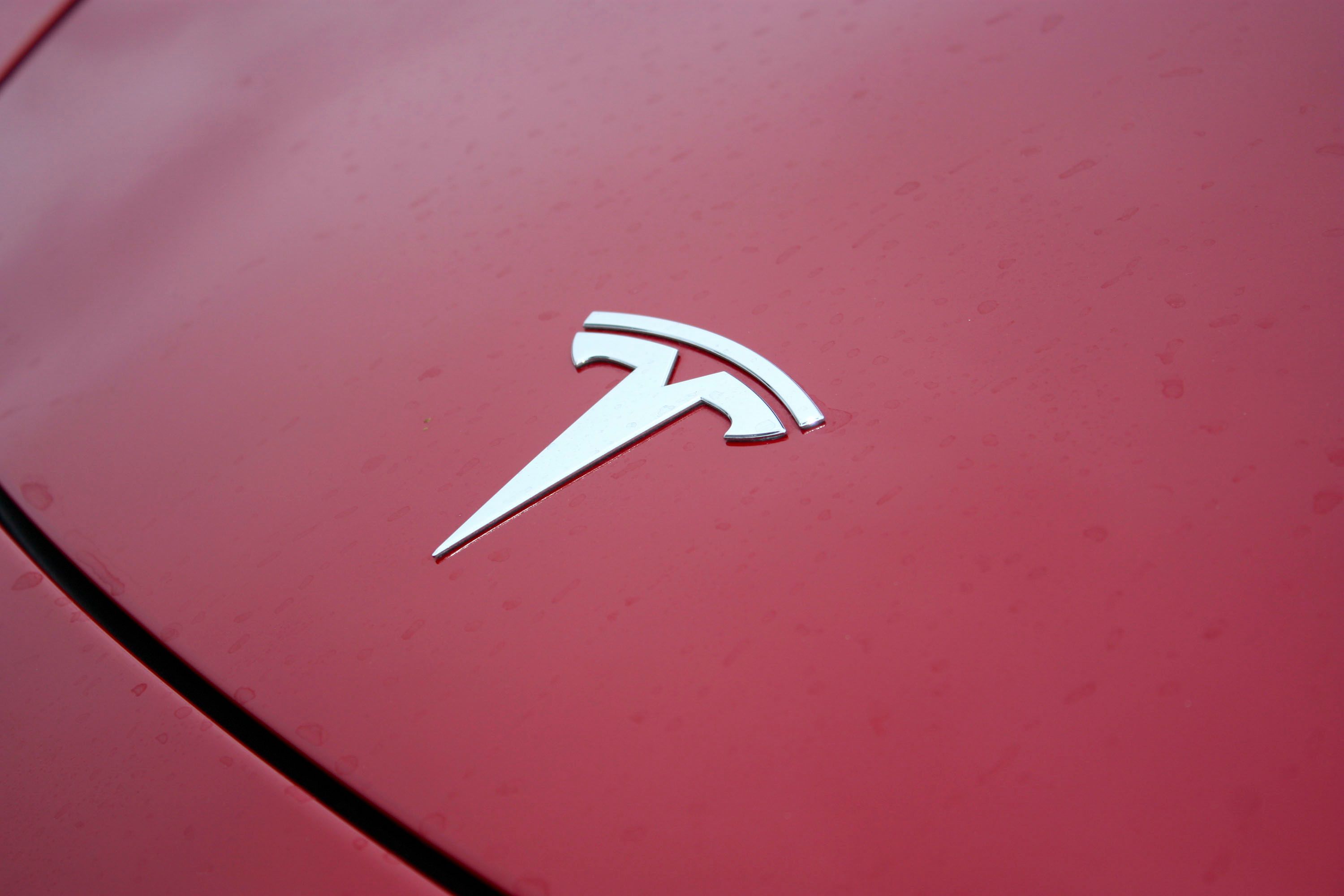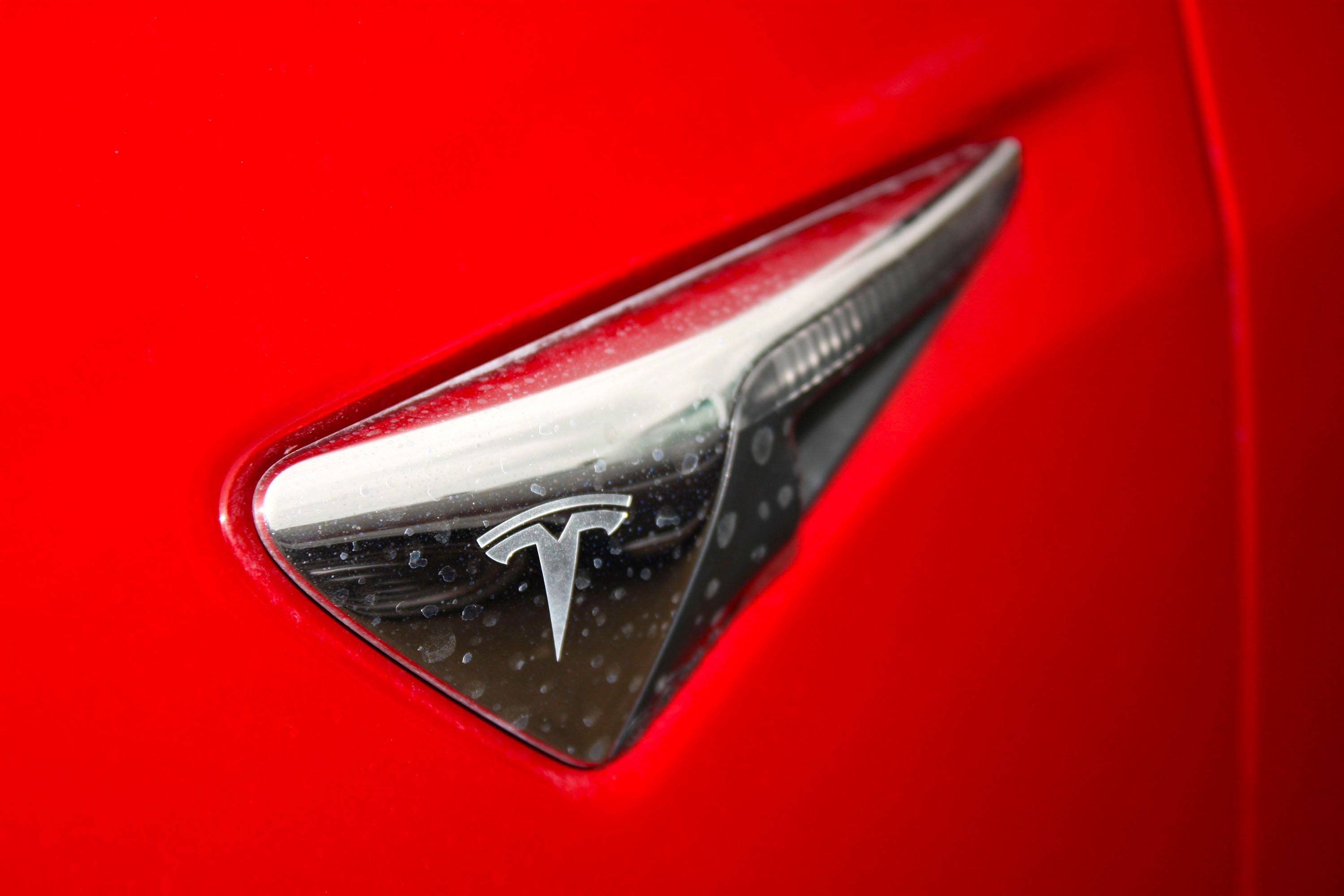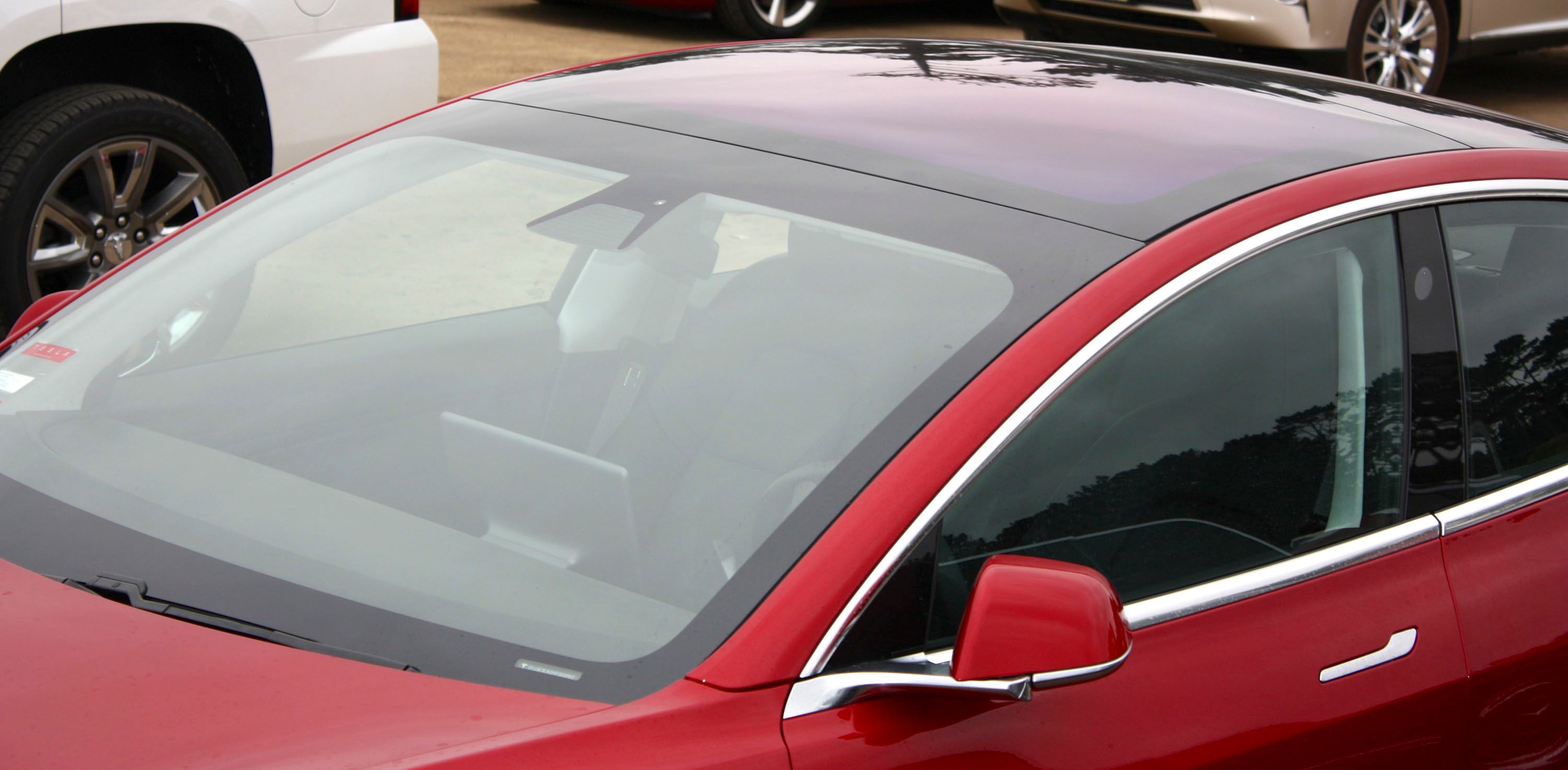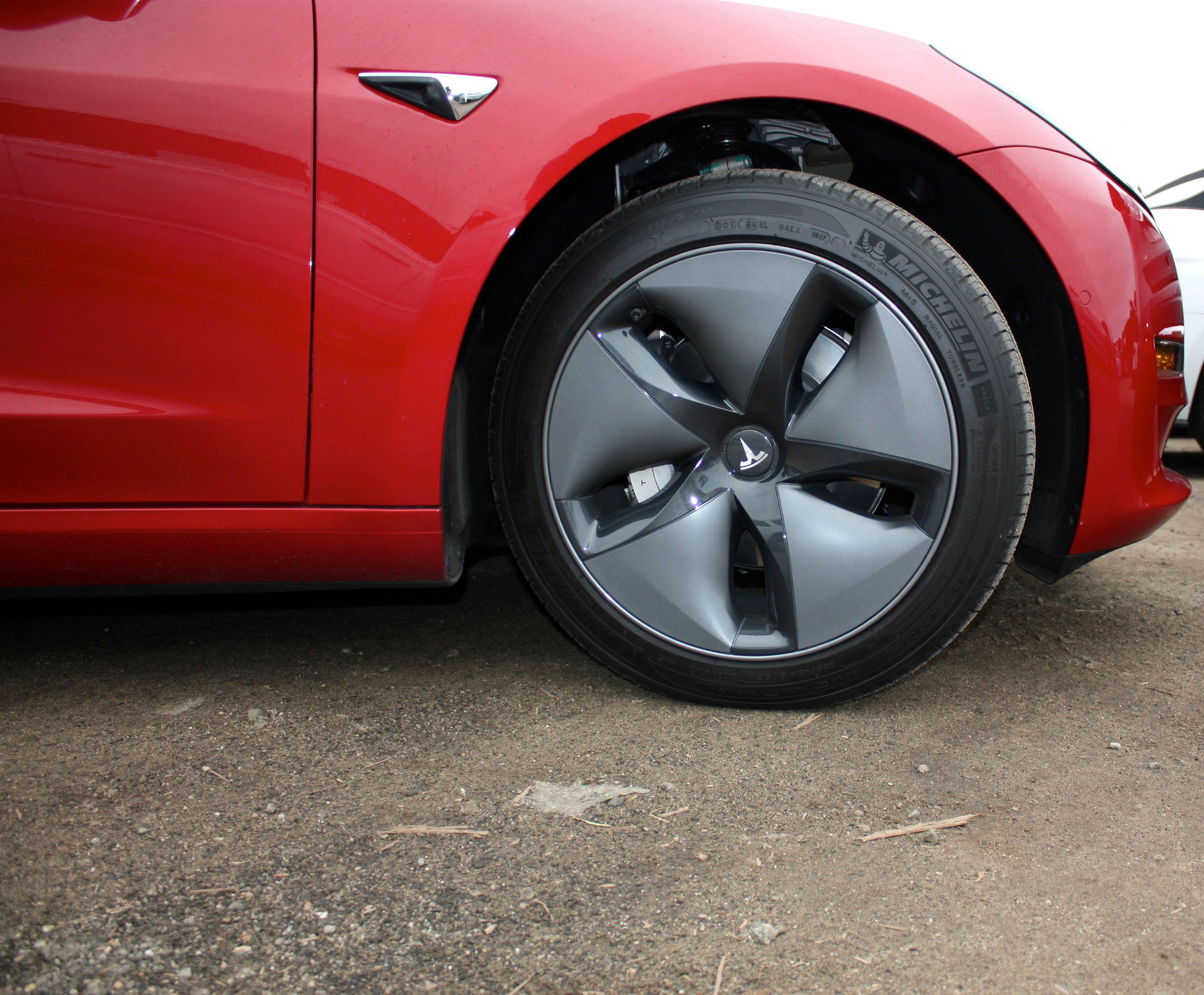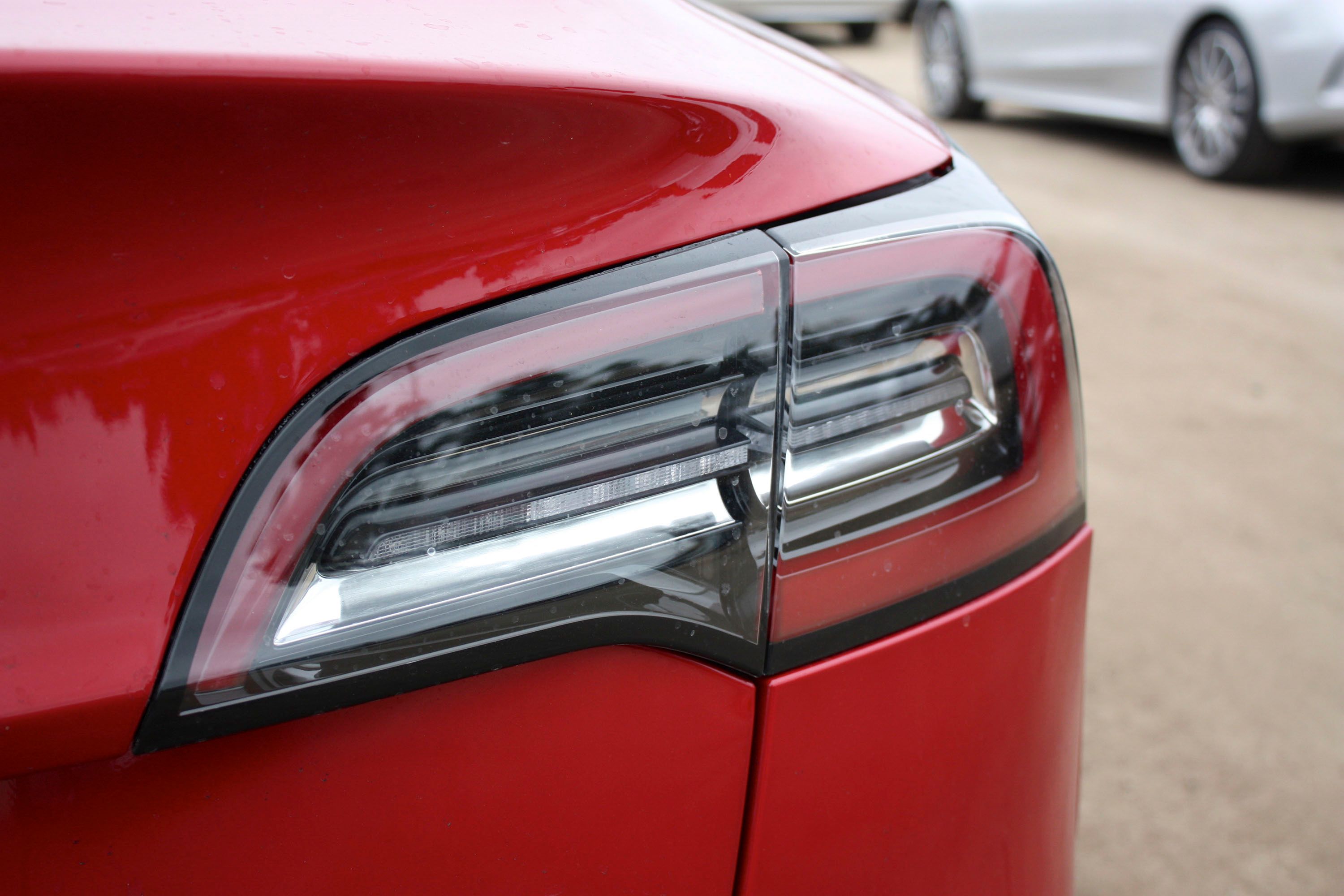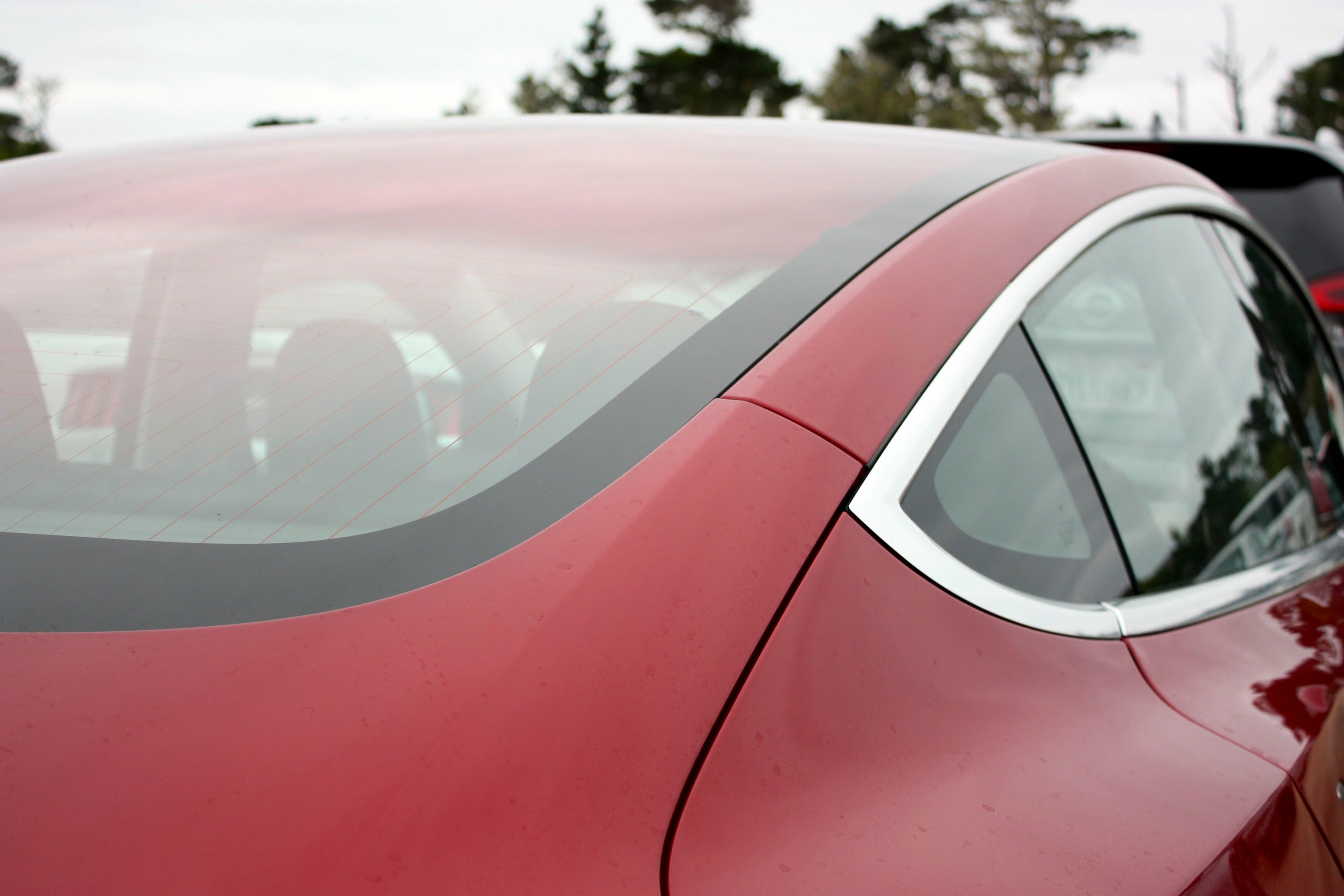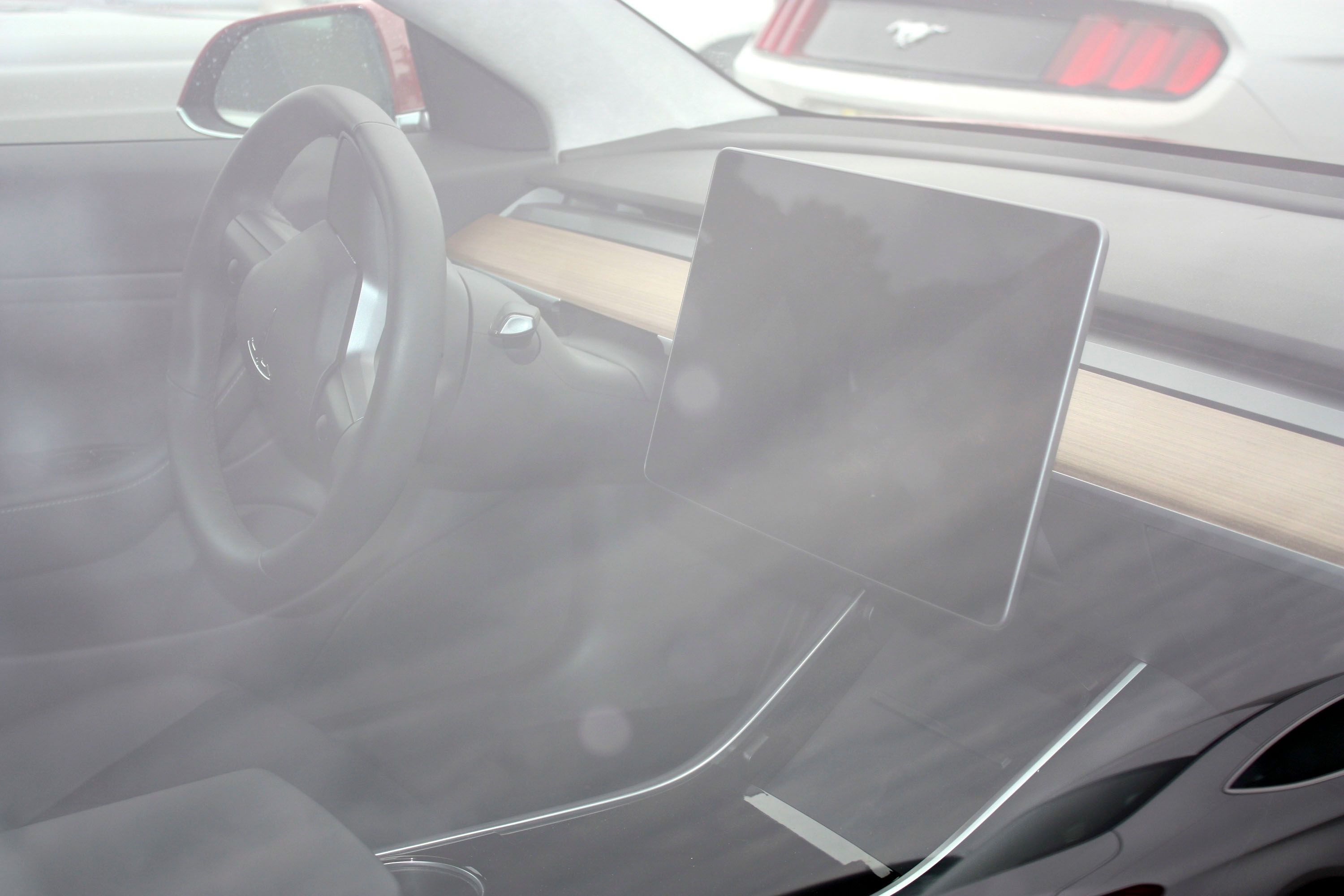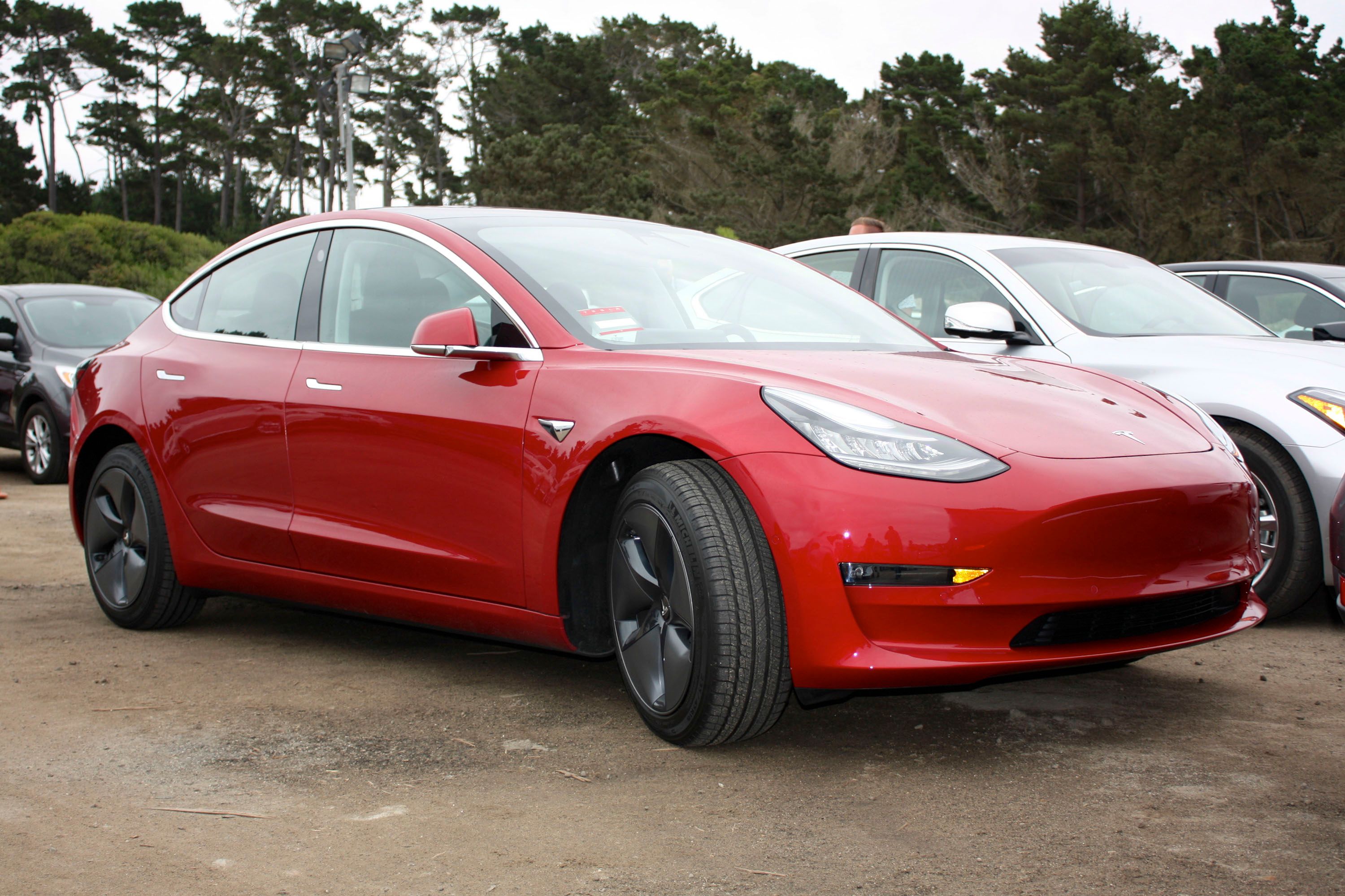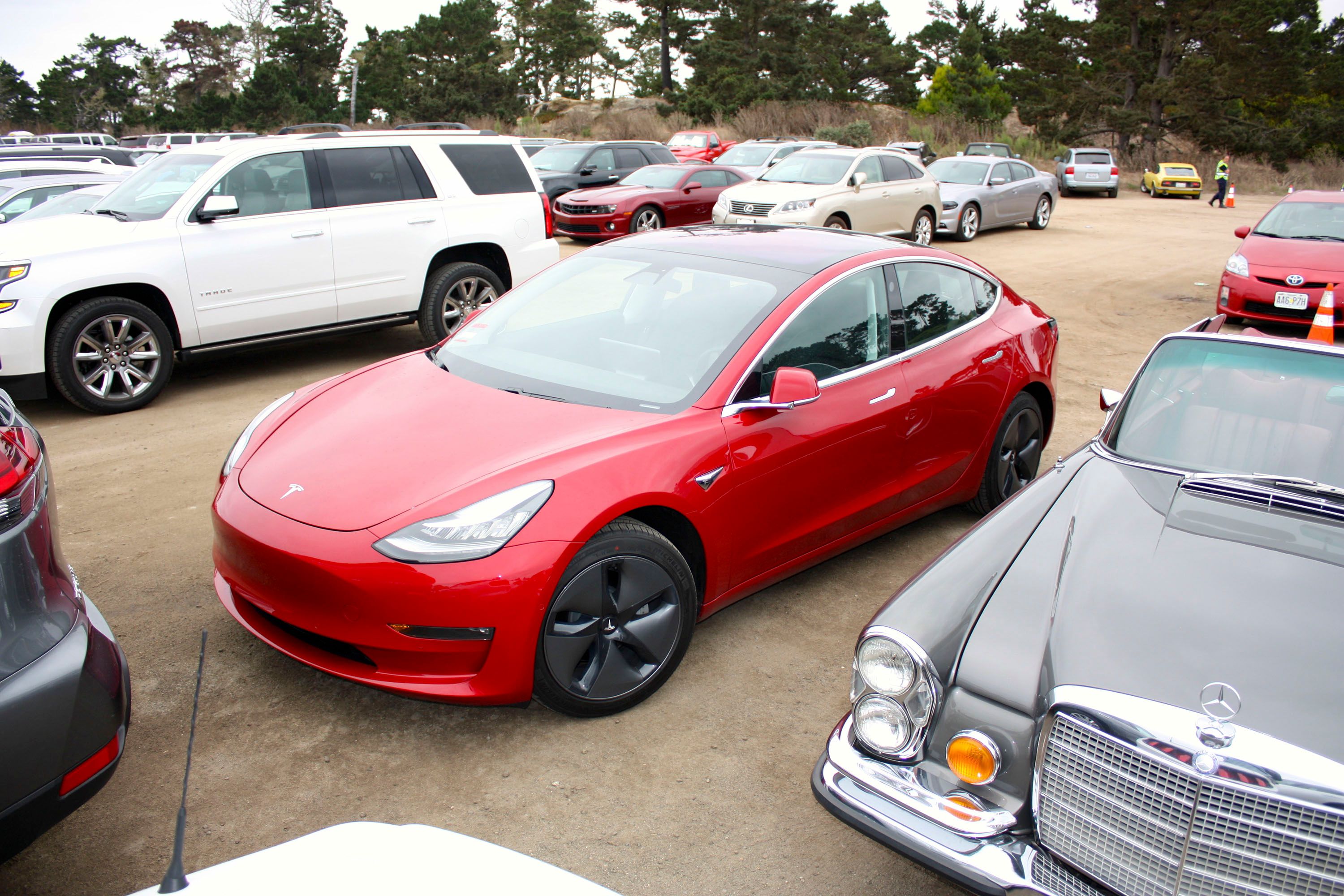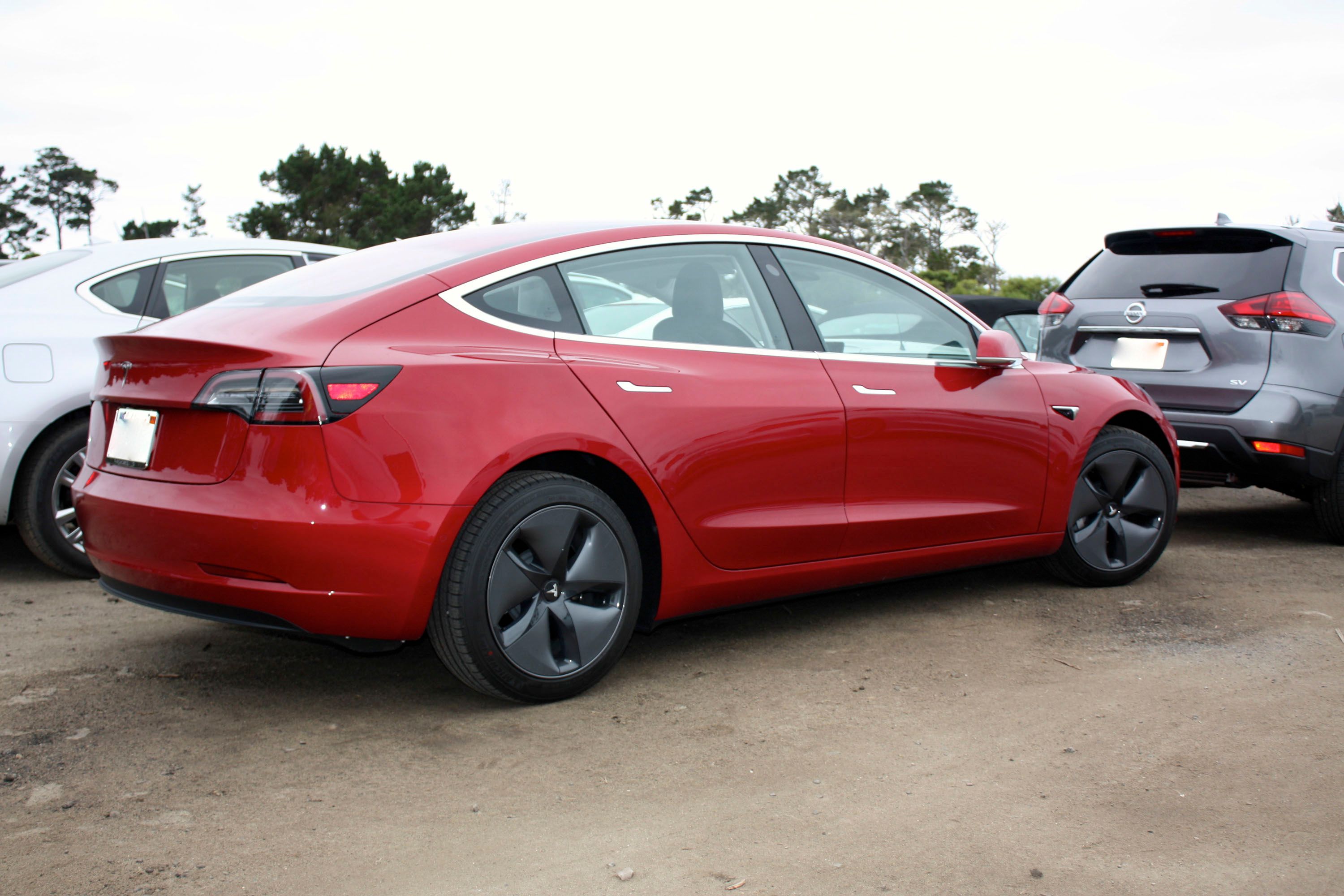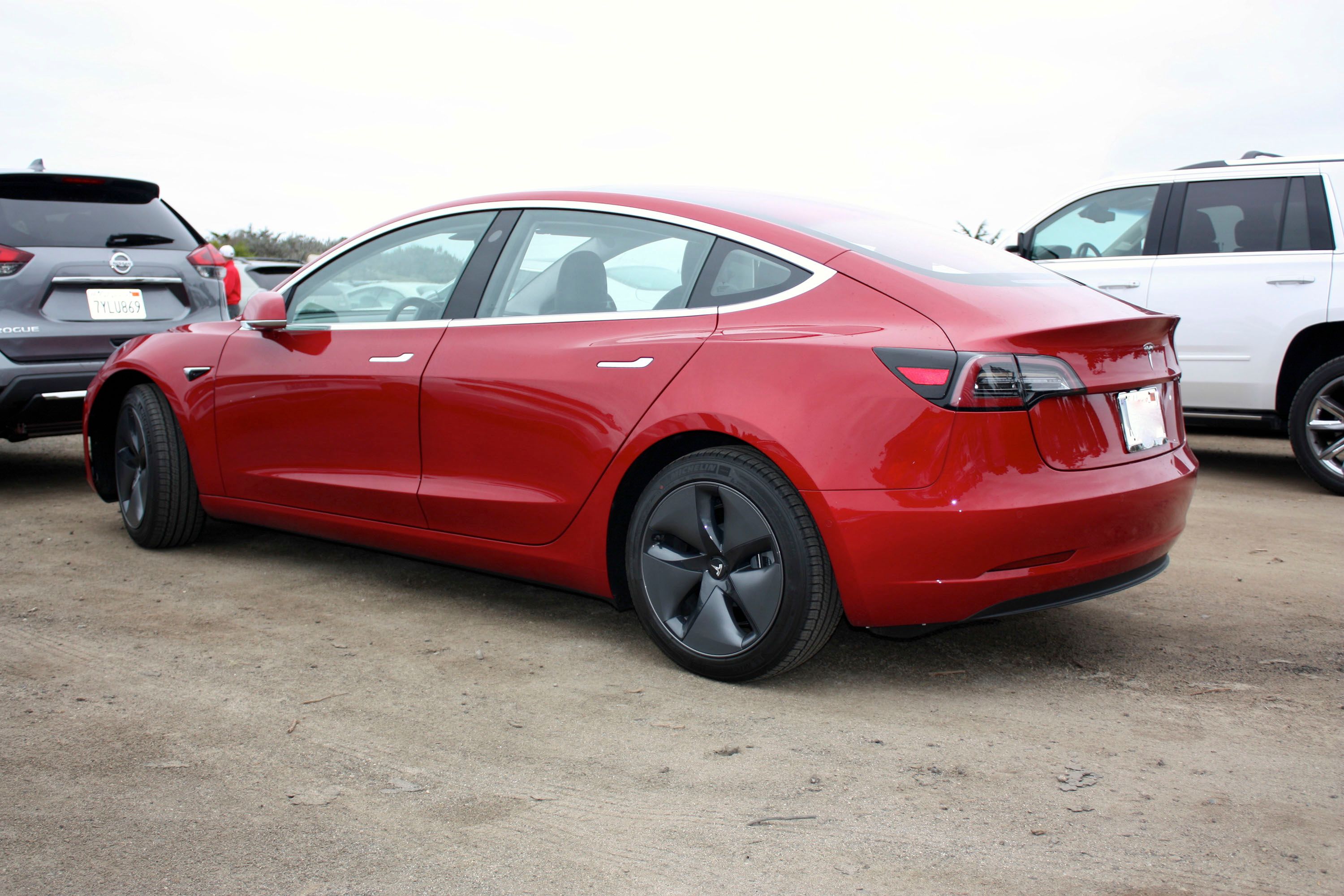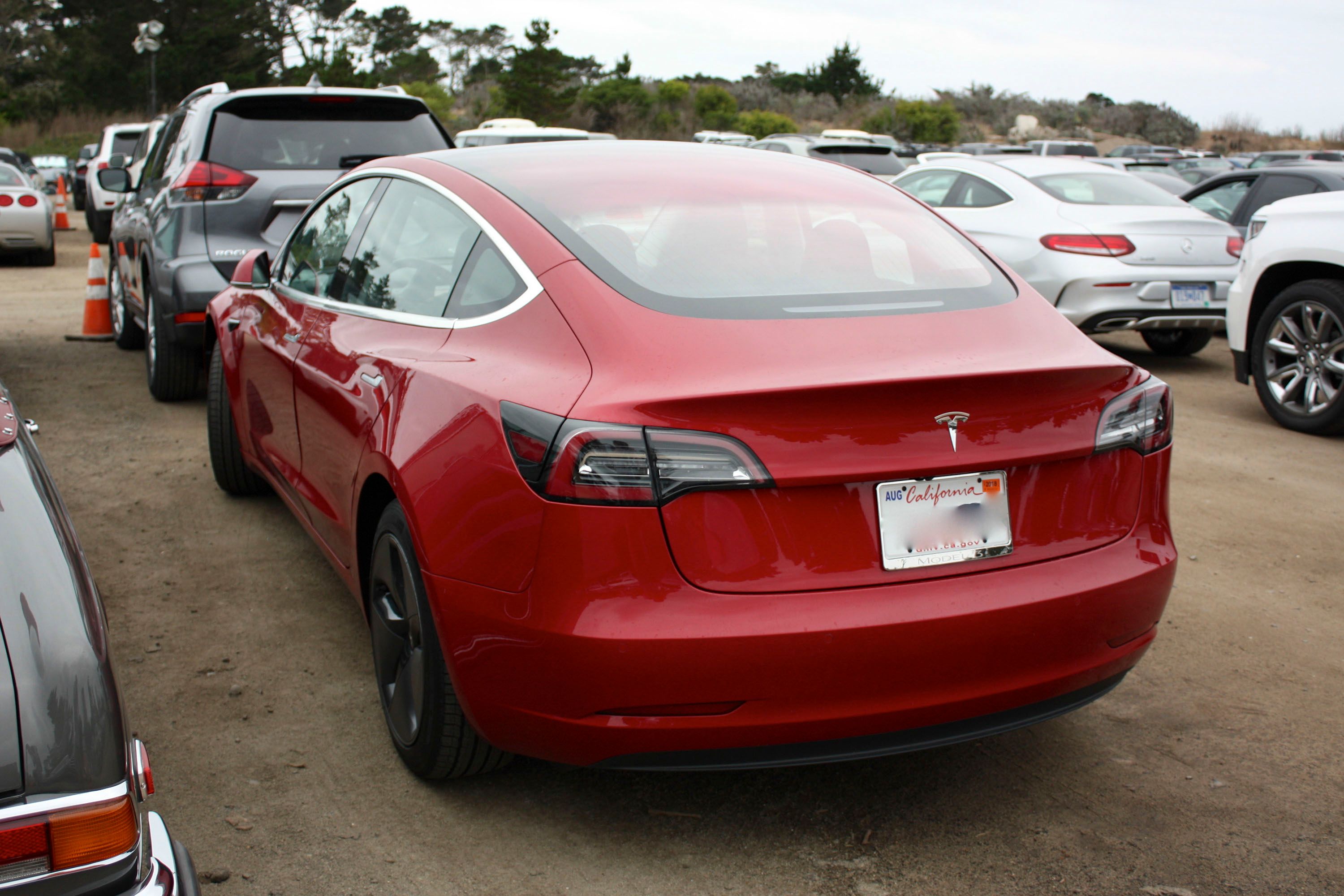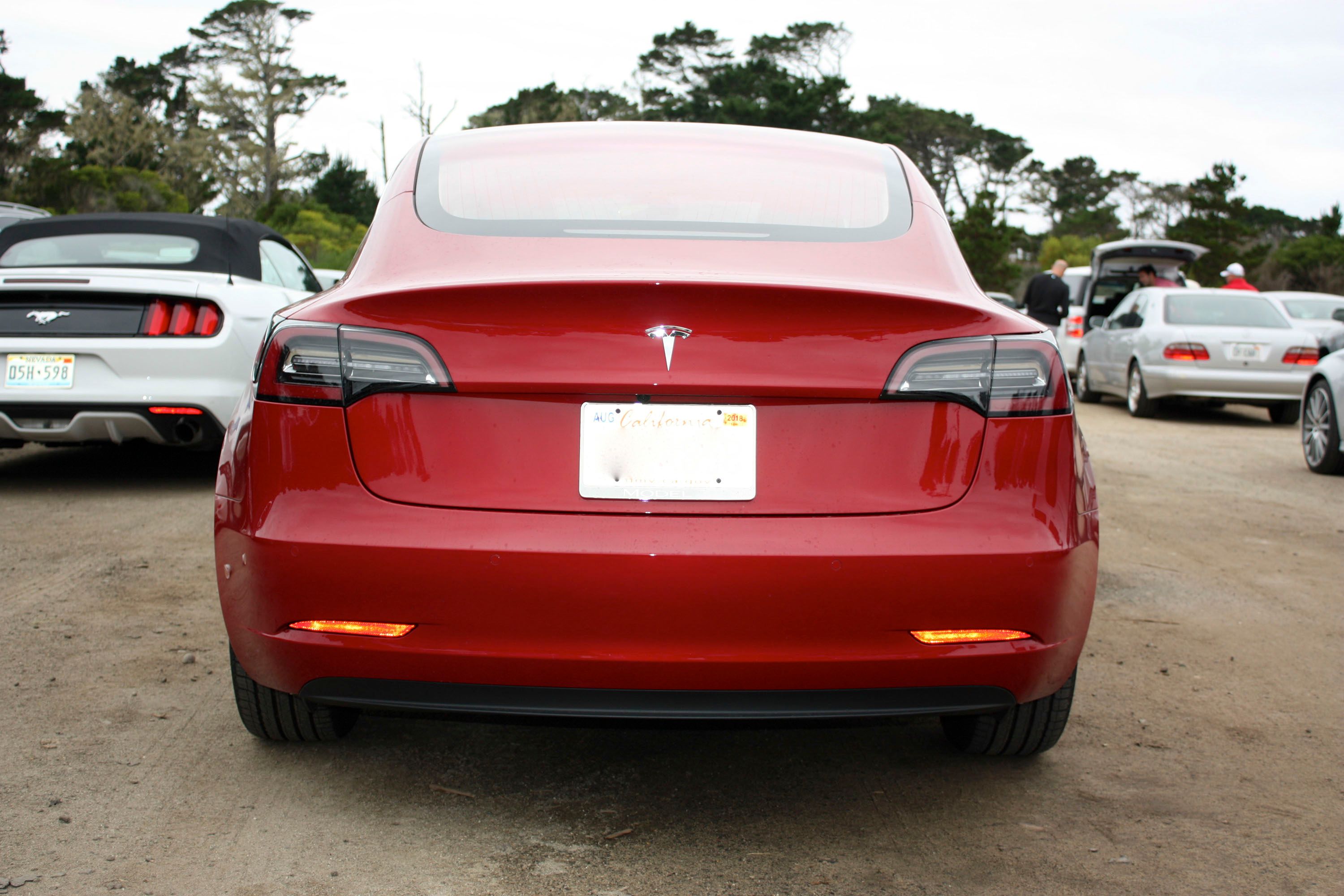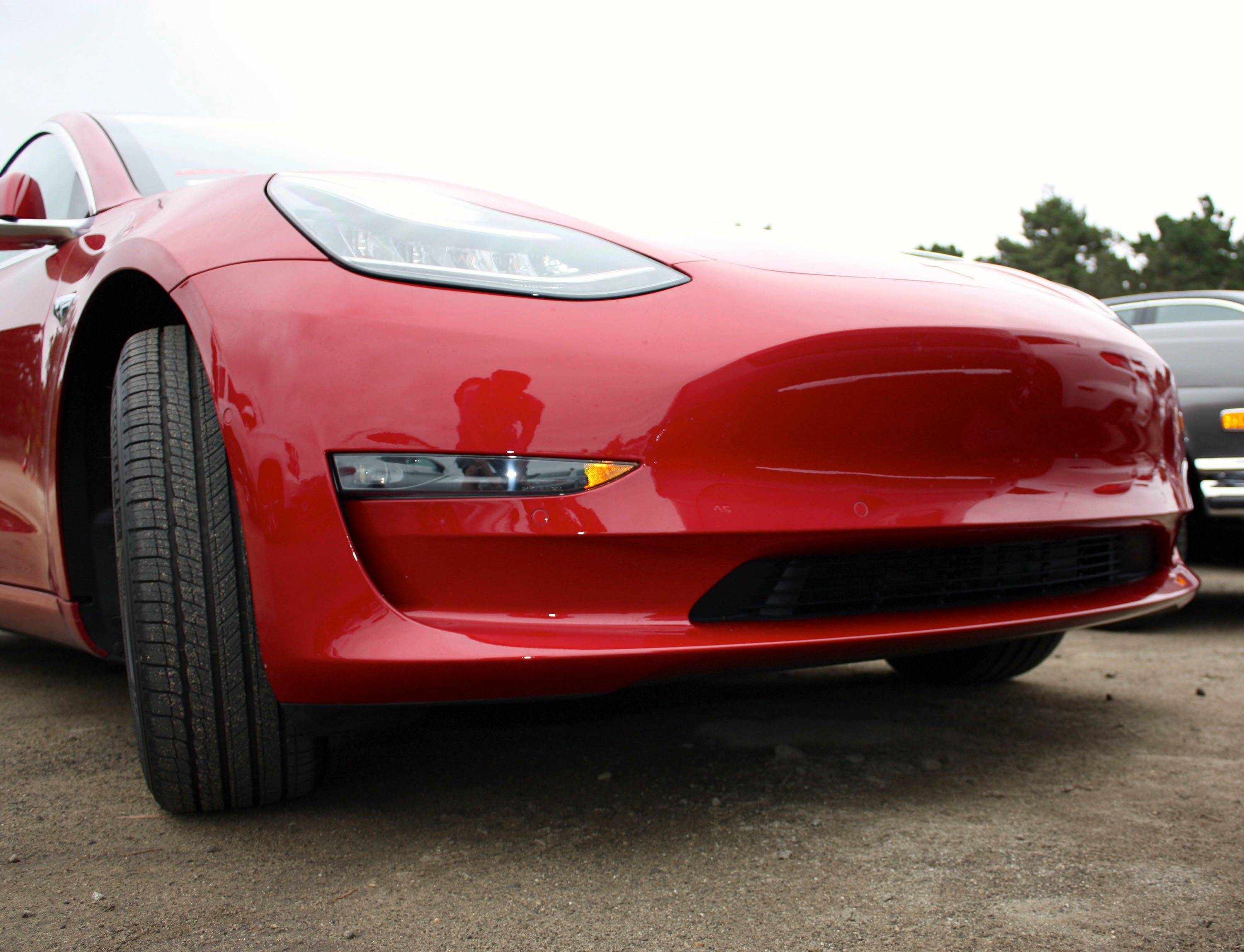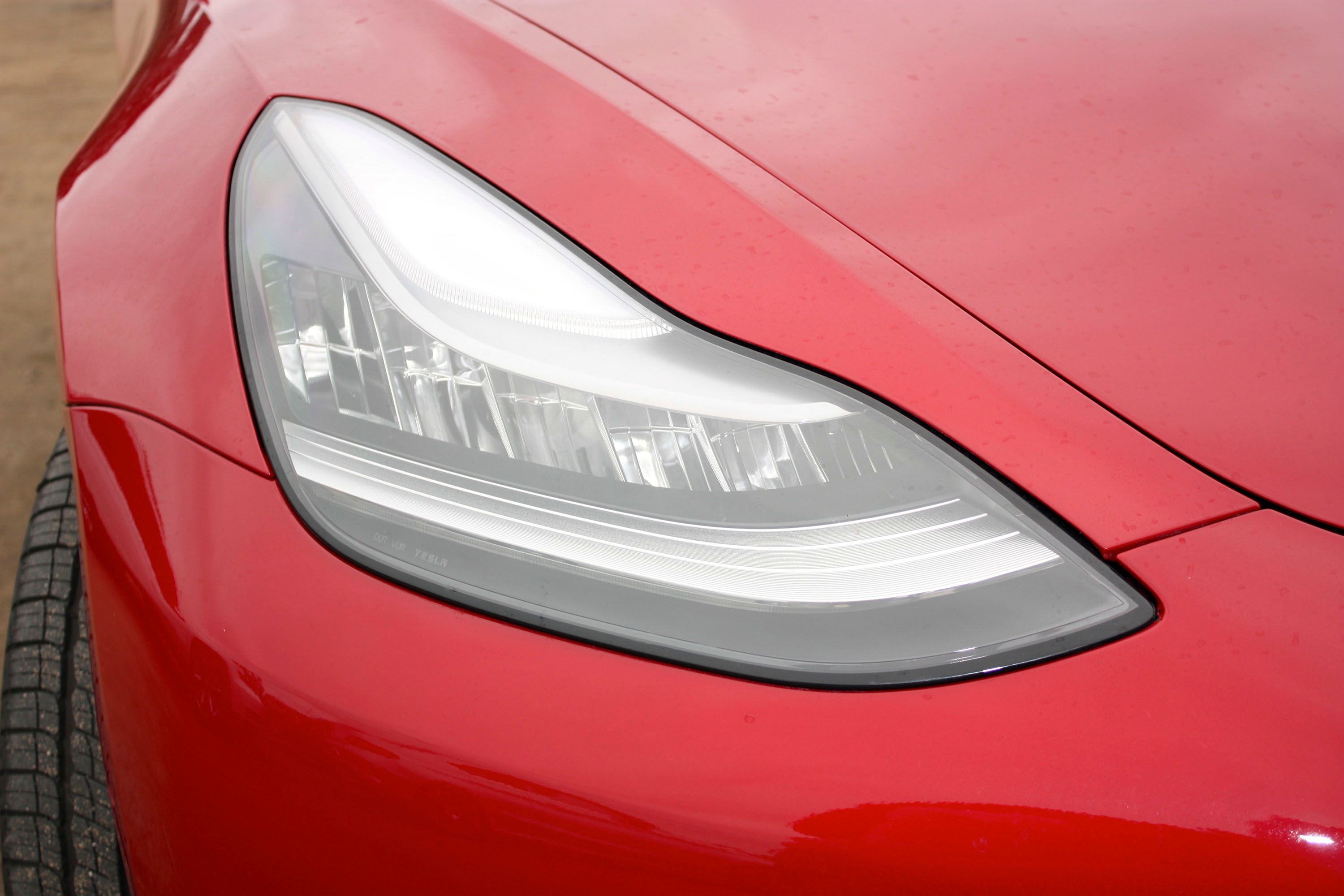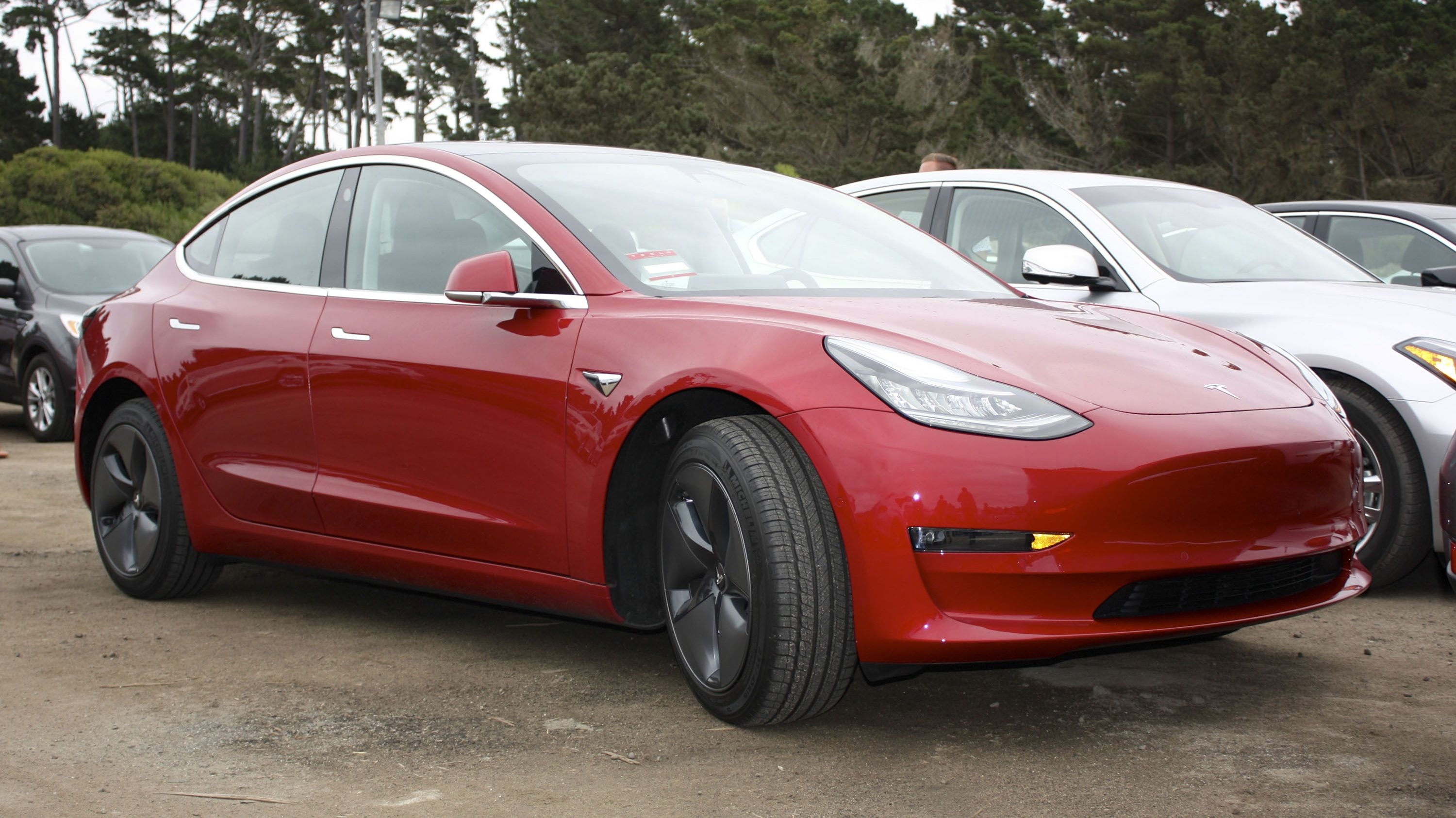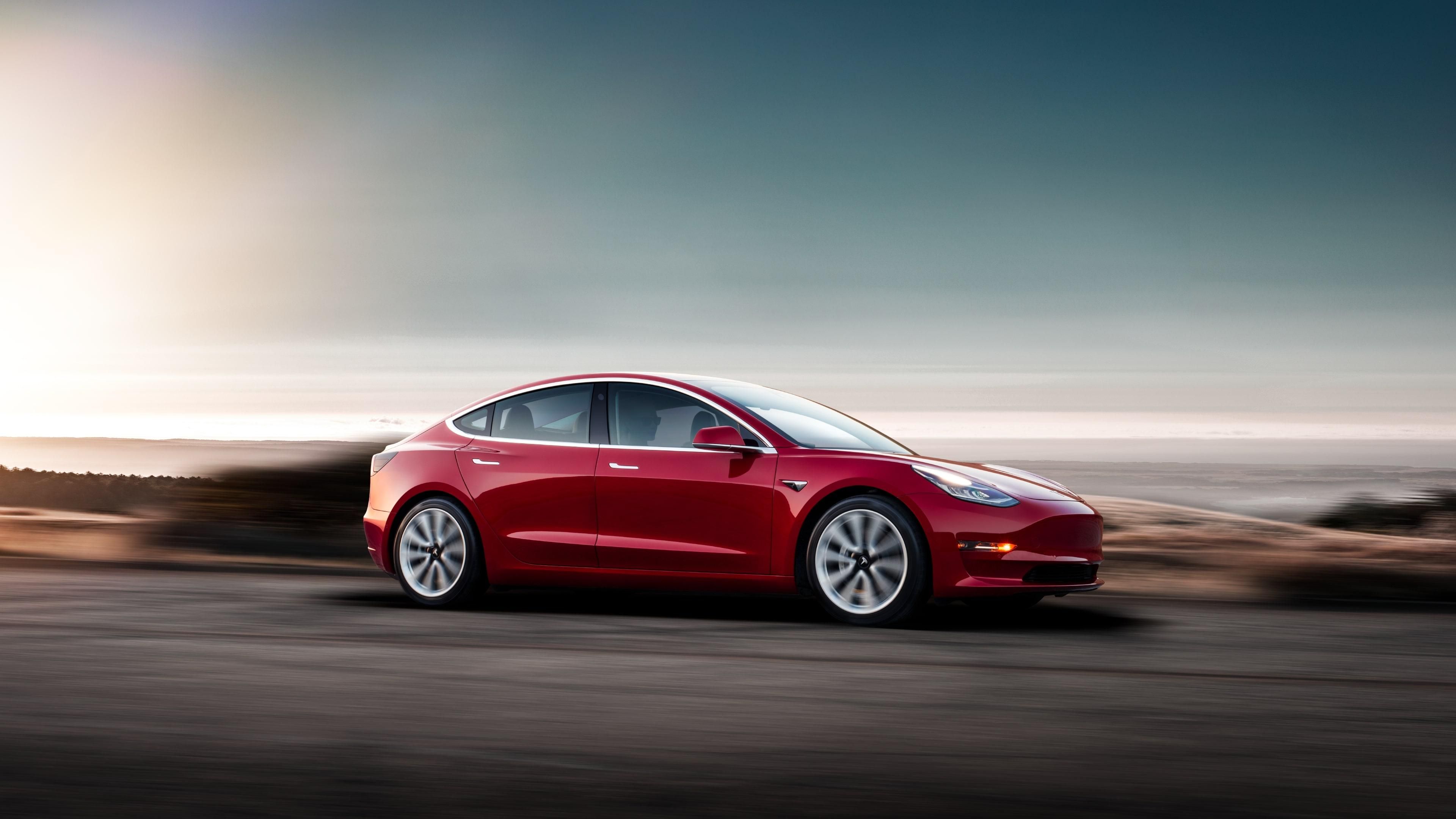Say what you will about Tesla – the company’s ambition is undeniable. Founded in 2003, the California-based electric carmaker set out with the goal of overturning the auto industry status quo and hastening “the world’s transition to sustainable energy.” To that end, Tesla’s latest play (and arguably its more important) is called the Model 3. Framed as a more affordable alternative to the highly successful Model S full-size sedan and Model X SUV, there’s no shortage of excitement behind the more compact 3, and now, after countless rumors and practically unending speculation, the veil has been lifted. Following a massive live streaming event celebrating the handover of the first Model 3’s off the production line, it was revealed that buyers get two trim levels to pick from, with as much as 310 miles per charge and a 0-to-60 mph time of 5.1 seconds for the range-topper.
But, as you might expect, there’s a whole lotta footnotes that go along with the above-mentioned specs. For starters, actually getting a Model 3 into your driveway is no simple endeavor. Following a brief pre-production reveal in April of 2016, an estimated 400,000 people plunked down $1,000 for a pre-order, and that means if you don’t have a spot in line, it’s gonna be a while. Then there’s the list of ultra-pricey extras that add significant weight to the bottom line. Simply put, the question remains – does the Model 3 live up to the hype? Read on to find out.
Updated 08/23/2017: We added a series of new images taken during the 2017 Monterey Car Week.
Continue reading to learn more about the Tesla Model 3.
2018 Tesla Model 3
- Make: Array
- Model: 2018 Tesla Model 3
- Horsepower: 300
- [do not use] Vehicle Model: Array
Exterior
At first glance, the Model 3 looks somewhat similar to the popular Model S, albeit smaller in terms of overall exterior dimensions. The automaker’s design language is what you’d expect, with sleek, simple lines, a rear-biased cabin, and a sporty, ground-hugging stance.
Additionally, the more compact Model 3 gets several interesting features that help it stand out in a crowd. One of the more intriguing details is the lack of a conventional front grille, with a broad, flat front end reminiscent of the Model X and the latest Model S design. The whole fascia is simplified, with very little in terms of embellishment or extra styling features. The only openings are in the lower bumper just above the bottom air dam. Sitting high on the nose is the Tesla “T” badge, moved from a central position on the bumper like on the S. A new headlight design leads the eye back towards Model S-like front fenders, with thin headlight graphics and daytime running lights adding a few extra visual layers. Short overhangs are found front and back.
Viewed in profile, the Model 3 stands out primarily thanks to its roofline, which appears to be both taller and more curved than its counterpart on the sleeker Model S. The design is said to provide a good deal of headroom for front and rear passengers, a feature enhanced even further when opting into the glass roof configuration. Go for the glass, and you’ll add a little less than an inch in headroom up front, plus a whole lot of extra natural light and blue-sky visuals all around.
Outfitted in the rear is a new taillight design that swoops into the rear fenders over boxy rear haunches. Acting as bookends for the new units are C-shaped housing graphics. The trunk itself gets a familiar curved line to it, although the chrome bar found on the S is missing from the 3. Once again, we find a cleaner look overall, with simpler (and if we’re honest, slightly less interesting) lines.
LED’s are used for lighting at both ends. Exterior paint options start with the Solid Black as standard, but for an extra thousand bucks, buyers can get theirs painted in a choice of five optional colors, such as Midnight Silver Metallic, Deep Blue Metallic, Silver Metallic, Pearl White Multi-Coat, and Red Multi-Coat. Wheel sizing is set at 18 inches as standard and come in an “Aero” design pattern. If you want the bigger 19-inch rollers in the Sport design, you’ll need to pony up an additional $1,500.
We think the 3 looks good, but the design is also quite functional. Tesla claims a drag coefficient of just 0.23, which is very, very low, even managing to beat the hugely efficient Toyota Prius (0.24).
All told, the Model 3 is the closest you’ll come to a “garden variety” Tesla, at least for now. It might not have the aggression of the Model S or the fancy gullwing doors of the Model X, but it’s still most definitely a Tesla, offering sleek styling and high efficiency all the same.
Competing Styles
When talking about affordable all-electric passenger vehicles, Chevy has a bit of a head start with the Bolt EV. Recently unveiled for the 2017 model year, the Bolt take a slightly different approach to bringing battery power to the masses, sporting a subcompact five-door hatchback body style compared to the lower, longer, and wider Model 3. The styling is somewhat reminiscent of the Honda Fit or BMW i3, and definitely fits well with traditional ideas of what an EV “should” be. Standout exterior features include LED lighting for the headlights and taillights, as well as matte black components, polished trim, and a healthy dose of weight-cutting aluminum, including alloy for the doors, tailgate, and hood.
And while it might not have an all-electric option just yet, word has it a BMW 3 Series EV is indeed in the works. In terms of styling, the 3 Series is much closer to the Model 3, getting those lower, wider, and longer exterior dimensions traditionally carried by smaller mid-size sedans. If BMW does drop a 3 Series EV (or rather, when BMW drops a 3 Series EV), look for the same beefy proportions as its ICE-powered equivalent, with round daytime running lights up front, handsome lines, and lots of chrome details.
Model 3 Exterior Specs
|
Length (inches): |
184.8 |
|
Width (inches): |
72.8 (76.1 with mirrors folded) |
|
Height (inches): |
56.8 |
|
Wheelbase (inches): |
113.2 |
|
Front track (inches): |
62.2 |
|
Rear track (inches): |
62.2 |
|
Ground clearance (inches): |
5.5 |
Interior
Inside the Model 3, we find Tesla taking an extremely smooth and simple approach to its layout, even for the traditionally uber-streamlined Tesla cabin designers. The cabin is so clean, it’s almost spartan in appearance, with almost no buttons, toggles, or switchgear to speak of. Passenger capacity is capped at five maximum, with two in front and three in back. The optional glass roof should add a nice dose of airiness to the whole affair.
Drivers grip a three-spoke steering wheel with a few thumb-length controls at the 3 and 9. Tesla says it’s only offering left-hand configurations for now – overseas buyers interested in getting a 3 in right-hand drive will have to wait until next year to place their order.
Standard features include textile (cloth) upholstery for the seating, as well as a back-up camera, auto dimming rear-view mirror, one-touch power windows front and back, and power-adjusting side-view mirrors. Dual-zone climate control keeps folks comfortable.
Without a doubt, 3’s biggest standout feature is the standard 15-inch touchscreen that dominates the dash. The size not only provides excellent views of whatever is on display, but also the space needed for all the user inputs traditionally made via the buttons and switches not equipped on the dash. Standard infotainment spec includes FM radio, Wi-Fi and LTE Internet connectivity, Internet streaming radio, onboard maps and navigation, voice-activated controls, and Bluetooth hands-free calling and media streaming. Keyless entry and remote climate control are provided by the Tesla mobile phone app. Twin USB ports are up front.
Storage can be found in the front center console, while the rear bench does a 60/40 split for enhanced practicality, plus there’s the frunk (front trunk) in the nose. A 12-volt power outlet provides juice as needed.
Drop an extra five grand, and you can get the Premium Upgrades Package, which throws in heated seats, unspecified higher-grade materials, a better stereo system, tinted glass for the roof, and LED fog lamps.
Competing Interiors
In terms of look and layout, the Bolt once gets a more traditional look than the Model 3, with simple greys and blacks for the upholstery and a smaller touchscreen integrated with the dash. The angles and cuts, however, look futuristic, complemented by blue ambient lighting and some metallic white trim placed here and there. Infotainment includes 4G LTE Wi-Fi, support for Apple CarPlay and Android Auto, an onboard wireless smartphone charger, and outboard cameras for a surround view perspective. The Bolt is also hugely practical, offering as much as 56.6 cubic feet of cargo room with the rear seats down (16.9 cubic feet with the seats up).
Meanwhile, the Bimmer should get tons of premium touches throughout. The look will be elegant and offer a better sense of “premiumness” compared to the Chevy and Tesla. Expect better materials, although it’s uncertain where pricing will land for the EV model – the nice stuff might cost a pretty penny. On top of the dash will be a screen for navigation and various infotainment features. A heads-up display and gesture control should also be included. There will be seating for up to five passengers, but cargo space will likely be less than that of the Chevy.
Model 3 Interior Specs
|
Front head room (inches): |
39.6 (standard roof), 40.3 (glass roof) |
|
Rear head room (inches): |
37.7 (standard roof), 37.7 (glass roof) |
|
Front leg room (inches): |
42.7 |
|
Rear leg room (inches): |
35.2 |
|
Front shoulder room (inches): |
56.3 |
|
Rear shoulder room (inches): |
54 |
|
Front hip room (inches): |
53.4 |
|
Rear hip room (inches): |
52.4 |
|
Seating capacity: |
5 |
|
Luggage capacity: |
15 cubic feet |
Drivetrain
As you might imagine, the Model 3’s overall powertrain specs are different between the standard model and the Long Range model.
Go for the standard Model 3, and you’ll get an EPA estimated max of 220 miles between charges. Plug it into a Tesla branded Supercharger, and you’ll get 130 miles of range in about 30 minutes. Alternatively, you can plug into an at-home charger with a 240-volt outlet for 30 miles of range per hour. In terms of performance, the standard Model 3 can do the 0-to-60 mph sprint in 5.6 seconds, and reach a top speed of 130 mph.
Then we have the Long Range, which offers, you guessed it, more range – 90 miles more to be exact, with an EPA estimated driving range of 310 miles. Plug it into a Supercharger, and you’ll get 170 miles every 30 minutes, or 37 miles per hour from a 240-volt source. Alternatively, you can turn that extra range into extra go as well, with the 0-to-60 mph sprint done in 5.1 seconds. Top speed for the Long Range is 140 mph.
For now, the Model 3 is offered exclusively with RWD, but a dual-motor AWD configuration might be offered some time next year. Following the release of an AWD Model 3 will be a high-performance version offering Model S-like acceleration, although Musk has admitted the Model S will continue to be the faster option, given it offers more space for more batteries.
Back to the Model 3. Standard equipment for keeping those batteries topped off includes a 240-volt NEMA 14-50 adapter, as well as a 120-volt NEMA 5-15 adapter and a J1772 public charging adapter for plugging into the Supercharger network. Tesla also tosses in a 20-foot mobile connector complete with storage bag.
Competing Drivetrains
While looking good and being comfy are both critical in this segment, it’s the electric power that makes the biggest difference. Making the Chevy go is a 60-kWh battery that provides enough juice to propel the Bolt for 238 miles between sessions at the plug. Speaking of which, plug it into a 240-volt source, and you’ll get max charge in roughly nine-and-a-half hours, or about 25 miles per hour. Hook up to a DC quick charge outlet, and you’ll see 90 miles of range in 30 minutes. Acceleration to 60 mph takes less than seven seconds, a solid performance for an electric motor that generates 200 horsepower and 266 pound-feet of torque.
The Bimmer’s powertrain is a much bigger question mark, given it has yet to make its official debut. However, once the EV’d 3 Series does drop, we’d expect roughly similar specs as the standard Model 3 and Chevy Bolt EV. That means 230 miles per charge and capability for DC quick charging. We’d also expect acceleration to 60 mph in the low six-seconds range. All the power will be routed to the rear to take advantage of the 3 Series’ well-polished chassis.
|
Tesla Model 3 standard performance and powertrain specs: |
|
|
EPA estimated range per charge: |
220 miles |
|
Charge time (Supercharger): |
130 miles in 30 minutes |
|
Charge time (240-volt source): |
30 miles in 1 hour |
|
Drive wheels: |
RWD |
|
0-to-60 mph time: |
5.6 seconds |
|
Top speed: |
130 mph |
|
Tesla Model 3 Long Range performance and powertrain specs: |
|
|
EPA estimated range per charge: |
310 miles |
|
Charge time (Supercharger): |
170 miles in 30 minutes |
|
Charge time (240-volt source): |
37 miles in 1 hour |
|
Drive wheels: |
RWD |
|
0-to-60 mph time: |
5.1 seconds |
|
Top speed: |
140 mph |
Suspension And Chassis
Finding a nice balance between weight and cost is a tricky thing for a car like the Model 3. On the one hand, you want it to be light as possible for performance, while at the same time, you wanna keep the price as affordable as you can. To that end, the Model 3 is made from a hybrid of steel and aluminum components.
The end result is a surprisingly lightweight vehicle (we’ll let you judge whether it’s affordable or not in the “Prices” section below). The standard Model 3 tips the scales at just 3,549 pounds, which is roughly the same curb weight as Tesla’s much smaller competitor, the Chevrolet Bolt EV (3,563 pounds). Meanwhile, the Long Range Model 3 adds a little more heft at 3,814 pounds.
All told, the Model 3 should be a pretty fun car to drive. Not only does it offer great low-end torque from its electric motor set-up, but the weight is placed low on the chassis and distributed 47 percent in front and 53 percent in back (the Long Range model is slightly more even at 48 percent front and 52 percent in the rear). Helping it attack the corners is a double wishbone suspension, with a virtual steer axis in front with coil over twin-tube shocks and a stabilizer bar. Meanwhile, the rear is an independent multi-link set-up, also with twin-tube shocks and a stabilizer bar. Making it change direction is a variable ratio speed-sensitive electric power steering set-up, while standard all-season tires handle the rubber duties.
Competing Suspension And Chassis
The Bolt routes all of its power to the front, which means its got the same nose-dragging handling you would expect from a set-up like that. However, according to our friends over at Edmunds, the steering is light and relatively effortless, but the brake pedal gets a relatively long travel. Overall, the feeling is competent, and it gets the job done – almost like a minivan, in certain respects.
The Bimmer should be a more interesting ride. We’re thinking the all-electric powertrain would be a good complement to the RWD chassis and layout. Weight might be a bit of an issue, as the high levels of luxury extras and the battery pack will add significant heft, but BMW has a ton of history making heavy cars handle well, so we think it’ll all even out.
|
Tesla Model 3 suspension and chassis specs: |
|
|
Construction: |
aluminum and steel hybrid |
|
Suspension set-up: |
double wishbone (front), multi-link (rear) |
|
Steering: |
variable ratio electric power assist |
|
Weight distribution (standard): |
47 percent front, 53 percent rear |
|
Weight distribution (Long Range): |
48 percent front, 52 percent rear |
Safety
The Model 3 gets all the usual standard safety tech you’d expect. The means six front row airbags and two side curtain airbags, plus the traditional three-point safety belts and rear LATCH attachments. Electronic stability control and traction control are both standard, as are the four-wheel disc brakes with ABS and electronic parking brake. Child safety locks, an anti-theft alarm, and a tire pressure monitoring system round it out.
What’s more, Tesla expects the highest possible crash test ratings, even going so far as to compare the all-electric sedan to the Volvo S60 in a crash test video during the July handover party.
What’s more, the Model 3 comes equipped with the equipment required for fully autonomous operation. This includes eight visual cameras, a forward radar array, and 12 ultrasonic sensors, blessing the Model 3 with high-tech features like collision avoidance and automatic emergency braking, both of which come as standard.
Go for the Enhanced Autopilot package for an extra five grand, and you get even more tech, such as adaptive cruise control, lane change assist, and lane-keep assist. Tesla says even more features will be offered in future software updates.
Finally, there’s the Full Self-Driving Capability feature for another $3,000 (added on top of the Enhanced Autopilot). As of this writing, it’s uncertain how this will be implemented, but Tesla is adamant it’ll see use, saying, “In the future, Model 3 will be capable of conducting trips with no action required by the person in the driver’s seat.”
Competing Safety
Keeping the Bolt safe is Chevy’s own lineup of tech-heavy assists, including lane-departure warning, collision avoidance, blind-spot warning, parking assist, and a teen driver mode as well. These are all in addition to the standard airbag system and self-sealing Michelin tires, plus a Top Safety Pick designation from the Insurance Institute for Highway Safety (IIHS).
Meanwhile, we’d expect similar tech from the BMW – for a price, of course. The standard spec will get the usual airbags, traction control, and tire pressure monitor systems, but the autonomous systems will most likely come with certain optional packages. The crash ratings should all be top notch, and we’d also expect the 3 Series to get a Top Safety Pick from the IIHS.
Prices
Pricing for the standard Model 3 is set at $35,000 before incentives. Pricing for the Long Range adds an extra $9,000 to the base price, for $44,000 before incentives.
Tesla is also offering a warranty for the Model 3, with the vehicle getting a four-year / 50,000-mile limited warranty. Meanwhile, the battery gets an 8-year / 100,000-mile warranty. Go for the Long Range model, and the battery warranty goes up to 120,000 miles.
Deliveries for the Model 3 began on July 28th, 2017, in a live streaming event that saw the first 30 units off the production line go to select Tesla employees. Reservations are currently being accepted, although new orders are estimated to take at least a year to reach customers. Indeed, Tesla is ramping up to meet demand by way of “production hell” over the next six months, so unless you’ve got a spot in line with a pre-order, don’t expect to see your Model 3 any time soon.
Competing Pricing
For the moment, the Chevrolet Bolt EV starts at $37,495 before options, making it a bit more expensive than the base Model 3. Higher trim levels offering improvements to the tech equipment, convenience features, comfort features, and upholstery can be had for extra outlay if desired.
Read our full written review on the Chevrolet Bolt EV.
As for the BMW equivalent, we’d expect a base model 3 Series EV to slot in at around $45,000, similar to the Long Range Tesla Model 3. That price might be a bit of a reach, but if BMW does cut a few grand from the top, expect to pay for it in the options list.
Read our full written review on the BMW 3 Series.
|
Tesla Model 3 options: |
|
|
Exterior paint options: |
Solid Black (standard), Midnight Silver Metallic ($1,000), Deep Blue Metallic ($1,000), Silver Metallic ($1,000), Pearl White Multi-Coat ($1,000), and Red Multi-Coat ($1,000) |
|
Wheel options: |
18-inch Aero design (standard), 19-inch Sport design ($1,500) |
|
Premium Upgrades Package ($5,000): |
adds components to the exterior and interior, including premium heated seats, upgraded cabin materials, open pore wood trim, two rear USB ports, 12-way adjustable front seats, custom power adjustable driver profiles for the front seats, steering column, and side-view mirrors, premium audio (more power, plus new tweeters, surround speakers, and a subwoofer), tinted glass for the roof, auto-dimming, power-folding, and heated side-view mirrors, LED fog lights, and center console with covered storage and docking for two smartphones |
|
Enhanced Autopilot Package ($5,000): |
adds safety and convenience features, including adaptive cruise control, lane-keep assist, automatic lane change, freeway-to-freeway transition and exit, and self-parking |
|
Full Self-Driving Capability ($3,000, requires Enhanced Autopilot Package): |
will enable full autonomous driving capability some time in the future |
Other Competitors
Nissan Leaf
Elon Must initially announced the Tesla Model 3 as a competitor for the popular Nissan Leaf, claiming that the car will have a similar price, but offer better range and superior technology. The Leaf was redesigned for the 2018 model year, gaining a sportier exterior design, a fresh-looking, techy interior, and a revised drivetrain. The new motor cranks out 147 horsepower and 236 pound-feet of torque, which is a 40-horsepower and 49-pound-feet increase over the old model. However, that's significantly less than what the Model 3 promises to deliver, as well as less than the Bolt's 200-horsepower rating. The range is also superior to the previous Leaf, but below the Bolt at up to 150 miles on a single charge. Charging takes 16 hours with a 3kW outlet and only eight hours with a 6-kW outlet. On the other hand, pricing starts from $29,990 before Government rebates, making it more affordable than the competition.
Read our full review of the 2018 Nissan Leaf.
Hyundai Ioniq Electric
The Hyundai Ioniq was launched in 2016 as a hybrid competitor for the Toyota Prius, but the Korean automaker also developed an all-electric version. Virtually identical to the hybrid model design-wise, the Ioniq Electric boasts a sporty exterior and hatchback layout that's similar to the Chevy Bolt and Toyota Prius. The interior looks upscale, despite the affordable price tag and the Hyundai badge. As far as output goes, the Ioniq Electric is significantly less powerful than every car in this comparison, with its single motor rated at 118 horsepower and 217 pound-feet. Likewise, the battery returns up to 155 miles on a single change, which makes it slightly superior to only the Nissan Leaf. On the other hand, the Ioniq Electric is the most affordable of the bunch with a sticker set at $29,500 before incentives.
Read our full story on the 2017 Hyundai Ioniq Electric.
Conclusion
There are some things that Tesla does very, very well. For starters, it gets people excited – whether you’re for or against the so-called EV revolution, you can’t ignore the waves Tesla is making. Then there’s the specs – when it comes to driving range, charge times, performance, and autonomous technology, Tesla always seems to be one step ahead of the competition.
The Model 3 is a perfect example of all these things. However, the 3 is definitely not perfect. The interior looks a bit oversimplified, and that enormous screen on the dash could get pretty distracting. Then there’s the price - $35,000 is a great starting point, but buyers will most likely tack on at least an extra $5,000 in options to get the right gear. The autonomous systems are also a bit of a question mark – how exactly will the $3,000 Full Self-Driving Capability package pan out? We just don’t know yet.
That said, the 3 is already a smash hit success. Literally hundreds of thousands of eager buyers are counting down the days when they’ll finally get their hands on one, and the competition must constantly maneuver around what Tesla is doing to stay in the game.
All we’ve gotta say is – well done.
very0}
Read our full review on the Tesla Model S.
Read our full review on the Tesla Model X.
Updated History
Updated 08/01/2017: We’ve updated this review with all the latest info and a list of competitors. Check it out!
Updated 06/12/2015: A new report suggests that the future-generation Tesla Model III will deliver a driving range of at least 250 miles.
Updated 07/23/2014: We prepared a rendering for the future Tesla Model III. Check it out after the jump.

